lordroel
Administrator
Member is Online
Posts: 68,022 
Likes: 49,423
|
Post by lordroel on Feb 24, 2024 15:01:44 GMT
Day 1993 of World War II, February 24th 1945YouTube (Iwo Jima) Eastern FrontThe Soviet 2nd Belorussian Front (Rokossovsky) begins a new offensive in the morning with a 30-minute artillery barrage. The 1st Ukrainian Front's campaign in Lower Silesia comes to an end after crossing Neisse river. A German counter attack wipes out the Russian Hron bridgehead over the Danube to the northwest of Budapest. VI SS Panzer Army forces Soviets back across the Hron river in Hungary. Colonel Ivan Kojedub, the top scoring Soviet (and Allied) fighter ace (with 62 victories), shoots down a German Me262 over Berlin. Western Front (1945) - Western Allied invasion of GermanyMap: HQ Twelfth Army Group situation map, February 24th 1945 To the north, attacks by British and Canadian continue to drive southeast toward Udem and Weeze. Julich is captured by units of the US 19th Corps as the US 9th Army begins to extend its advance over the Roer River. To the south, the US 1st and 3rd Armies also push forward. Photo: Tank destroyers of Company B of the 644th Tank Destroyer Battalion (attached to the 8th Infantry Division, U.S. First Army) are the first allied armored group to enter the battered German city of Duren on February 24, 1945 Photo: Tank destroyer moves up to support an infantry attack on German assembly point on outskirts of Julich, Germany. 24 February, 1945 Photo: Tank destroyer moves up to support an infantry attack on German assembly point on outskirts of Julich, Germany. 24 February, 1945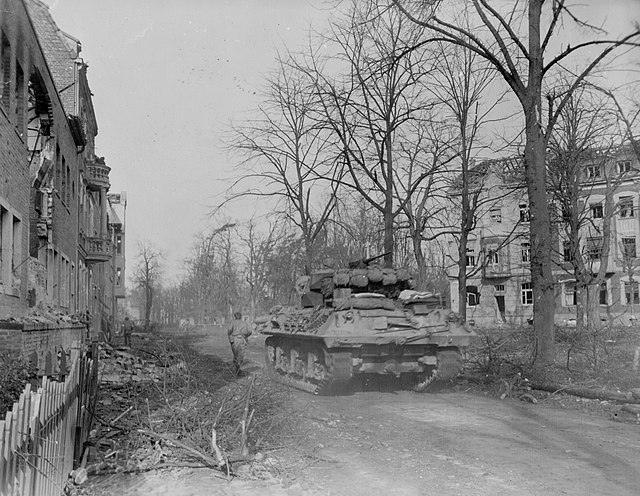 Photo: A 9th U.S. Army tank-dozer moves up into Julich, Germany, after crossing the Roer River. 24 February, 1945 Photo: A 9th U.S. Army tank-dozer moves up into Julich, Germany, after crossing the Roer River. 24 February, 1945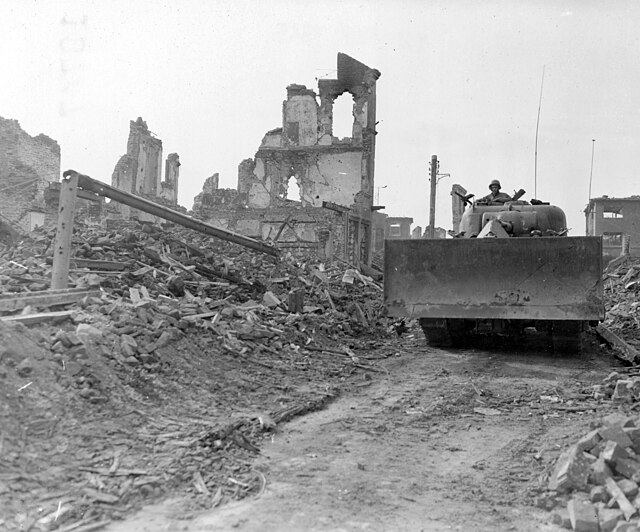 Photo: Infantrymen of the 8th Division, U.S. First Army, await orders to advance and clean out a building in Duren, Germany, occupied by about 30 or 40 Germans. 24 February, 1945 Photo: Infantrymen of the 8th Division, U.S. First Army, await orders to advance and clean out a building in Duren, Germany, occupied by about 30 or 40 Germans. 24 February, 1945 Air War over Europe Air War over Europe 74 RAF training aircraft on a diversionary sweep over Northern France to draw German fighters into the air, 63 Mosquitos to Berlin, 18 to Neuss and 3 on 'siren tours' of Dessau, Erfurt and Halle, 37 RCM sorties, 23 Mosquito patrols, 35 Lancasters minelaying in the Kattegat and off Norwegian ports. 5 RCM aircraft - 4 Halifaxes and 1 Fortress - lost; these aircraft were operating in association with the diversionary sweep of training aircraft and were probably victims of German fighters drawn up by that sweep. The 4 lost Halifaxes were all from No 462 (Australian) Squadron, based at Foulsham; they had been sent ahead of the diversionary force to drop Window, bombs and incendiaries in a 'spoof' raid on the Ruhr. (US Fifteenth Air Force): 500+ B-17s and B-24s (with fighter escorts) attack the Udine, Padua, Verona, and Ferrara marshalling yards and Ferrara railroad bridge in Italy; marshalling yards at Graz and Klagenfurt, Austria; and several targets of opportunity. During the previous night 20 B-24s continue supply drops in N Italy. (US Twelfth Air Force): In Italy during the night of 23/24 Feb, A-20s bomb marshalling yards, including those at Castelfranco Veneto, Rovereto, Villafranca di Verona, and Legnago, and airfields at Villafranca di Verona, Ghedi, and Bergamo; medium bombers bomb rail lines, bridges, bridge approaches, and fills at Bozzolo, Santa Margherita d'Adige, San Michele all'Adige, Pizzighetone, and Lavis, and severely damage the Sesto Calende industrial complex; fighter-bombers hit communications, mainly airfields, railroad bridges, lines, and marshalling yards at several points including Villafranca, Calliano, N of Nervesa della Battaglia, N of Santa Margherita d'Adige, Bergamo, Pavullo nel Frigano, Isola della Scala, and Motta di Livenza; fighters and fighter-bombers support US Fifth Army forces, hitting gun positions in advance of the battlefront, at Montese and E of Modena, and blast targets in the battle area as the 10th Mountain Division reaches the summit of Monte Torraccia. (US Eighth Air Force): 2 missions are flown. Mission 845: 1,114 bombers and 592 fighters are dispatched to hit oil refineries and rail targets using H2X radar; they claim 1-0-3 Luftwaffe aircraft on the ground; 2 bombers and 11 fighters are lost: 1. 362 B-17s are sent to hit the Albrecht (278) and Harburg (70) oil refineries at Hamburg; 6 others hit a target of opportunity; 26 B-17s are damaged; 2 airmen are WIA. 181 of 195 P-51s escort; 4 are lost (pilots MIA). 2. 280 B-24s are dispatched to hit the Misburg oil refinery (104) and the marshalling yard at Lehrte (61); 76 hit the secondary target, the marshalling yard at Bielefeld; targets of opportunity are Hannover (11), Lingen (2) and other (5); 1 B-24 is lost, 1 damaged beyond repair and 16 damaged; 4 airmen are KIA, 3 WIA and 12 MIA. Escorting are 166 of 179 P-51s; 5 are lost (pilots MIA). 3. 383 B-17s are sent to hit the Deschimag U-boat yards at Bremen (200) and the Bremen W rail bridge (134); targets of opportunity are Minden (12), Osnabruck (8), Quackenbruck (5) and Brinkum (1); 1 B-17 is lost, 1 damaged beyond repair and 162 damaged; 7 airmen are WIA and 9 MIA. The escort is 93 of 98 P-51s; they claim 1-0-3 aircraft on the ground; 2 P-51s are lost (pilots MIA). 4. 70 of 76 B-17s hit the Wesel rail bridge using Micro H; 22 B-17s are damaged. 29 P-51s escort without loss. 5. 12 of 13 B-17s fly a screening mission. 6. 43 of 46 P-51s fly a freelance mission for the bombers without loss. 7. 28 P-51s fly a scouting mission. 8. 17 P-51s escort 19 F-5s and 4 Spitfires on photo reconnaissance missions over Germany. Mission 846: 12 B-24s drop leaflets in the Netherlands and Germany during the night. (US Ninth Air Force): In Germany, nearly 500 B-26s, A-20s and A-26s hit 5 communications centers, 2 marshalling yards, 3 rail bridges, 6 town areas, and a target of opportunity as part of interdiction operations against troops during the Rhineland campaign; fighters support the 8th and 104th Infantry Divisions in the Duren area, the XIII and XIX Corps at the Roer River bridgehead area, and the VIII, XII, and XX Corps E of and along the Prum River and in the Saarlautern area. Kamen: 340 RAF aircraft - 290 Halifaxes, 26 Lancasters, 24 Mosquitos - of Nos 4, 6 and 8 Groups. 1 Halifax lost. The target was a synthetic-oil plant which was actually in Bergkamen, just north of Kamen. The target area was covered by cloud and the raid was based on Oboe and H2S markers. 166 RAF Lancasters and 4 Mosquitos of No 5 Group were ordered to abandon a raid on the Dortmund-Ems Canal without bombing because of cloud which covered the target area. All aircraft landed safely. Italian campaign In Italy, US 5th Army takes La Serra and summit of Monte Torraccia. US 12th Air Force aircraft attack large number of transportation targets in northern Italy and provide direct support for US 5th Army operations around Montese, Modena, and Monte Torraccia. US 15th Air Force attacks Ferrara, Padua, Udine, and Verona. Battle of the AtlanticGerman submarine 'U-1208' sunk in the English Channel south-east of Isles of Scilly, in position 49.51.783N, 06.06.750W, by depth charges from the British frigates HMS 'Duckworth' and HMS 'Rowley'. On the same day "U-327" was detected by a USN liberator and sunk by HMS "Loch Fada",working with HMS "Labuan" and HMS "Wild Goose". German submarine 'U-927' sunk in the Channel, south-east of Falmouth, in position 49.45N, 04.45W, by depth charges from a British Warwick aircraft (Sqdn. 179/V). 47 dead (all hands lost). German submarine 'U-3007' sunk near Bremen, by bombs. Wreck broken up. 1 dead, unknown number of survivors. Arctic Naval operationsOff the northern coast of Norway, German U-boats sink 8 ships and 2 destroyers of a convoy bound for the Soviet port of Murmansk. EgyptEgypt declared war on Germany and Japan. Afterwards, as the Prime Minister of Egypt Ahmad Maher Pasha walked down the halls of parliament, he was assassinated by an Egyptian nationalist furious at this 'capitulation' to British influence. Germany Hitler makes what will be his last speech to Reischsleiters and Gauleiters in the Chancellery in Berlin, Germany. Pacific War CHINA (Fourteenth Air Force): 5 B-24s on individual sweeps over the S China Sea and Gulf of Tonkin claim 4 vessels sunk. (Twentieth Air Force): Mission 38: In an all-incendiary attack, 105 of 116 B-29s hit the Empire Dock area at Singapore, Malayan States, burning out about 40 per cent of the warehouse area; 1 B-29 is lost; this is the last 100-aircraft strike by the XX Bomber Command. HQ 58th Bombardment Wing (Very Heavy) and HQ 468th Bombardment Group (Very Heavy) begin a movement from the Hijli Base Area and Kharagpur respectively to the Marianas. Japanese report: Penang and Singapore were attacked, one B-29 was smoked on left wing and was last seen heading to Malacca Strait, it will not make it. INDIA-BURMA (Tenth Air Force): In Burma, 8 P-47s in close support of the ground forces near Lashio pound vehicle and a troop concentration; 12 B-25s and about 125 fighter-bombers strike against targets immediately behind the lines, hitting troops, supply areas, occupied towns and villages, vehicles, and general targets of opportunity. Transports complete 600 sorties carrying men and supplies to forward areas. BURMA In their advance on Meiktila, the British 17th Indian Division takes Taungtha. PALAU (Seventh Air Force): 28 B-24s from Angaur Airfield bomb Ising on Mindanao . 3 B-24s on armed reconnaissance from Guam bomb the airfield on Marcus in the N Pacific. During the night of 24/25 Feb, 5 B-24s out of Guam fly individual snooper strikes against the airfield on Chichi Jima and the town of Okimura on Haha Jima . SOUTHWEST PACIFIC AREA [Far East Air Force]: B-25s sweep off the China coast, bombing the naval base at Ryukyu-Sho, Formosa. PHILIPPINE CAMPAIGN (1945) On Luzon, American forces eliminate desperate Japanese resistance in the Intramuros -- the old walled quarter of Manila. On Luzon, strikes in support of ground forces continue, especially W of Ft Stotsenburg; fighter-bombers attack forces holding out on Corregidor; B-24s bomb Sepinggaiig and Manggar Airfields. The 20th Combat Mapping Squadron, 6th Photographic Reconnaissance Group, based at Dulag begins operating from San Jose with F-7s. The 390th Bombardment Squadron (Medium), 42d BG (Medium), based at Sansapor begins operating from Morotai with B-25s. VOLCANO AND RYUKYU ISLANDS CAMPAIGN On Iwo Jima, forces of US 5th Amphibious Corps continue to advance northward and capture part of the island's second airfield. Photo: Section chief Marine Private First Class R.F Callahan calls for fire and another 155 mm shell is hurled into a Japanese position Photo: Marines blast Jap positions near the base of Suribachi on Iwo Jima. 24 February, 1945 Photo: Marines blast Jap positions near the base of Suribachi on Iwo Jima. 24 February, 1945 Off Iwo Jima, destroyers Heywood L. Edwards (DD-663) and Bryant (DD-665) are damaged by collision, 24°47'N, 141°25'E; heavy weather damages destroyer Moale (DD-693), 25°00'N, 141°00'E, and medium landing ships LSM-202 and LSM-241. Tank landing ship LST-792 is damaged by shore battery fire, 24°46'N, 141°19'E. Operational casualties account for damage to high speed minesweeper Howard (DMS-7) and submarine chaser SC-1027. Photo: The U.S. Navy destroyer USS Helm (DD-388) comes alongside the escort carrier USS Makin Island (CVE-93) during the Iwo Jima operation, 24 February 1945. Helm is painted in Camouflage Measure 31, Design 1D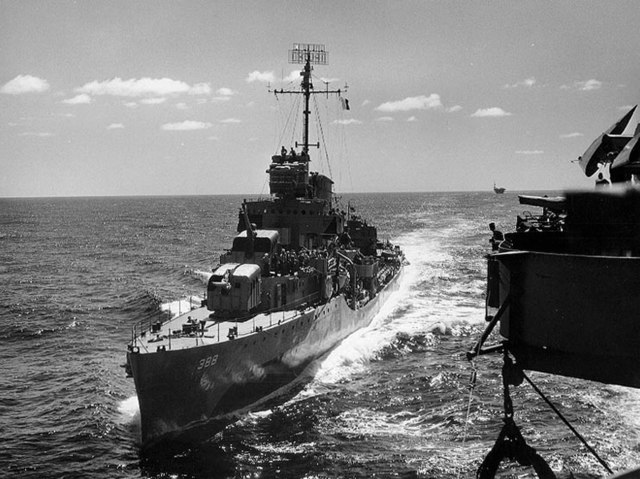 Photo: The U.S. Navy destroyer USS Hutchins (DD-476) underway at sea on 24 February 1945. The photo was taken from the escort carrier USS Makin Island (CVE-93) Photo: The U.S. Navy destroyer USS Hutchins (DD-476) underway at sea on 24 February 1945. The photo was taken from the escort carrier USS Makin Island (CVE-93) ALASKA (Eleventh Air Force): 4 B-25s on a shipping sweep attack the Hayakegawa River in the Kurile ; returning, the B-25s sight and photograph a Japanese bomb-carrying balloon. UNITED STATES NAVY DEPARTMENT COMMUNIQUES, CINCPOA COMMUNIQUÉ NO. 276, FEBRUARY 24, 1945 The battle for the airfield in the central area of Iwo Island continued on February 24 (East Longitude Date) with no marked changes in the lines at noon. The Marines holding a line on the Southwestern end of the airdrome and south of the center of the field launched an attack supported by tanks in the morning after our artillery aircraft and fleet surface units had subjected the enemy to heavy bombardment. By noon our forces were reported to be gaining ground slowly. Enemy resistance is heavy. Marine patrols entered Suribachi Crater during the day and continued to mop up remnants of the garrison of that strong point. Two enemy aircraft approached the island on February 23 but retired without attacking. Conditions on the beaches are generally improved and the unloading of general cargo is proceeding. UNITED STATES NAVY DEPARTMENT COMMUNIQUES, CINCPOA COMMUNIQUÉ NO. 277, FEBRUARY 24, 1945 Elements of the Third, Fourth and Fifth Marine Divisions made substantial advances along the whole northern sector on Iwo Island on February 24 (East Longitude Date). Their attack was made in the face of intense fire from heavy weapons and rockets but it carried northward generally about 308 to 500 yards through a maze of interlocking, or mutually supporting concrete pillboxes, blockhouses and fortified caves. All areas crossed were heavily mined. By 1800, our units had reached the middle area of the central Iwo airfield, had pushed forward several hundred yards on the west and had begun a drive which expanded our beachhead northward along the east coast about 600 yards. In every zone of the fighting, the enemy resisted our advance to the full extent of his armament. Weapons of the "bazooka" type were employed against our tanks and the use of rocket bombs, weighing about 500 kilograms, continued. Enemy positions in the area through which our units advanced were generally reinforced blockhouses and pillboxes with four‑foot bulkheads. In a single area of about 400 by 600 yards on the east coast, our forces neutralized about 100 caves between thirty and forty feet deep. An immediate result of the advance was apparent in a marked decrease of enemy artillery fire into the interior of the area under our control. The attack was supported by marine artillery and by fire from heavy units of the fleet standing off Iwo Island. Carrier aircraft continued their close support of the troops and also made an attack on Chichi Jima in the Bonins. In the south, Marines continued their mop up of enemy strong points in and around Mount Suribachi. Incomplete reports indicate that 115 enemy emplacements have been destroyed in that sector. A total of 2,799 enemy dead have been counted on Iwo Island. The condition of the beaches showed marked improvement and unloading of supplies was accelerated. Seventh Army Air Force Bombers of the Strategic Air Force, Pacific Oceans Areas, bombed the airfield and Omura town on Chichi Jima and Okimura town on Haha Jima in the Bonins on February 22. On February 23, Marine fighters attacked targets in the Palaus. Army Thunderbolts strafed enemy positions on Pagan in the Marianas on the same date. Fighters of the Fourth Marine Aircraft Wing set a fuel dump afire and struck motor transport equipment in the Palaus on February 24. Navy search Venturas of Fleet Air Wing One bombed the enemy airstrip on Puluwat in the Carolines on February 24. Neutralizing raids were continued by search aircraft of Fleet Air Wing Two on enemy‑held bases in the Marshalls on February 23. UNITED STATES NAVY DEPARTMENT COMMUNIQUES, CINCPOA COMMUNIQUÉ NO. 278, FEBRUARY 24, 1945 Carrier aircraft of the Fifth Fleet are attacking military, naval and air installations in and around Tokyo. Admiral R. A. Spruance, U. S. Navy, is present in command of the Fifth Fleet and Vice Admiral Marc A. Mitscher, U. S. Navy, is in tactical command of the fast carrier task force, making the attack. PACIFIC Submarine Lagarto (SS-371) sinks Japanese submarine I 371 and merchant cargo ship Tatsumomo Maru off Bungo Suido, Kyushu, 32°40'N, 132°33'E. Submarine Trepang (SS-412) sinks Japanese merchant cargo ship Uzuki Maru north-northeast of Mikizaki, 32°40'N, 132°33'E. Japanese cargo vessel Kyuryu Maru is damaged by mine (laid by RAF planes) off Bangkok, Thailand 13°45'N, 100°35'E; she is later abandoned as a total loss and scuttled. Japanese escort destroyer Nomi is damaged by aircraft, four miles south of Wanshan Island. Japanese merchant cargo ship Yulin Maru sinks after running aground near Qui Nohn, French Indochina, 13°48'N, 109°14'E.
|
|
lordroel
Administrator
Member is Online
Posts: 68,022 
Likes: 49,423
|
Post by lordroel on Feb 25, 2024 7:29:41 GMT
Day 1994 of World War II, February 25th 1945Eastern Front German 1st Battalion of the 26th Parachute Regiment lands in Breslau, to help defend the city. Western Front (1945) - Western Allied invasion of GermanyMap: HQ Twelfth Army Group situation map, February 25th 1945 Duren is taken by the US 7th Corps (part of US 1st Army). Other bridgeheads over the Roer River have been captured to north and south of Duren and they are rapidly being extended. To the south, on the right flank of US 3rd Army, crossings over the Saar have also been made near Saarburg. Photo: Churchill tanks passing through Goch, 25 February 1945 Photo: Infantry and universal carriers of 53rd (Welsh) Division passing through Goch, 25 February 1945 Photo: Infantry and universal carriers of 53rd (Welsh) Division passing through Goch, 25 February 1945 Photo: Three First U.S. Army infantrymen take cover from enemy shellfire in a bomb crater in the marshalling yards in Northeast Duren, Germany. 25 February, 1945 Photo: Three First U.S. Army infantrymen take cover from enemy shellfire in a bomb crater in the marshalling yards in Northeast Duren, Germany. 25 February, 1945 Photo: Four infantrymen of Company F, 413th Regiment, 104th Division, First U.S. Army, pose with a captured German 81mm mortar that they used to knock out a German 85mm gun near Duren, Germany, 25 February, 1945 Photo: Four infantrymen of Company F, 413th Regiment, 104th Division, First U.S. Army, pose with a captured German 81mm mortar that they used to knock out a German 85mm gun near Duren, Germany, 25 February, 1945 Western Front (1945) - Liberation of BelgiumPhoto: Members of the 9th Armored Division, 3rd U.S. Army looking at a sign about the Russian army. 25 February, 1945. Sprimont, Belgium Western Front (1945) - Liberation of BelgiumPhoto: Members of the 9th Armored Division, 3rd U.S. Army looking at a sign about the Russian army. 25 February, 1945. Sprimont, Belgium Air War over Europe Air War over Europe (US Eighth Air Force): 2 missions are flown. Mission 847: 1,197 bombers and 755 fighters are dispatched to hit tank factories, airfields associated with jet aircraft, oil depots and rail targets visually; they claim 34-0-21 Luftwaffe aircraft; 5 bombers and 8 fighters are lost: 1. 377 B-17s are sent to hit the Maybach tank factory at Friedrichshaffen (63) using Gee-H, and the station and marshalling yard (73) and oil storage tanks and marshalling yard (174) at Munich; 51 hit the secondary target, the marshalling yard at Ulm; 1 other hit Kenzingen, a target of opportunity; 2 B-17s are lost, 1 damaged beyond repair and 135 damaged; 1 airman is KIA, 2 WIA and 18 MIA. Escorting are 136 of 149 P-51s; they claim 1-0-2 aircraft on the ground; 2 P-51s are lost (pilots MIA). 2. 452 B-17s are dispatched to hit the marshalling yard at Munich (315) and Neuburg (88); targets of opportunity are Kaufbeuren (13), Ludwigsfeldt marshalling yard (12), Kempten (1), Durladingen (2), Rortwell (1) and other (5); 3 B-17s are lost, 1 damaged beyond repair and 197 damaged; 1 airman is KIA, 3 WIA and 27 MIA. 140 of 145 P-51s escort and claim 2-0-3 aircraft on the ground. 3. 368 B-24s are sent to hit the marshalling yard (115) and tank factory (54) at Aschaffenburg and the airfields at Giebelstadt (96) and Schwabishch Hall (93); 1 B-24 is damaged beyond repair and 31 damaged; 3 airmen are KIA and 6 WIA. The escort is 126 of 135 P-51s. 4. 262 P-47s and P-51s fly close escort and area patrols claiming 21-0-4 aircraft in the air and 10-0-12 on the ground; 6 P-51s are lost (pilots MIA) and 1 P-47 is damaged beyond repair. 5. 8 P-51s escort 4 F-5s on a photo reconnaissance mission over Germany. 6. 32 of 34 P-51s fly a scouting mission. Mission 848: 12 B-24s drop leaflets in France, the Netherlands and Germany during the night. (US Ninth Air Force): In Germany, the 9th Bombardment Division strikes 4 rail bridges, 4 communications centers, a marshalling yard and 9 targets of opportunity as part of the interdiction campaign against Germany; fighters escort the bombers, attack assigned ground targets, fly armed reconnaissance, and support the 8th and 104th Infantry Divisions in the Duren area, the XIII and XlX Corps E of the Roer River, and the VIII, XII, and XX Corps along the Prum and Saar Rivers. (US Fifteenth Air Force): In Austria, 600+ B-17s and B-24s bomb marshalling yards in Amstetten, 2 in Linz, 2 in Villach, and Salzburg, plus the Linz benzol plant and ordnance depot and several targets of opportunity. Fighters escort and some afterwards strafe targets of opportunity in Austria, SE Germany, and W Czechoslovakia. In Germany, 37 P-51s strafe railroad targets in the Rosenheim-Muhldorf-Landshut-Augsburg areas. Routine reconnaissance and supply missions continue. Photo: Clouds of blcak smoke pour from a German oil refinery in Wehrden, Germany, after an attack by American P-47 planes turned it into a roaring holocaust. 25 February, 1945 153 RAF Lancasters of No 3 Group carried out a G-H attack on the synthetic-oil refinery at Kamen. 1 Lancaster lost. 63 RAF Mosquitos to Erfurt, 10 each to Berlin and Mainz and 6 to Bremen, 8 RCM sorties, 23 Mosquito patrols, 10 Halifaxes of No 6 Group minelaying in Oslo Fjord, 20 aircraft on Resistance operations. 1 Halifax minelayer lost. Italian campaign North of Florence, Italy, Canadian participation in fighting in Italy ends. Over 90,000 soldiers participated, with nearly 6,000 killed. (US Twelfth Air Force): In Italy during the night of 24/25 Feb, A-20s attack marshalling yards at Villafranca di Verona, Cittadella, Castelfranco Veneto, Trento, and Turin, and airfields at Villafranca di Verona and Bergamo; medium bombers cut or damage bridges at Vipiteno, Dogna, Ala, and Campo San Pietro, and a railroad fill at San Felice del Benaco; XXII Tactical Air Command fighters and fighter-bombers are restricted by ground haze in the Po Valley but attack rail lines, marshalling yards, rolling stock, motor transport, and dumps. United StatesPhoto: The U.S. Navy destroyer escort USS Edsall (DE-129) underway near Ambrose Light just outside New York Harbor (USA) on 25 February 1945. The photo was taken by a blimp from squadron ZP-12. Edsall is painted in Camouflage Measure 32, Design 3D Pacific War Pacific War CHINA (Fourteenth Air Force): In China, 6 B-25s, supported by 5 P-40s, hit sampans and buildings in the Puchi area; 3 B-25s and 19 P-40s pound the Isuho ferry and attack river and road traffic from Siangtan to Hengyang; a single B-25 bombs truck convoys S of Hengyang; 4 B-24s over the Gulf of Tonkin and S China Sea claim damaging hits on 2 vessels; 44 P-51s and P-40s hit bridges, river shipping, troop areas, and motor transport at Kweiyi, Paoching, and Siangtan, from Lingling to Hengyang and Leiyang, from Anjen to Chaling, N of Liuchow, and W of Ishan. INDIA-BURMA (Tenth Air Force): In Burma, in joint operations with the British and Chinese army forces, 16 P-47s support the British 36 Division in the Mongmit sector while 31 P-47s support the Chinese 38th and 50th Divisions near Lashio and Namtu, respectively; a low B-25 strike knocks out a suspension bridge at Namsang; 9 B-25s and 85 fighter-bombers blast troop concentrations, supply areas, road traffic, and general targets of opportunity behind enemy lines. 600+ transport sorties are completed to forward areas. (Twentieth Air Force): Mission 38: 172 of 229 B-29s carry out a heavy raid on Tokyo and bomb the urban area of Tokyo; 29 others hit alternates and targets of opportunity; this is the XXI Bomber Command's largest mission to date and its first 3-wing strike against Japan as the the 73d and 313th Bombardment Wings (Very Heavy) are joined by the 314th; 3 B-29s are lost. SOUTHWEST PACIFIC AREA [Far East Air Force]: In Formosa, B-24s bomb Takao and P-51s hit targets of opportunity along the E coast. B-24s attack troop concentrations on the E side of the Ipo River and pound Japanese positions between Ipo and Osboy. B-24s bomb Tawau and Labuan Airfields in Borneo. HQ 49th FG and the 7th Fighter Squadron move from San Jose to Lingayen Airfield with P-38s. MARIANAS ISLANDS (Twentieth Air Force): HQ 40th BG (Very Heavy) begins a movement from Chakulia India to the Marianas. JAPAN US Task Force 58 attacks targets in the Tokyo area despite bad weather. Nine USN carrier aircraft are lost, along with four pilots, but the raids destroy 150 Japanese aircraft on the ground plus five small ships. Two aircraft factories are also hit. Navy and Marine pilots, flying F6F Hellcats and F4U Corsairs respectively, down 46 Japanese aircraft in the air over the Tokyo area; 46 are destroyed between 0850 and 1040 hours and Marine F4U pilots destroy another seven over Tokyo Bay between 0930 and 1015 hours. Plans for afternoon strikes are canceled at 1215 hours when the weather deteriorates. PHILIPPINE CAMPAIGN (1945) In the Philippines, FEAF B-24s attack troop concentrations on the east side of the Ipo River and bomb Japanese positions between Ipo and Osboy on Luzon. Photo: Men of the Mortar Platoon, 126th Inf. Regt., 32nd Div., are shown firing the 81mm mortar on the Jap positions in the Orboredo River sector, Luzon, P.I, 25 February, 1945 VOLCANO AND RYUKYU ISLANDS CAMPAIGN In the Volcano Islands, 9 Guam Island-based Seventh Air Force B-24s hit blockhouses, and mortar and rocket-launching positions on the northwestern part of Iwo Jima Island; 8 B-24s, flying separate harassment strikes, pound airfields on Chichi Jima during the night of 25/26 February. On Iwo Jima, the advance of US 5th Amphibious Corps continues but there are heavy losses in the area around the second airfield. The US 3rd Marine Division is committed to the battle. Photo: Fifth Division Marines hold up Japanese flags captured during the first days of fighting on Iwo Jima. 25 February, 1945 Off Iwo Jima, collisions account for damage to tank landing ship LST-121 (accidentally rammed by medium landing ship LSM-140), 24°46'N, 141°19'E; tank landing ship LST-928 [successive collisions with tank landing ships LST-764 and LST-713 and attack transport Fayette (APA-43)], 24°46'N, 141°19'E; submarine chaser PC-578 (with medium landing ship LSM-207), 24°46'N, 141°19'E; and attack transport President Adams (APA-19) (with tank landing ship LST-370), 24'46'N, 141°19'E. Friendly fire damages seaplane tender Hamlin (AV-15), 24°46'N, 141°19'E; Japanese shore battery damages infantry landing craft LCI-760. Photo: From top to bottom;
USS LST-779, USS LST-808, USS LST-788, USS LST-760,
USS LST-724 and USS LSM-264 beached at the foot of Mount Suribachi, Iwo Jima, 25 February 1945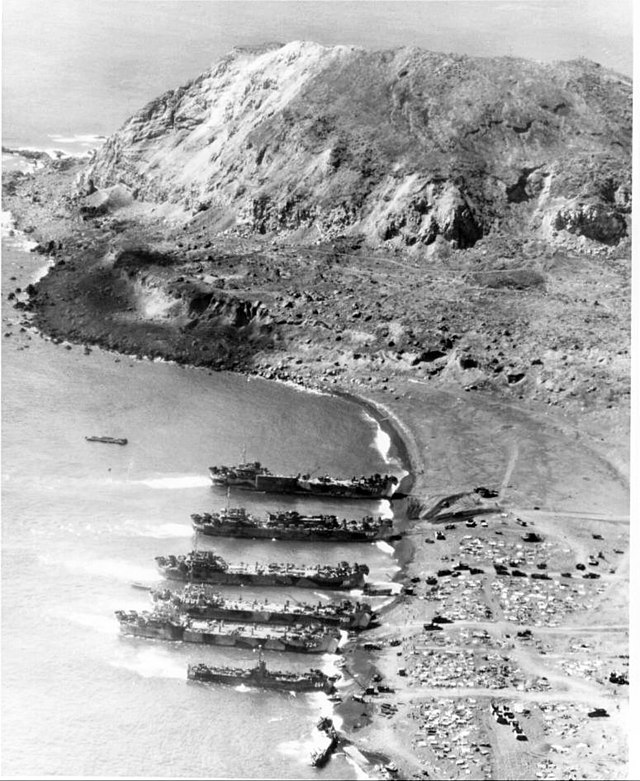 Photo: Vehicles on Iwo Jima's Red Beach, circa 25 February 1945, with USS LST-884 (center) and USS LST-929 (at left, with H markings on her hull) unloading in the background. Among the vehicles are trucks, mobile cranes, amphibious tractors (LVTs), jeeps and a variety of trailers. A field artillery piece is being pulled along in the right center. Note the pierced steel matting roadways Photo: Vehicles on Iwo Jima's Red Beach, circa 25 February 1945, with USS LST-884 (center) and USS LST-929 (at left, with H markings on her hull) unloading in the background. Among the vehicles are trucks, mobile cranes, amphibious tractors (LVTs), jeeps and a variety of trailers. A field artillery piece is being pulled along in the right center. Note the pierced steel matting roadways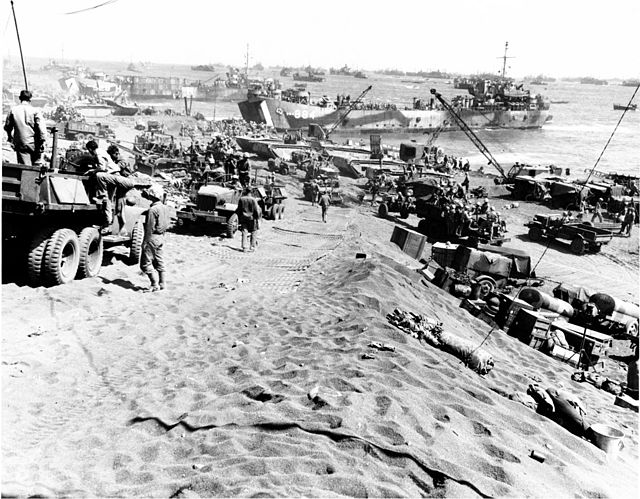 UNITED STATES NAVY DEPARTMENT COMMUNIQUES, CINCPOA COMMUNIQUÉ NO. 279, FEBRUARY 25, 1945 After preliminary bombardment by Marine artillery and heavy units of the Pacific Fleet, troops of the Third, Fourth, and Fifth Marine Divisions launched an attack northward on Iwo Island on February 25 (East Longitude Date). Fighting was heavy throughout the day and at nightfall our forces were in positions of the East‑West runway of the Central Iwo field and about two‑thirds of the North‑South runway. Carrier aircraft and Seventh Army Air Force Liberators of the Strategic Air Force, Pacific Ocean Areas, supported the attack. A total of 2,827 enemy dead had been counted by noon of February 25. Shortly before midnight of February 24, a small group of enemy aircraft attacked our forces on and around Iwo Island causing no damage. Part of their bombs were dropped in enemy territory on the Island. One of our night fighters shot down an enemy plane over Chichi Jima in the Bonins and three others were destroyed on the ground in the Bonins by our aircraft on February 24. Beach conditions continued to show marked improvement. Army Liberators of the Strategic Air Force bombed the airfield on Chichi Jima in the Bonins causing a large explosion near the runways on February 23. On the following day an attack was made on Omura Town on the same Island. The airfield on Marcus Island was bombed by Army Liberators of the Strategic Air Force on February 24. Neutralizing raids were continued on enemy held bases in the Marshalls by Navy search aircraft of Fleet Air Wing Two on February 24. PACIFIC Destroyer Harrison (DD-573) is damaged by storm south of Honshu, 33°00'N, 141°00'E. Motor minesweeper YMS-275 is damaged by mine off the Carolines, 07°20'N, 134°35'E. Destroyers Hazelwood (DD-531) and Murray (DD-576) sink Japanese guardboats No.1 Fuji Maru and Koki Maru, 31°06'N, 141°00'E, and guardboat No.5 Seiun Maru off Tori Jima, 31°00'N, 141°00'E. Submarine Flasher (SS-531) sinks Japanese cargo vessel Koho Maru near Hainan, 20°01'N, 111°19'E; USAAF B-24 attacks escorting submarine chaser Ch 21 while she is rescuing Koho Maru's survivors, but does not damage her. Submarine Hoe (SS-258) attacks Japanese convoy and sinks escort vessel Shonan south of Hainan Island 17°05'N, 110°05'E. Submarine Piper (SS-409) sinks Japanese guardboat No.3 Hosen Maru and sinks merchant cargo ship Koho Maru, 20°04'N, 111°22'E. British submarine HMS Trenchant attacks Japanese convoy in South Malacca Strait, sinking cargo vessel No.9 Akiyama Maru, 03°07'N, 99°56'E; Japanese army aircraft bomb Trenchant but she escapes unharmed. Japanese merchant cargo ship Kazusa Maru is sunk by aircraft off Miyake Jima; Japanese auxiliary minesweeper Wa 14 is damaged. Japanese auxiliary submarine chaser Cha 208 is damaged by aircraft, location unspecified. Japanese auxiliary submarine chaser No.5 Miyatake Maru is damaged by aircraft, off Shirahama.
|
|
lordroel
Administrator
Member is Online
Posts: 68,022 
Likes: 49,423
|
Post by lordroel on Feb 26, 2024 3:46:30 GMT
Day 1995 of World War II, February 26th 1945Eastern FrontThe Germans begin evacuations of wounded and refugees from Kolberg and other ports along the Baltic coast. These operations continue until the ports are captured during March. Soviet forces launch attacks into East Pomerania. Near Stettin, Soviet forces continue hold the positions despite German counterattacks. Western Front (1945) - Western Allied invasion of GermanyMap: HQ Twelfth Army Group situation map, February 26th 1945 In Holland, Operation Blockbuster begins with an artillery barrage by the Canadian 1st Army on northern frontline in Germany. 2nd and 3rd Canadian Infantry Divisions and 4th Armoured Division begin attacking German defences in the Hochwald Forest and Balberger heights. There are renewed attacks, by British and Canadian elements of British 21st Army Group, near Udem and Calcar. The US 1st and 9th Army units are moving rapidly from their bridgeheads over the Our River. The attacks by the US Ninth Army into the Hürtgen Forest make little progress. Photo: Combat Command "B" of the 10th Armored Division, Third U.S. Army, move through the newly-captured Irsch, Gerrmany. 26 February, 1945 Photo: Infantrymen of the 104th Division, U.S. First Army advance through the ruins of Arnoldsweilder, Germany. 26 February, 1945 Photo: Infantrymen of the 104th Division, U.S. First Army advance through the ruins of Arnoldsweilder, Germany. 26 February, 1945 Photo: Machine gunners of the 8th Division, U.S. First Army, advance through Binfield(?), Germany, in a new push on German positions. 26 February, 1945 Photo: Machine gunners of the 8th Division, U.S. First Army, advance through Binfield(?), Germany, in a new push on German positions. 26 February, 1945 Photo: A tank of the 10th Armored Division crosses the Saar River over a pontoon bridge, at Saarburg, Germany. 26 February, 1945 Photo: A tank of the 10th Armored Division crosses the Saar River over a pontoon bridge, at Saarburg, Germany. 26 February, 1945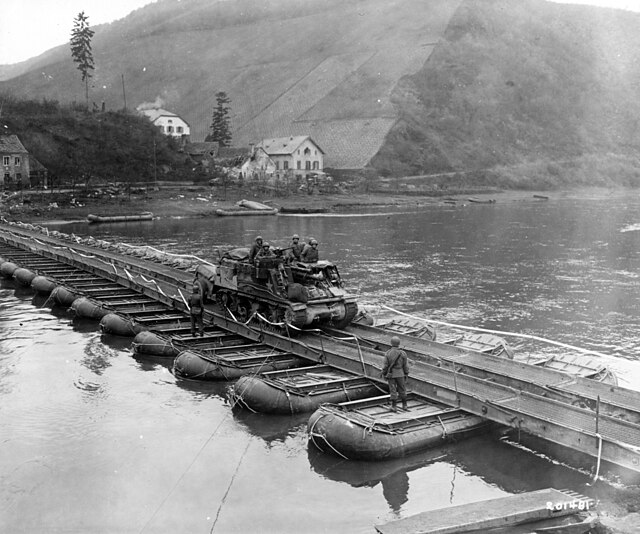 Photo: German prisoners taken by 10th Armored Division of 3rd U.S. Army, in Irsch, are marched towards tank block at end of street. 26 February, 1945 Photo: German prisoners taken by 10th Armored Division of 3rd U.S. Army, in Irsch, are marched towards tank block at end of street. 26 February, 1945 Air War over Europe Air War over Europe (US Eighth Air Force): 2 missions are flown. Mission 849: 1,207 bombers and 726 fighters are dispatched to make H2X radar attacks on three Berlin rail stations; they claim 6-0-0 Luftwaffe aircraft; 3 B-17s and 3 P-51s are lost: 1. 377 B-17s are sent to hit the Schlesischer rail station (363); 1 hits Osnabruck, a target of opportunity; 2 B-17s are lost and 21 damaged; 1 airman is WIA and 18 MIA. 214 of 244 P-51s escort claiming 4-0-0 aircraft in the air. 2. 446 B-17s set out to hit the Alexanderplatz rail station (418); 4 others hit a target of opportunity; 1 B-17s is lost, 1 damaged beyond repair and 43 damaged; 8 airmen are KIA, 2 WIA and 9 MIA. Escorting are 232 of 240 P-51s; they claim 2-0-0 aircraft on the ground; 3 P-51s are lost (2 pilots MIA). 3. 361 B-24s are dispatched to hit the North rail station (285); 37 hit Eberswalde, the secondary target; 4 hit a target of opportunity; 2 B-24s are damaged beyond repair and 26 damaged; 3 airmen are WIA and 3 MIA. The escort is 20 P-47s and 190 P-51s. 4. 17 B-17s and 6 B-24s fly screening missions. 5. 31 of 32 P-51 fly a scouting mission. Mission 850: During the night, 12 B-24s drop leaflets in the Netherlands and Germany; and 5 B-24s fly a CARPETBAGGER mission. (US Ninth Air Force): In Germany, 235 A-20s, A-26s, and B-26s attack the communications center at Wickrath, rail and road junctions at Zieverich and Gladbach, a supply and ammunition depot (casual target), the towns of Kapellen, Viersen, and Munstereifel, and targets of opportunity; weather limits fighter operations to armed reconnaissance flights in the Aschaffenburg-Wurzburg area by the XIX Tactical Air Command. Photo: A U.S. Army Air Forces Martin B-26G-11-MA Marauder (s/n 43-34565) from the 497th Bombardment Squadron, 344th Bombardment Group, 9th Air Force, enveloped in flames and hurtling earthward after enemy flak scored a direct hit on left engine while aircraft was attacking front line enemy communications center at Erkelenz, Germany, 26 February 1945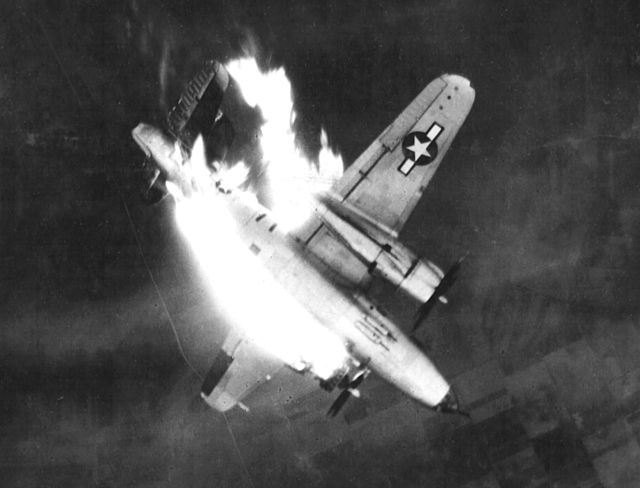 (US Fifteenth Air Force): During the night of 25/26 Feb, supply drops to N Italy continue. In Austria during the day 32 P-38s dive- bomb and strafe the Graz-Bruck an der Mur-Wiener Neustadt rail lines and 12 others fly top cover. Other P-38s and P-51s fly reconnaissance and escort missions. 102 B-24s, with fighter escort, dispatched against tactical targets in Yugoslavia, are recalled when clouds completely cover the objectives. 149 RAF Lancasters of No 3 Group carried out a G-H attack on the Hoesch benzol-oil plant at Dortmund through cloud. No results were seen but the bombing appeared to be concentrated. No aircraft lost. 38 RAF Mosquitos each to Berlin and Nuremberg, 3 Mosquitos on 'siren tours' of Northern Germany, 1 RCM sortie, 6 Mosquito patrols, 18 aircraft on Resistance operations. 1 Stirling lost on a Resistance flight. Italian campaign (US Twelfth Air Force): In Italy during the night of 25/26 Feb, A-20s considerably damage marshalling yards at Castelfranco Veneto and Bazzano; medium bombers bomb railroad bridges at Legnago, Ala, Pontetidone, and San Michele all'Adige; fighters and fighter-bombers hit bridges, marshalling yards, rail lines, and transport targets at numerous points including Nervesa della Battaglia, Ora, Bologna, Trento, Vicenza, Castelnuovo di Garfagnana, and Avisio, and bomb airfields at Ghedi and Bergamo; XXII Tactical Air Command aircraft also support US Fifth Army forces in the battle area S of Bologna. Battle of the Atlantic German submarine 'U-1051' sunk in the Irish Sea south of the Isle of Man, in position 53.39N, 05.23W, by ramming and depth charges from the British frigates HMS 'Aylmer', HMS 'Calder', HMS 'Bentinck' and HMS 'Manners'. 47 dead (all hands lost). After 'U-1051' torpedoed HMS 'Manners', she was located by HMS 'Bentinck' and attacked with depth charges, soon thereafter joined by HMS 'Aylmer' and HMS 'Calder'. The boat was forced to surface, came under fire by the frigates and sank after being rammed by HMS 'Aylmer'. Syria The government of Syria declares war on Germany and Japan. BelgiumU.S. freighter Nashaba, bound for Ghent, Belgium, in convoy TAM 91, sinks after striking a mine in the Schelde estuary, 51°22'18"N, 02°55'25"E. There are no casualties among the 27-man Armed Guard. United StatesPhoto: The U.S. Navy destroyer escort USS Doneff (DE-49) at sea on 26 February 1945, in her final World War II configuration. She is painted in Camouflage Measure 22 Photo: The U.S. Navy high-speed transport USS Rednour (APD-102) underway in the Atlantic Ocean on 20 February 1945. She is painted in Camouflage Measure 31, Design 20L Photo: The U.S. Navy high-speed transport USS Rednour (APD-102) underway in the Atlantic Ocean on 20 February 1945. She is painted in Camouflage Measure 31, Design 20L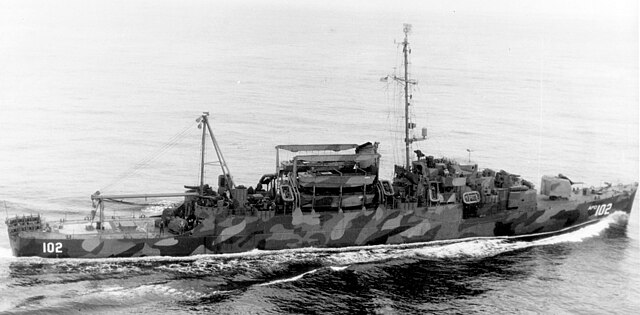 Photo: The U.S. Navy destroyer escort USS Edward C. Daly (DE-17) off the Mare Island Naval Shipyard, California (USA), 26 February 1945. She was in overhaul at Mare Island from 19 January until 3 March 1945. The ship is painted in Camouflage Measure 22 Photo: The U.S. Navy destroyer escort USS Edward C. Daly (DE-17) off the Mare Island Naval Shipyard, California (USA), 26 February 1945. She was in overhaul at Mare Island from 19 January until 3 March 1945. The ship is painted in Camouflage Measure 22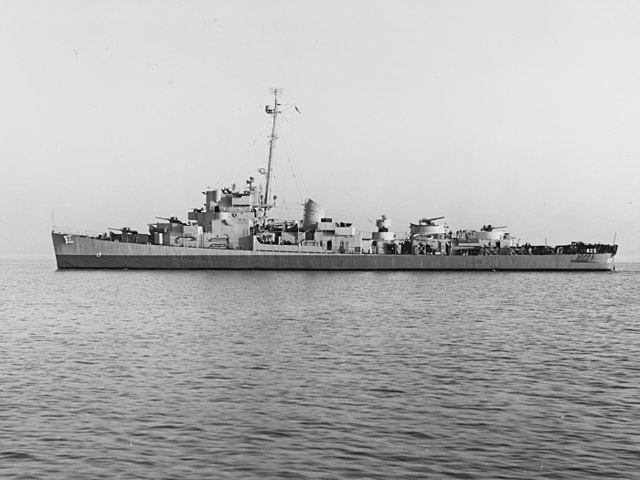 Pacific War Pacific WarCHINA (Fourteenth Air Force): In China, 20 B-25s, some with fighter escort, bomb Ishan, Luchai, Siangtan, and hit bridges at Chuchou and Loshan. In French Indochina, 9 B-25s attack bridges, railroad tracks, and heavy port equipment at Ha Trung, along the Chu R, and at Hongay and Haiphong. 70+ fighter-bombers on armed reconnaissance over S and E China and N French Indochina attack numerous targets of opportunity including airfields, town areas, and river, rail, and road traffic. INDIA (Twentieth Air Force): HQ 462d BG (Very Heavy) begins a movement from Piardoba, India to the Mariana Islands. Some B-29 bombers were assigned an unescorted photoreconnaissance mission to Singapore. A fighter shot down the B-29 bomber piloted by Capt. James Lyons. Shells from the Japanese plane set the nose section afire, seriously wounded the bombardier, and knocked out the number two engine. Bailing out over the sea when their left burning wing exploded, their approximate location was reported by another B-29 that was following them, air-sea rescue forces were notified, and 20 to 30 hours after the crew bailed out, 5 crews were rescued by a Catalina flying boat while with a good fortune another 4 were rescue by a British submarine HMS Seadog despite the danger of attack by Japanese surface ships. Another 3 crews were lost which included the wounded bombardier. Japanese report: Nine B-29s were badly damaged by our superior defense forces. (Only one B-29 bomber piloted by Capt. James Lyons was shot down, 9 were rescued and another 3 Missing In Action.) BURMA The advance of British 17th Indian Division toward Meiktila continues. Mahlaing and the Thabuktong airfield are captured during the day. Future reinforcements for British 4th Corps can be flown in to this airfield. Photo: A Sherman tank of Probyn's Horse (5th King Edward VII's Own Lancers), near Ondaw, 26 February 1945 Photo: A 7.2-inch howitzer in action at night near Ondaw, 26 February 1945 Photo: A 7.2-inch howitzer in action at night near Ondaw, 26 February 1945 INDIA-BURMA (Tenth Air Force): In Burma, 12 P-47s support troops of the British 36 Division in the Mongmit area; 8 support the MARS Task Force, a composite Chinese-American force, in the Lashio sector while 16 others fly close support for Chinese 50th Division troops near Namhsam; 8 B-25s on low-level strikes knock out bypass bridges at Mong Pawn and Loi-leng; 80+ fighter-bombers and 4 B-25s continue to attack troops, supplies, road traffic, and other targets immediately behind lines. Again 600+ transport sorties are flown. GUAM (Seventh Air Force): 9 B-24s sent from Guam against positions on Iwo Jima are recalled due to cloud cover; 8 B-24s hit Chichi Jima during the night of 26/27 Feb, flying individual harassment strikes. Lost with two Generals aboard: Harmon and Anderson is C-87 41-24174. Lieutenant General Millard F. Harmon, Commanding General, USAAF Air Forces, Pacific Area, departs Guam for Oahu, via Kwajalein, in his C-87 transport. The aircraft (its last reported position 11°15'N, 174°15'E) never reaches its destination. An extensive coordinated search by all services ensues for the next 20 days but fails to locate any trace of the missing plane or its passengers. SOUTHWEST PACIFIC AREA [Far East Air Force]: B-24s over Formosa hit Takao Airfield while fighters on a sweep strafe railroad targets. JAPAN Carriers of the US strikes by TF 58 are scheduled for the Nagoya area but these are canceled due to bad weather and the carrier force retires to the Okinawa area. PHILIPPINE CAMPAIGN (1945) The fighting on Corregidor comes to an end. The US forces find more than 5000 Japanese dead on the tiny island and others have been trapped in collapsed tunnels. There are 19 prisoners. American casualties are estimated at 1000. Photo: Battle of Manila a U.S. Army M4 Sherman tank enters old Fort Santiago through a somewhat enlarged gate, 26 February 1945. Note crest carved over the gate, and extensive damage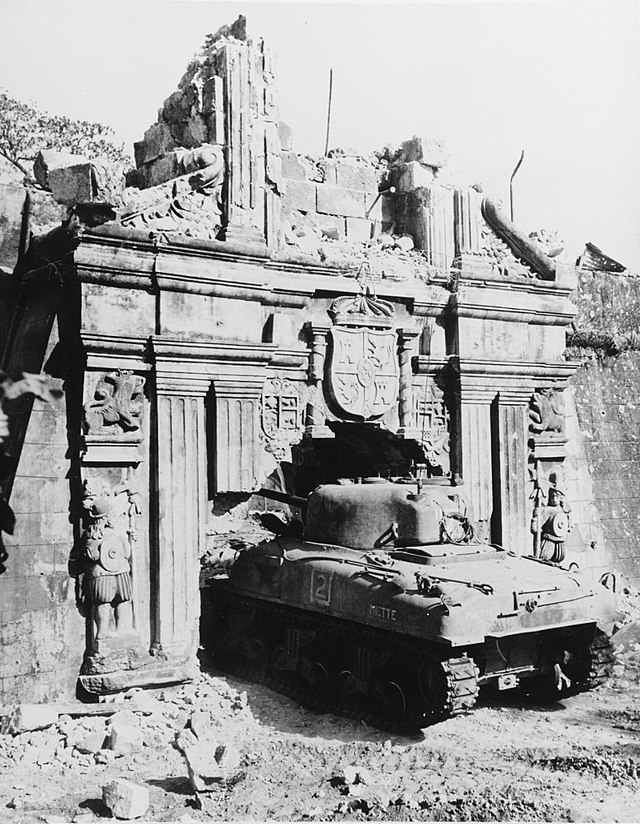 Photo: The Manila post office building under attack by U.S. troops, 26 February 1945. When photo was taken, the American soldiers were rushing Japanese positions in the post office. Note extensive fire damage to buildings in the area, and wrecked bridges Photo: The Manila post office building under attack by U.S. troops, 26 February 1945. When photo was taken, the American soldiers were rushing Japanese positions in the post office. Note extensive fire damage to buildings in the area, and wrecked bridges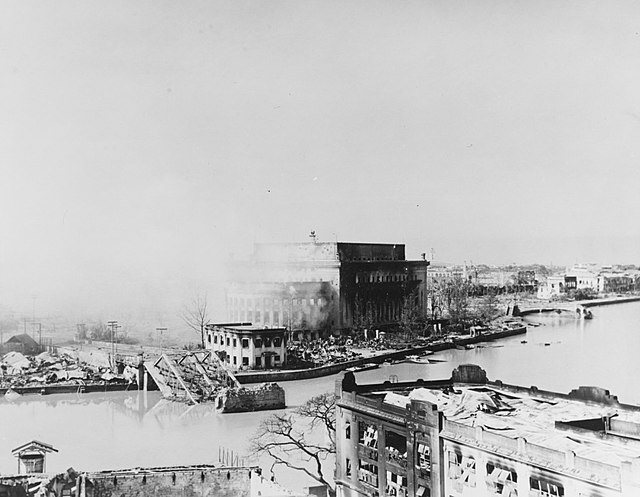 B-24s bomb troop concentrations in the Ipo Dam area and support ground forces NE of Manila; A-20s and fighter-bombers support ground forces in the Echague Airfield area, at Ternate, Trinidad, and Antipolo, and hit troops W of Ft Stotsenburg. A-20s, P-38s, and P-47s hit Puerto Princesa and B-25s bomb Zettle Airfield, lost is B-25G "Nancy Jean" 42-64907. B-24s hit Manggar and Sepinggang Airfields. The 9th Fighter Squadron, 49th Fighter Group, moves from San Jose, Mindoro to Lingayen Airfield with P-38s and the 70th Fighter Squadron, 18th Fighter Group, moves from Lingayen Airfield to San Jose with P-38s. Lost on an administrative flight is B-24D "Beautiful Betsy" 42-40387. VOLCANO AND RYUKYU ISLANDS CAMPAIGN The US Marines are predicting Allied control of Iwo Jima within days after seizing a second airstrip, Moyotomi No 2, and Hill 382, a strategic artillery post, as fierce fighting continues. "We can expect to take this island in a few more days," said Maj-Gen Holland Smith, the commander of the Pacific Fleet Marine Force. The seizure of the central plateau airfield means that the Marines are no longer fighting uphill and can now fight on a broader front. Alead to the north lie thick defences around Motoyami, behind which there is a third airstrip, still under construction. General Smith warned his men not to underestimate the task, even though the appallingly high daily US casualty rate is beginning to fall and there are signs that the enemy is short of water. "This fight is the toughest we've run across in 168 years," he said. The US needs Iwo's airfields to provide fighter cover for B-29 raids on Japan. Photo: Moving up the front less than 100 yards away, this squad of Fourth Marine Division skirts the edge of captured Motoyama Airfield -2. Wrecked U.S. tank, captured Jap blockhouse in background. 26 February, 1945 Off Iwo Jima, storm damages heavy cruiser San Francisco (CA-38), destroyers Colahan (DD-658), Halsey Powell (DD-686), Benham (DD-796), John W. Weeks (DD-701), Stephen Potter (DD-538), and Preston (DD-795); attack cargo ship Muliphen (AKA-61) is damaged in collision with heavy cruiser Salt Lake City (CA-25), 24°46'N, 141°19'E. Tank landing ships LST-760 and LST-884 are damaged by shore battery fire, 24°46'N, 141°19'E. UNITED STATES NAVY DEPARTMENT COMMUNIQUES, CINCPOA COMMUNIQUÉ NO. 280, FEBRUARY 26, 1945 Elements of the Third Marine Division constituting the center of our lines on Iwo Island advanced about 400 yards through extremely heavy enemy defenses on February 26 (East Longitude Date) seized the high ground of the central plateau and by nightfall brought most of the island's second airfield into our possession. Fighting along the entire line was very heavy with enemy resistance mounting before our attack throughout the day. Our troops were subjected to artillery and rocket fire and a very heavy volume of small arms fire during the advance. The Fourth Marine Division on the east and the Fifth Marine Division on the west advanced during the day, the Fourth Division capturing a commanding hill near the east coast. The attack by our forces was supported by Marine artillery, Naval gunfire, and carrier aircraft. Mopping up operations continued in the south, around Mount Suribachi. Little enemy fire fell on the interior of our beachhead during the day. On February 26 our forces counted 3,568 enemy dead and 9 enemy prisoners in eight days of fighting on Iwo Island. Marine observation planes, the first U. S. aircraft to land, began operating on the southern Iwo airstrip during the morning while restoration of the runways to operational condition continued. Supplies and equipment were landed in increasing quantities as road and beach conditions continued to improve. Carrier aircraft strafed targets in and around Chichi Jima in the Bonins burning one plane on the ground, sinking a small merchant vessel and burning two medium merchant ships. Oil storage facilities were destroyed. Planes of the Fourth Marine Aircraft Wing set a building supply dump and fuel storage area afire on Urukthapel in the Palaus on February 25. Marine aircraft attacked targets on Yap in the western Carolines on the same date. Army Thunderbolts strafed buildings and defenses on Pagan in the Marianas on February 26, starting two fires. PACIFIC Light cruiser Pasadena (CL-65), 31°20'N, 141°15'E, and destroyer Porterfield (DD-682), 33°10'N, 143°30'E, are damaged by gunfire from Japanese guardboat that penetrates task group formation south of Honshu. Minesweeper Saunter (AM-295) is damaged by mine off El Fraile island Luzon, 14°17'N, 120°38'E. Planes (VC 82) from escort carrier Anzio (CVE-57) sink Japanese submarines I 368, 35 miles west of Iwo Jima, 24°43'N, 140°37'E, and RO 43, 50 miles west-northwest of Iwo, 25°07'N, 140°19'E. Destroyer escort Finnegan (DE-307) sinks Japanese submarine I 370 120 miles south of Iwo Jima, 22°45'N, 141°27'E. USAAF planes sink Japanese tanker No.9 Takasago Maru at 20°01'N, 111°44'E. Japanese merchant cargo ship Zuisho Maru is damaged bygunfire, near Hong Kong.
|
|
lordroel
Administrator
Member is Online
Posts: 68,022 
Likes: 49,423
|
Post by lordroel on Feb 27, 2024 3:47:22 GMT
Day 1996 of World War II, February 27th 1945Eastern FrontElements of the Soviet 2nd Belorussian Front enter Pomerania, in Germany. Western Front (1945) - Western Allied invasion of GermanyMap: HQ Twelfth Army Group situation map, February 27th 1945 Udem and Calcar both fall to attacks by British and Canadian elements of the British 21st Army Group. The Rhine River is reached to the northeast of Calcar. Units of US 7th Corps (part of US 1st Army) cross the Erth River at Modrath, about 10 km from Cologne. Farther south, two corps of US 3rd Army are converging on Trier. Photo: In the background, behind the U.S. soldier and tank destroyer, the town of Irsch, Germany, burns. 27 February, 1945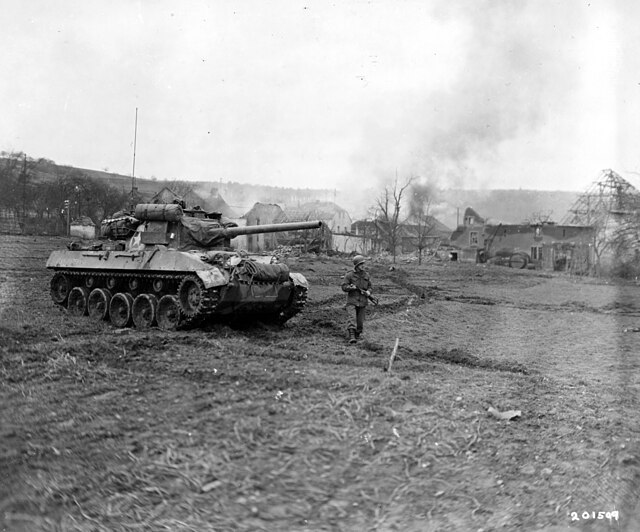 Photo: After Rheindahlen, Germany, has fallen to the troops of the U.S. Ninth Army, American armor rolls into the town. 27 February, 1945 Photo: After Rheindahlen, Germany, has fallen to the troops of the U.S. Ninth Army, American armor rolls into the town. 27 February, 1945 Photo: Infantrymen of 30th Division, 9th U.S. Army, move through town of Kirchherten, Germany, as they push across Cologne, 27 February, 1945 Photo: Infantrymen of 30th Division, 9th U.S. Army, move through town of Kirchherten, Germany, as they push across Cologne, 27 February, 1945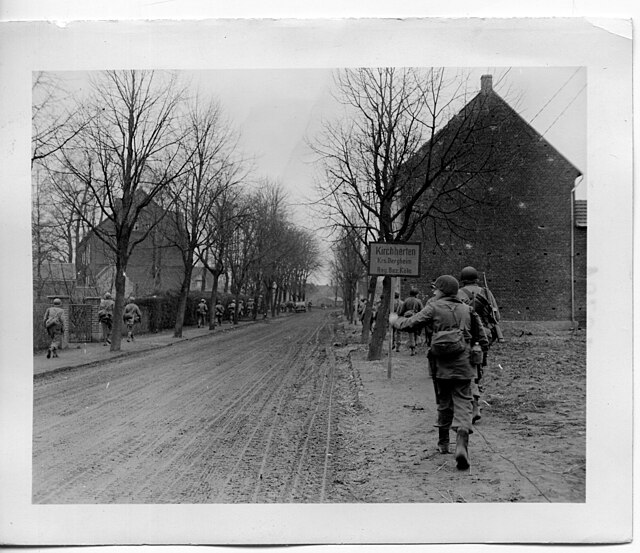 Photo: German prisoners of war pass a burning building in Irsch, Germany, as they are brought in for interrogation, 27 February, 1945 Photo: German prisoners of war pass a burning building in Irsch, Germany, as they are brought in for interrogation, 27 February, 1945 Air War over Europe Air War over Europe (US Eighth Air Force): 2 missions are flown. Mission 851: 1,107 bombers and 745 fighters are dispatched to hit road and rail communications at Halle and Leipzig using H2X radar; they claim 83-0-19 Luftwaffe aircraft; 2 B-24s and 2 P-51s are lost: 1. 314 of 351 B-24s hit the marshalling yard at Halle; targets of opportunity are Bitterfeld (21) and other (3); 2 B-24s are lost and 4 damaged; 1 airman is KIA and 18 MIA. Escorting are 196 P-47s and P-51s; they claim 1-0-0 aircraft in the air and 45-0-3 on the ground; 2 P-51s are lost (pilots MIA). 2. 717 of 756 B-17s hit the rail center at Leipzig; 7 others hit targets of opportunity; 1 B-17 is damaged beyond repair and 3 damaged; 2 airmen are KIA. The escort is 453 of 489 P-51s; they claim 1-0-0 aircraft in the air and 36-0-16 on the ground without loss. 3. 28 P-51s fly a scouting mission without loss. 4. 13 P-51s escort 2 F-5s and 2 Spitfires on a photo reconnaissance mission over C and E Germany. Mission 852: During the night of 27/28 Feb, 23 of 26 B-24s bomb Wilhelmshafen oil storage by PFF without loss and 1 B-17 and 11 B-24s drop leaflets in the Netherlands and Germany. (US Ninth Air Force): In Germany, 118 A-20s, A-26s and B-26s attack the Ahrweiler rail bridge, communications centers at Glessen, Munstereifel, and Monheim, and a target of opportunity; fighters fly leaflet missions, attack Frankfurt/Main oil storage tanks, fly alerts, and strafe from W of Duisburg to Worringen; the XXIX Tactical Air Command (Provisional) also flies support for the XIII and XIX Corps SW and S of Monchen-Gladbach. (US Fifteenth Air Force): 540+ B-24s and B-17s, with fighter escort, bomb marshalling yards at Augsburg, Germany and Salzburg, Lienz, and Jenbach, Austria plus several targets of opportunity; escorting fighters strafe targets of opportunity during the return flight. Routine reconnaissance and supply missions continue. 458 RAF aircraft - 311 Halifaxes, 131 Lancasters, 16 Mosquitos - of Nos 4, 6 and 8 Groups to Mainz. 1 Halifax and 1 Mosquito lost. The target area Mainz was covered by cloud and the bombing was aimed at skymarkers dropped on Oboe. No results were seen by the bomber crews but the bombing caused severe destruction in the central and eastern districts of Mainz; this was the city's worst raid of the war. 1,545 tons of bombs were dropped. 5,670 buildings were destroyed, including most of the historic buildings in the Altstadt, but the industrial district was also badly hit. This was the last heavy raid on Mainz. 149 RAF Lancasters of No 3 Group carried out a G-H attack through thick cloud on the Alma Pluto benzol plant, Gelsenkirchen but no results were seen. 1 Lancaster lost. Italian campaign (US Twelfth Air Force): In Italy during the night of 26/27 Feb, A-20s bomb enemy movement at 14 different places in the Po Valley, marshalling yards at Villafranca di Verona and Isola della Scala, the town of Bazzano, and airfields at Villafranca di Verona and Ghedi; XXII Tactical Air Command fighter-bombers concentrate on railroad cutting in the Brenner area and NE Italy, claiming 36 cuts, and attack rolling stock in the Villach, Austria area; medium bombers destroy a railroad diversion bridge at San Michele all'Adige and cut approaches on the Ala and Lavis bridges and effectively blast the Spilimbergo and Pagnocco dumps. Battle of the AtlanticGerman submarine U-327 is sunk by PB4Y-1 (VPB 112), and British escort vessels HMS Labuan, HMS Loch Fada and HMS Wild Goose, English Channel, 49°46'N, 05°47'W. Battle of the Indian OceanBritish escort carrier HMS Activity rescues one boatload of survivors (20 men) from sunken freighter Peter Silvester, sunk on 6 February by German submarine U-862 in the Indian Ocean. Romania Under Soviet pressure, Rumanian King Michael I is forced to appoint a Communist government. Lebanon Lebanon declares war on Germany and Japan. United StatesPhoto: The U.S. Navy destroyer escort USS Engstrom (DE-50) underway off the Mare Island Naval Shipyard, California (USA), on 27 February 1945. She was under overhaul at Mare Island from 19 January until 27 February 1945 Photo: The U.S. Navy high speed transport USS Donald W. Wolf (APD-129) at Brandon Pool, Chicago, Illinois (USA), on 27 February 1945, waiting transit to New Orleans; Louisiana, for fitting out and commissioning. She is painted in Camouflage Measure 31, Design 20L Photo: The U.S. Navy high speed transport USS Donald W. Wolf (APD-129) at Brandon Pool, Chicago, Illinois (USA), on 27 February 1945, waiting transit to New Orleans; Louisiana, for fitting out and commissioning. She is painted in Camouflage Measure 31, Design 20L Egypt Egypt U.S. President Franklin D. Roosevelt hosts a gathering aboard his cruiser. Those on hand include Haile Selassie of Ethiopia, King Faruk of Egypt, and King Ibn Saud of Arabia. General de Gaulle refuses to attend. Pacific War CHINA (Fourteenth Air Force): 12 B-25s knock out 4 bridges and damage 2 others in N French Indochina. In China, 12 others bomb Ishan and Hwaiyuanchen; 4 B-24s over the Gulf of Tonkin and S China Sea attack shipping, claiming 2 vessels sunk; 19 fighter-bombers hit barracks SW of Ishan, 15 attack Kiungshan Airfield, 12 hit targets of opportunity in the Yoyang area, 23 hit targets of opportunity around Kiyang, and 30 others hit scattered targets of opportunity at other points in S and E China; the 22d Bombardment Squadron (Medium), 341st Bombardment Group (Medium), based at Yangkai with B-25s, sends a detachment to operate from Peishiyi; the 35th Photographic Reconnaissance Squadron, Fourteenth AF, based at Chanyi with F-5s, sends a detachment to operate from Laohwangping (another detachment is operating from Chengkung). (Twentieth Air Force): Mission 40: In the Malayan States during the night of 27/28 Feb, 10 of 12 B-29s mine Johore Strait on the E of Singapore and 1 mines Penang harbor. Personnel of the 58th Bombardment Wing (Very Heavy) begin shipping out of Calcutta, India for Tinian and Guam , implementing the redeployment orders of the 6 Feb War Department directive; the final shipment arrives in the the Mariana on 6 Jun, completing the transfer of the wing from India without loss of a single life or aircraft. BURMA Units of the British 19th Indian Division begin to break out of their bridgehead over the Irrawaddy River, at Habeikkyin, and advance south toward Mandalay against heavy Japanese resistance. INDIA-BURMA (Tenth Air Force): In Burma, 18 P-47s closely support ground forces in the Mongmit area; 4 others knock out a small bypass bridge at Hay-ti; about 100 fighter-bombers attack troop concentrations, supplies, gun positions, elephant transport, and road traffic along the battlefronts and behind enemy lines. Transport operations continue on a large-scale as 589 sorties are completed. GUAM (Seventh Air Force): 9 Guam based B-24s blast pillboxes, artillery emplacements, blockhouse, and mortar positions on the N part of Iwo Jima. On Mindanao 22 B-24s from Angaur Airfield bomb Daliao and Libby Airfields. During the night of 27/28 Feb, 9 B-24s, flying snooper strikes out of Guam, bomb airfields, radio stations, and the town of Okimura on Haha Jima. SOUTHWEST PACIFIC AREA On Formosa, Takao is hit by B-24s while fighters sweep the W coast. Sweeping the China coast, B-25s hit a fleet of junks and sampans near Hong Kong destroying and damaging 25+. PHILIPPINE CAMPAIGN (1945) An official ceremony formally re-establishes the Commonwealth of the Philippines, in Manila. YouTube (Turning Over Civil Affairs to Philippine Government, Manila, Philippine Islands (Feb. 27, 1945)B-24s, A-20s, and P-38s strike Puerto Princesa in preparation for the following morning's allied amphibious landings. On Luzon , ground support continues on a largescale including a strike on Baguio by P-51s. On Mindanao P-38s and USMC aircraft hit airfields. B-24s bomb Tarakan and Jesselton Airfields. The 8th Fighter Squadron, 49th Fighter Group, moves from San Jose to Lingayen Airfield with P-38s and the 12th Fighter Squadron, 18th Fighter Group, moves from Lingayen Airfield to San Jose with P-38s. The 65th and 66th Troop Carrier Squadrons, 403d Troop Carrier Group, moves from Biak to Morotai with C-46s and C-47s (the squadrons cease operating from Hill Field, Mindoro); and the 432d Fighter Squadron, 475th Fighter Group, moves from Dulag to Clark Field with P-38s (a detachment is operating from San Jose). VOLCANO AND RYUKYU ISLANDS CAMPAIGN On Iwo Jima, the carriers of TF53 again add their support to the ships aiding the attacks of US 5th Amphibious Corps. The American objective is the elimination of three Japanese positions overlooking the second airfield on the island, however, the marines fail to dislodge the Japanese defenders. Photo: Iwo Jima, Supplies are unloaded from the vast fleet of ships offshore and ration dumps of the Third and Fourth Marine Divisions are established on the beach, 27 February 1945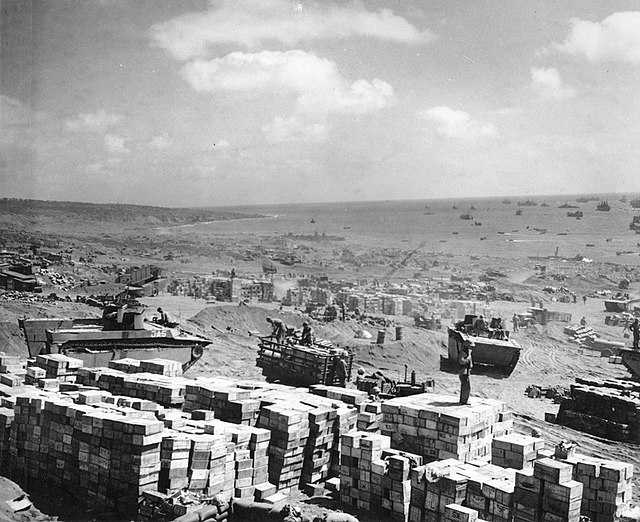 Photo: Marines stack their rations about 300 yards inland from the water’s edge on the Iwo Jima beachhead”, 27 February 1945 Photo: Marines stack their rations about 300 yards inland from the water’s edge on the Iwo Jima beachhead”, 27 February 1945 Off Iwo Jima, collisions account for damage to small carrier San Jacinto (CVL-30) and oiler Merrimack (AO-37), 23°00'N, 139°00'E; destroyer Colhoun (DD-801) and attack transport Knox (APA-46), 24°49'N, 141°20'E [Colhoun collides with attack cargo ship Libra (AKA-12) soon thereafter]; tank landing ship LST-121 and attack cargo ship Starr (AKA-67), 24°46'N, 141°19'E; tank landing ship LST-809 and tank landing ship LST-224, 24°46'N, 141°19'E; Japanese shore battery fire damages attack cargo ship Leo (AKA-60) and tank landing ship LST-884; mortar fire accounts for damage to medium landing ship LSM-92. Submarine Blenny (SS-324), attacking Japanese convoy off French Indochina, sinks merchant tanker Amato Maru off Cape Padaran, 11°58'N, 109°18'E. Photo: U.S. ships and landing craft anchored off East Beach during landing operations. Taken by plane from USS Saginaw Bay (CVE 82), February 27, 1945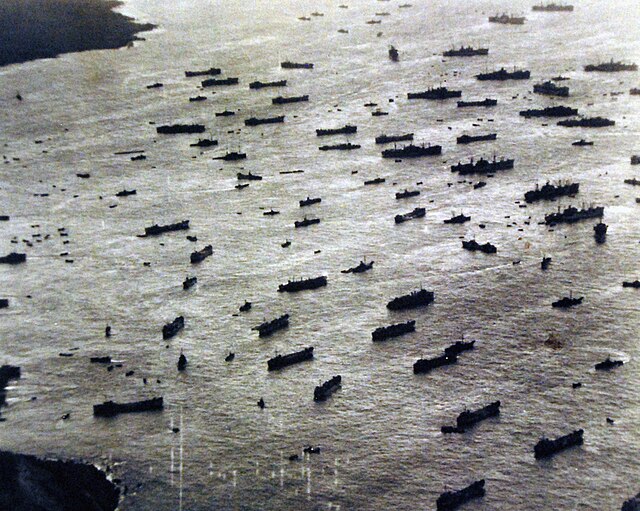 Photo: The U.S. Navy destroyer USS Evans (DD-552) underway on 27 February 1945, as seen from the escort carrier USS Makin Island (CVE-93). She is painted in Camouflage Measure 31, Design 7D Photo: The U.S. Navy destroyer USS Evans (DD-552) underway on 27 February 1945, as seen from the escort carrier USS Makin Island (CVE-93). She is painted in Camouflage Measure 31, Design 7D UNITED STATES NAVY DEPARTMENT COMMUNIQUES, CINCPOA COMMUNIQUÉ NO. 281, FEBRUARY 27, 1945 Under extremely adverse weather conditions carrier aircraft of the U. S. Pacific Fleet attacked the Tokyo Area on February 25, and the Island of Hachijo on February 26 (East Longitude Dates). Incomplete reports indicate that our forces inflicted the following damage on the enemy: Aircraft: 158 planes destroyed, including 47 shot out of the air. About 75 planes damaged on the ground. Shipping: 5 small enemy vessels including one picket craft sunk. 5 coastal vessels and 7 small craft probably sunk. 9 coastal vessels and 5 small craft damaged. Ground Installations: 2 trains destroyed in the Tokyo Area. Radar installations and hangars at airfields destroyed. Ota aircraft plant near Tokyo heavily hit. About 75 per cent of its buildings are now destroyed and 15 per cent heavily damaged. Koizumi Aircraft Plant heavily damaged. Our forces lost nine fighter planes in combat and four pilots. The ships of our Task Force suffered no damage from enemy action during the attack but minor damage was caused to two light units during retirement. Throughout our attacks the enemy offered only slight resistance; about 100 aircraft were observed in the air but the Majority of them were unaggressive. No substantial attempt was made to attack our force. Admiral R. A. Spruance, U. S. Navy, Commander Fifth Fleet commanded our forces and Vice Admiral Marc A. Mitscher, U. S. Navy, was in tactical command of the Fast Carrier Task Force. PACIFIC Submarine Scabbardfish (SS-397) sinks Japanese guardboat No.6 Kikaku Maru, 100 miles northeast of Keelung, Formosa, 25°45'N, 123°20'W. Japanese merchant vessel No.2 Suma Maru is sunk by aircraft 80 miles off Amoy, China.
|
|
lordroel
Administrator
Member is Online
Posts: 68,022 
Likes: 49,423
|
Post by lordroel on Feb 28, 2024 3:51:43 GMT
Day 1997 of World War II, February 28th 1945Eastern Front Soviet troops capture Neustettin and Prechlau. The Red Army suspends all offensive operations against the lines of Heeresgruppe Kurland. Western Front (1945) - Western Allied invasion of GermanyMap: HQ Twelfth Army Group situation map, February 28th 1945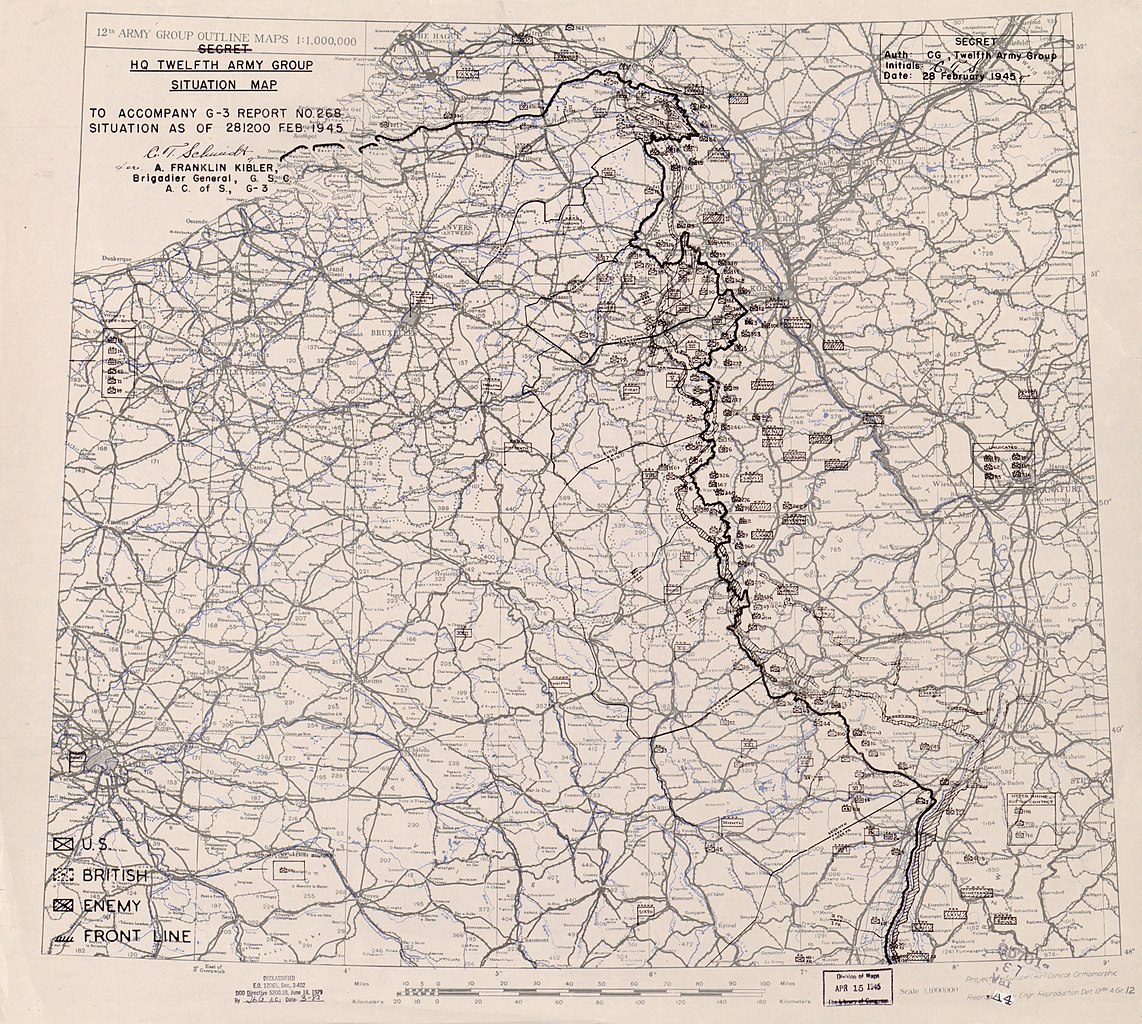 The US Ninth Army achieves a breakthrough near Erkelenz 30 miles W of Cologne, but losing 100 tanks in the process. Photo: Soldiers of the U.S. 5th Infantry Division in the ruins of Bitburg, Germany, 28 February 1945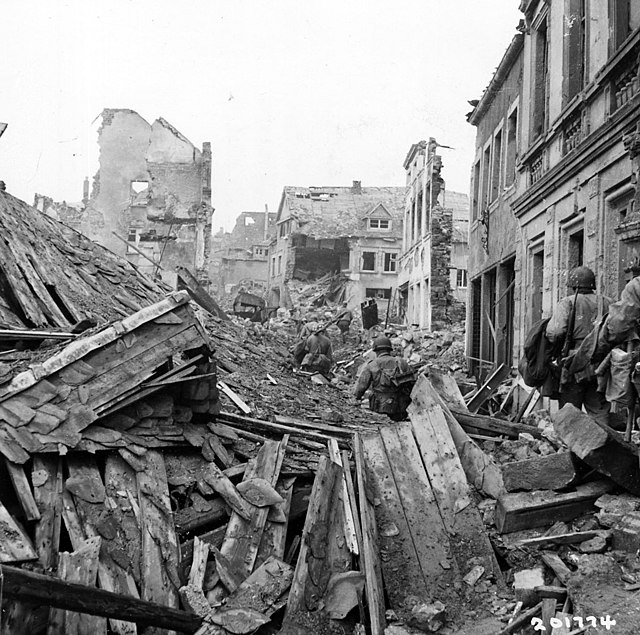 Photo: Chemical fog conceals troops of the U.S. First Army as they cross the Roer River. 28 February, 1945. Nideggen, Germany Photo: Chemical fog conceals troops of the U.S. First Army as they cross the Roer River. 28 February, 1945. Nideggen, Germany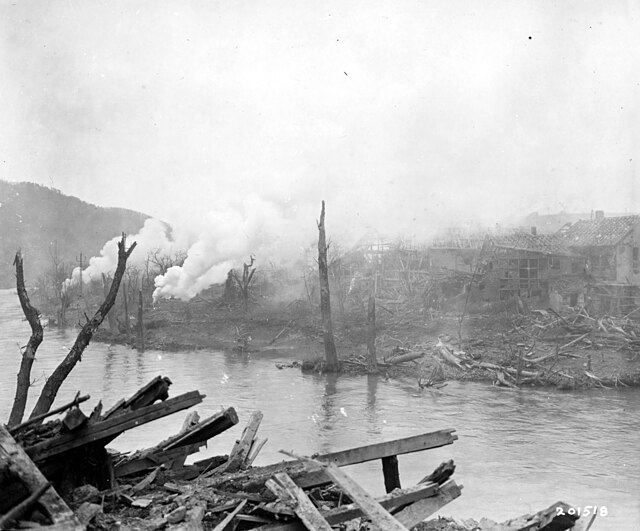 Photo: As the Nazis shell the town of Nideggen, Germany, soldiers of the U.S. First Army take cover in the wreckage. 28 February, 1945 Photo: As the Nazis shell the town of Nideggen, Germany, soldiers of the U.S. First Army take cover in the wreckage. 28 February, 1945 Photo: Men fire smoke shells from an 81mm mortar supporting infantrymen of the U.S. First Army as they advance on a pillbox. 28 February, 1945 Photo: Men fire smoke shells from an 81mm mortar supporting infantrymen of the U.S. First Army as they advance on a pillbox. 28 February, 1945 Photo: Troops of the 9th Infantry Division, U.S. First Army, file through the wreckage and an archway in the town of Nideggen, Germany. 28 February, 1945 Photo: Troops of the 9th Infantry Division, U.S. First Army, file through the wreckage and an archway in the town of Nideggen, Germany. 28 February, 1945 Air War over Europe Air War over Europe Units moving from England to France: HQ 313th Troop Carrier Group from Folkingham to Achiet; HQ 314th Troop Carrier Group and the 32d and 61st Troop Carrier Squadrons from Saltby to Poix with C-47s. The 36th Bombardment Squadron (Heavy), 1st Air Division [attached to 482d Bombardment Group (Heavy)], moves from Cheddington to Alconbury, England with B-24s (the 36th is engaged in radio countermeasures operations). (US Eighth Air Force):: 3 missions are flown. Mission 854: 1,104 bombers and 737 fighters are dispatched to make PFF attacks on rail targets in Germany; they calim 18-0-11 Luftwaffe aircraft; 1 B-17 and 5 P-51s are lost: 1. 378 B-17s are sent to hit marshalling yards at Soest (143), Hagen (151) and Schwerte (74) using Gee-H; 1 other hits a target of opportunity; 1 B-17s is lost; 3 airmen are MIA. 106 of 112 P-51s escort without loss. 2. 346 B-24s are dispatched to hit the Arnsberg (95) and Bielefeld (81) viaducts, the Siegen marshalling yard (77) and the Henschel tank plant at Meschede (79); 1 other hits the Neustadt road junction, a target of opportunity; all attacks are made using Gee-H; no casualties. Escorting are 117 of 123 P-51s; 1 is lost (pilot MIA). 3. 364 of 380 B-17s hit the marshalling yard at Kassel, the secondary target; 6 others hit 6 targets of opportunity; the attacks are made using H2X radar; no casualties. The escort is 113 of 118 P-51s; they claim 0-0-1 aircraft in the air and 10-0-4 on the ground; 1 P-51 is lost (pilot MIA). 4. 308 of 318 P-51s fly a strafing run in the Wurzburg-Munich area; they calim 8-0-6 aircraft on the ground; 3 P-51s are lost (pilots MIA). 5. 18 of 20 P-47s fly a figher-bomber mission against Ablar, Offenbach and Werdorf marshalling yards and factory buildings without loss. 6. 16 P-51s escort 4 F-5s and 1 Spitfire on a photo reconnaissance mission over Germany. Mission 855: 11 B-24s drop leaflets in the Netherlands and Germany during the night without loss. 1 Mosquito flies a SKYWAVE mission over Germany. (SKYWAVE is a special navigational mission to calibrate LORAN equipment.) Mission 856: 22 of 24 B-24s bomb the Freiburg rail depot during the night using PFF methods; no losses. (US Ninth Air Force): In Germany, 340+ A-20s, B-26s and A-26s bomb rail bridges at Mayen, Niederscheld, and Colbe, the Unna ordnance depot, Kamp road junction, Siegen and Sankt Wendel marshalling yards, the town of Rheinburg, and targets of opportunity; fighters escort the bombers, fly sweeps, patrols and armed reconnaissance, attack special targets, and support the US 3d Armored Division at the Paffendorf bridgehead, US Ninth Army elements near Monchen-Gladbach and Neuss [the 2d Armored Division reaches a point within 6 miles (9.7 km) of the Rhine River], and the VIII, XII, and XX Corps between the Prum and Kyll Rivers and near Trier. 156 RAF Lancasters of No 3 Group in a G-H raid on the Nordstern synthetic-oil plant at Gelsenkirchen. No aircraft lost. 98 RAF training aircraft on a sweep over the North Sea, 74 Mosquitos to Berlin, 8 to Nuremberg and 4 to Munich, 44 RCM sorties, 31 Mosquito patrols, 5 Mosquitos of No 5 Group minelaying in the Kiel Canal, 20 aircraft on Resistance operations. 1 Mosquito lost from the Berlin raid. Italian campaign (US Fifteenth Air Force): About 680 B-17s and B-24s bomb marshalling yards at Lienz, Austria; Ora, Bolzano, Vipiteno, Vicenza, Fortezza, Bressanone, Brunico, Brescia, and Conegliano, Italy, and bridges at Albes and Verona-Parona di Valpolicella, Italy; 109 P-51s provide escort; 75 P-38s divebomb the Sankt Veit an der Glan marshalling yard in Austria and strafe rail lines in the Sankt Veit, Austria-Klagenfurt, Austria-Villach, Austria-Ljubljana, Yugoslavia areas; other P-38s and P-51s (about 25) strafe rail traffic around Bruck an der Mur, Innsbruck, Klagenfurt, and Worgl, Austria and Passau, Germany, and attack Bjelovar Airfield in Yugoslavia, destroying an enemy-held B-24 and P-38; reconnaissance and supply flights are maintained. (US Twelfth Air Force): In Italy during the night of 27/28 Feb, A-20s attack a few marshalling yards, bridges, rail lines, and general movement but because of bad weather are recalled by midnight; XII Tactical Air Command fighter-bombers continue to pound communications and other targets, including Ghedi and Vicenza Airfields, ammunition dumps near Codroipo and W of Villafranca di Verona, and shell loading plant SW of Piacenza; medium bombers bomb bridges at Ala, Santa Margherita d'Adige, San Michele all'Adige, Ponte di Piave, and Pordenone, and a railway embankment at Salorno. Battle of the AtlanticDestroyer escort Fowler (DE-222) and French L'Indiscret sink German submarine U-869 off Morocco, 34°30'N, 08°13'W. Battle of the Mediterranean British troops land on Piscopi Island, close to Rhodes. Iran The government of Iran declares war on Japan. Saudi ArabiaThe government of Saudi Arabia declares war on Germany and Japan. Pacific War CHINA (Fourteenth Air Force): In China, 2 B-25s attack targets of opportunity in the Hsiang River Valley while 2 P-51s hit targets of opportunity NE of Hengyang; a single B-24 damages a cargo vessel in the S China Sea; the 11th Bombardment Squadron (Medium), 341st Bombardment Group (Medium), based at Yangkai with B-25s, sends a detachment to operate from Laowhangpin. BURMA The British 4th Corps begins to attack Meiktila in strength. Although Meiktila is a vital communications center, serving all the Japanese forces around Mandalay and to the north, it is lightly defended. The Japanese command believes the British forces in the area are only lightly armed (in the Chindit pattern) and relatively small. Photo: British mortars in action during the fighting for Meiktila in Burma, 28 February 1945 Photo: Troops of the West Yorkshire Regiment warily search Japanese dugouts in Meiktila, 28 February 1945 Photo: Troops of the West Yorkshire Regiment warily search Japanese dugouts in Meiktila, 28 February 1945 Photo: Men of the West Yorkshire Regiment advance through the ruins of Meiktila, 28 February 1945 Photo: Men of the West Yorkshire Regiment advance through the ruins of Meiktila, 28 February 1945 Photo: A Lee tank being loaded onto a pontoon ferry by men of the 2nd Division before crossing the Irrawaddy river at Ngazun, 28 February 1945 Photo: A Lee tank being loaded onto a pontoon ferry by men of the 2nd Division before crossing the Irrawaddy river at Ngazun, 28 February 1945 Photo: Priest 105mm self-propelled gun of 17th Division near Meiktila, 28 February 1945 Photo: Priest 105mm self-propelled gun of 17th Division near Meiktila, 28 February 1945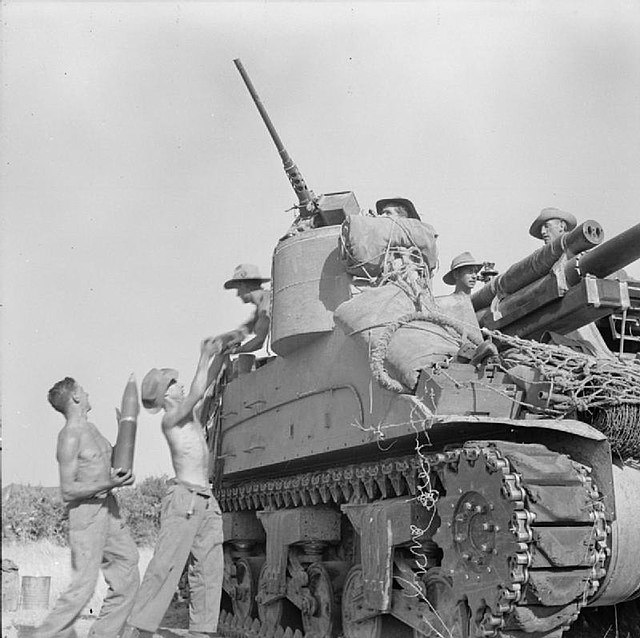 INDIA-BURMA (Tenth Air Force): In Burma, 28 P-47s support forces of the British 36 Division in the Mongmit area; 75 fighter-bombers continueu pounding troop concentrations, supply dumps, and road traffic behind enemy lines. 552 transport sorties are flown, landing men and supplies at forward bases and dropping supplies to frontline troops. GUAM (Seventh Air Force): 8 Guam based B-24s pound Susaki Airfield. 23 B-24s from Angaur Airfield bomb Sasa Airfield. During the night of 28 Feb/1 Mar, 6 B-24s from Guam, flying separate harassment strikes, bomb Susaki Airfield again. The ground echelon of the 548th Night Fighter Squadron, VII Fighter Command arrives on Iwo Jima from Hawaii (air echelon is operating from Saipan with P-61s). SOUTHWEST PACIFIC AREA [Far East Air Force]: B-24s strike Sandakan and Labuan Airfields and B-25s fly a napalm raid against Sanga Sanga Airfield. 22nd BG B-24s bomb Caldera Point and B-25s hit San Roque Airfield. The 70th Troop Carrier Squadron, 433d Troop Carrier Group, moves from Hollandia to Dulag with C-46s and C-47s. The 431st and 433d Fighter Squadrons, 475th FG, move from Dulag to Clark Field with P-38s (they are operating from San Jose). The 530th Bombardment Squadron moves from Darwin, Australia to San Jose, Mindoro with B-24s. PHILIPPINE CAMPAIGN (1945) There are America landings at Puerto Princesa on Palawan by 8000 men of 41st Infantry Division. TG 78.2 (Rear Admiral William M. Fechteler) lands Army troops (186th Regimental Combat Team, Reinforced, of the 41st Division) on Puerto Princesa, Palawan Island P.I.; TG 74.2 (Rear Admiral Ralph S. Riggs), consisting of three light cruisers and four destroyers, provides support. The operation is unopposed. VOLCANO AND RYUKYU ISLANDS CAMPAIGN Off Iwo Jima, destroyer Bennett (DD-473) is damaged by aircraft bomb, 24°46'N, 141°19'E; destroyer Terry (DD-513) by shore battery, 24°48'N, 141°33'E and medium landing ship LSM-42, by mortar fire; collisions account for damage to submarine chaser PCS-1461 (with small craft), 24°46'N, 141°19'E, and tank landing ships LST-641 and LST-787, 24°46'N, 141°19'E. Photo: The U.S. Navy escort carrier USS Makin Island (CVE-93) underway with five Grumman FM Wildcat fighters and a Grumman TBM Avenger torpedo aircraft of Composite Squadron VC-84 on deck, 28 February 1945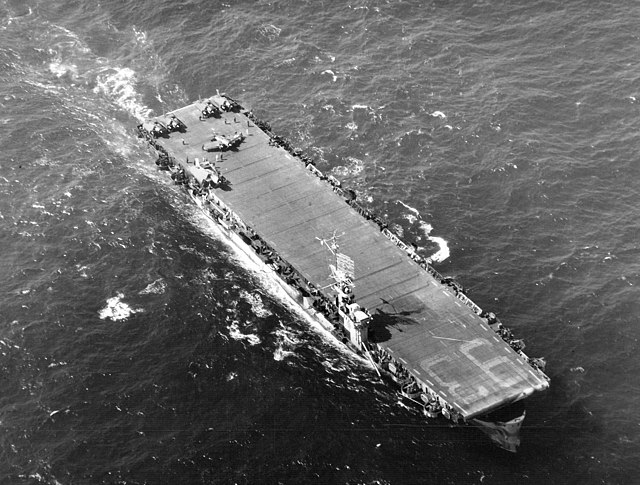 UNITED STATES NAVY DEPARTMENT COMMUNIQUES, N. D. COMMUNIQUÉ NO. 581, FEBRUARY 28, 1945 1. The submarines USS Escolar and USS Shark are overdue from patrol and presumed lost. 2. Next of kin of officers and crew have been notified. UNITED STATES NAVY DEPARTMENT COMMUNIQUES, CINCPOA COMMUNIQUÉ NO. 282, FEBRUARY 28, 1945 During the night of February 26‑27 (East Longitude Date) several small scale enemy attempts to infiltrate through our lines on Iwo Island were repulsed. In one sector a movement of tanks and troops was broken up by our artillery fire. A mortar support unit destroyed two enemy ammunition dumps during the night and gunfire from cruisers and destroyers offshore continued to harass the enemy. Marines launched an attack on the morning of February 27 after preparation by Marine artillery, Naval gunfire and carrier aircraft bombing. By nightfall limited advances had been made by the Third Marine Division in the center and the Fourth Marine Division on the right flank. Enemy artillery and mortar fire was heavy throughout the day, some of it falling on our rear areas and on the beaches. Carrier aircraft and Naval guns continued to support the ground troops. Seventh Army Air Force Liberators of the Strategic Air Force, Pacific Ocean Areas, bombed enemy positions on Iwo Island during the afternoon. Improved beach conditions continued to facilitate unloading of supplies. The extent of the enemy's defense preparations on Iwo Island is indicated by the total of 800 pillboxes of various types which have been scouted in the Third Marine Division zone of action. On February 25, Seventh Army Air Force Liberators operating under the Strategic Air Force Pacific Ocean Areas, bombed the airfield on Chichi Jima in the Bonins. Fighters and Torpedo planes of the Fourth Marine Aircraft Wing destroyed a bridge and other installations on Babelthuap in the Palaus and destroyed warehouses on Yap in the western Carolines on February 27. UNITED STATES NAVY DEPARTMENT COMMUNIQUES, CINCPOA COMMUNIQUÉ NO. 283, FEBRUARY 28, 1945 The Marines on Iwo Island made an advance of several hundred yards In most sectors of the lines on February 28 (East Longitude Date). Driving through the center of the enemy's main line of resistance, the Third Marine Division moved beyond the village of Motoyama on the island plateau. The Fifth Division on the west, led by tanks and the Fourth Division on the east, pushed forward several hundred yards against stiff opposition. The attack was supported by Naval gunfire, Marine artillery and carrier aircraft. Some mortar fire fell on our northern beaches during the day but facilities for unloading continued to develop. The attack was made after a night of light activity. The enemy attempted infiltration with small groups which were driven off and our mortar support units and fleet surface units maintained harassing fire and illumination fire throughout the night. At 1800 on February 26, 4,784 enemy dead had been counted and 10 prisoners of war taken. On February 27 carrier aircraft attacked the seaplane base on Chichi Jima in the Bonins causing an explosion. Fighters and torpedo planes of the Fourth Marine Aircraft Wing made bombing and rocket attacks on enemy‑held bases in the Palaus on February 27 and 28. Several fires were started, one bridge was destroyed, and a bridge and pier were damaged. PACIFIC USAAF B-24s attack Japanese convoy in Okinawa area, sinking motor sailship No.7 Kokoku Maru.
|
|
lordroel
Administrator
Member is Online
Posts: 68,022 
Likes: 49,423
|
Post by lordroel on Mar 1, 2024 6:02:50 GMT
Day 1998 of World War II, March 1st 1945Eastern FrontIn Pomerania, the northward attacks of 1st Belorussian Front (Zhukov) forces achieve a breakthrough north of Arnswalde and move on in the Kolberg direction. Units of Heeresgruppe Mitte (Schörner) recapture Lauban in Lower Silesia. Western Front (1945) - Western Allied invasion of GermanyMap: HQ Twelfth Army Group situation map, March 1st 1945 Munchen-Gladbach and Neuss fall to the US 9th Army, which is now advancing rapidly toward the Rhine. The attacks of US 1st Army toward Cologne are continuing as are the efforts of US 3rd Army near the River Kyll and south of Trier. Photo: View of a damaged building in Bitburg, Germany, 1 March 1945. Note the incription on the wall in the foreground: "Hitler bringt Brot, Stalin den Tod!" (= Hitler brings bread, Stalin (brings) the death!)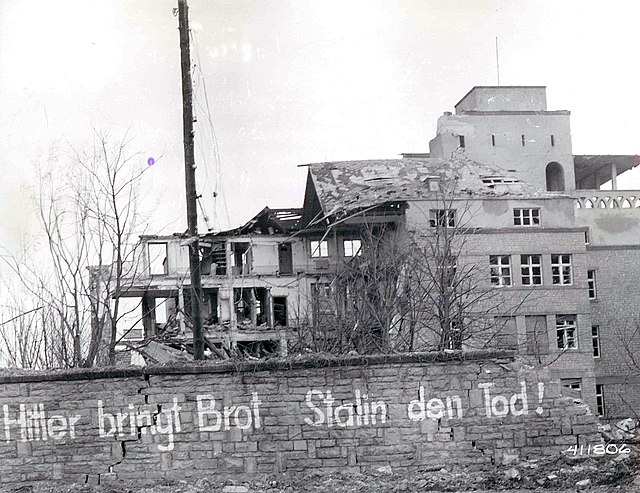 Canadian forces lead an assault on the northern end of the Schlieffen line, in Hochwald Forest. Air War over Europe (US Eighth Air Force): 2 missions are flown. Mission 857: 1,228 bombers and 488 fighters are dispatched to attack marshalling yards in C and S Germany; 3 plants suspected of manufacturing Me 262 jet engine parts could not be attack due to clouds; most attacks are made using H2X radar; the fighters claim 12-0-8 Luftwaffe aircraft; 7 P-51s are lost: 1. 452 B-17s are sent to hit marshalling yards at Bruchsal (115), Reutlingen (69), Neckarsulm (85), Heilbronn (107) and Gottingen (36); 25 hit Heidelberg, the secondary target; some visual attacks are made; 27 B-17s are damaged. Escorting are 92 of 100 P-51s; 2 are lost (pilots MIA) and 2 damaged beyond repair. 2. 253 of 321 B-24s bomb the Ingolstadt marshalling yard; 62 others hit the secondary target, Augsburg; 1 B-24 is damaged beyond repair. 181 of 194 P-51s escort claiming 1-0-0 aircraft in the air; 1 P-51 is lost (pilot MIA). 3. 420 of 449 B-17s hit the marshalling yard at Ulm; 2 others hit a target of opportunity; some attacks are visual; 2 B-17s are damaged beyond repair and 3 damaged; 16 airmen are KIA and 2 WIA. The escort is 147 of 152 P-51s; they claim 1-0-0 aircraft in the air and 9-0-7 on the ground; 3 P-51s are lost (pilots MIA). 4. 6 B-24s fly a screening mission without loss. 5. 31 of 32 P-51s fly a scouting mission. 6. 9 of 10 P-51s escort 8 F-5s on a photo reconnaissance mission over Germany. Mission 858: 11 B-24s drop leaflets in the Netherlands and Germany. (US Ninth Air Force): In Germany, 340+ B-26s, A-20s and A-26s attack the ordnance depot at Giessen, communications centers at Pulheim, Rheinbach, Rommergkirchen, and Stommeln, the rail bridge at Pracht, a road bridge, and 8 targets of opportunity; fighters escort the bombers, fly alerts, scheduled patrols, and armed reconnaissance, hit assigned ground targets and support the US 3d Armored Division at the Erft River bridgehead near Paffendorf, the 9th Armored Division between Neffelbach and Rotbach Creeks, the XIX Corps in the Monchen-Gladbach area, the VIII Corps astride the Prum River, the XII Corps between the Prum and Nims Rivers and along the Kyll River, and the XX Corps in the Trier area; and in the Netherlands, the XVI and XIII Corps in the Venlo area and along the Niers River. During Mar 45, HQ IX Fighter Command moves from Verviers, Belgium to Bruhl, Germany. (Fifteenth Air Force): In Austria, 630+ B-24s and B-17s bomb the Moosbierbaum oil refinery and alternate targets and targets of opportunity including marshalling yards at Sankt Polten, Amstetten, Villach, Klagenfurt, Knittelfeld, Feldbach, and the marshalling yards at Jesenice and Maribor, Yugoslavia, plus several scattered targets of opportunity; 220+ fighters provide escort; 22 P-38s bomb the Moosbierbaum refinery and Tulln marshalling yard (afterward 12 of them strafe the Wiener-Neustadt-Gloggnitz) rail lines); 47 other P-38s strafe rail traffic around Graz and W of Vienna. 478 RAF aircraft - 372 Lancasters, 90 Halifaxes, 16 Mosquitos - of Nos 1, 6 and 8 Groups to Mannheim in Bomber Command's last large-scale raid on the city. 3 Lancasters lost. This was a general attack on the city area. Skymarking was used because of the complete cloud cover. No details of the raid are available. 151 RAF Lancasters of No 3 Group attacked an oil plant at Kamen through cloud. 55 RAF Mosquitos to Berlin, 40 to Erfurt and 3 on nuisance raids over Northern Germany, 32 RCM sorties, 13 Mosquito patrols. No aircraft lost. Kommodore Wolfgang Falck is given an assignment, commanding fighters in the Rhineland. Falck sets out to find his Headquarters or his staff. From this date to the time he is captured he drives around southern Germany but he never does find his HQ or personnel. Italian campaign (US Twelfth Air Force): In Italy during the night of 28 Feb/1 Mar, A-20s fly intruder missions against targets at Lecco and in the Parma area, starting large fires and causing several explosions during a strike on the Casarsa delta Delizia temporary railroad bridge, and hit bridges at Nervesa delta Battaglia and Sacile; weather cancels all daytime operations except for reconnaissance and supply runs. Africa-Middle East TheaterUS Army Forces in the Middle East (USAFIME) takes over NW Africa from MTO US Army and is redesignated the Africa-Middle East Theater (AMET). United StatesPresident Roosevelt, back from the Yalta Conference, proclaimed the meeting a success as he addressed a joint session of Congress. Pacific WarCHINA (Fourteenth Air Force): In China, 6 B-25s and 5 P-51s pound the S side of Ishan while 17 other P-51s hit the E and W sections of the city; 9 P-51s attack targets of opportunity of Chinchengchiang while 4 others hit troops and road traffic between Chinchengchiang and Hwaiyang. During Mar 45, the detachment of the 11th Bombardment Squadron (Medium), 341st BG (Medium), operating from Laowhangpin with B-25s returns to base at Yangkai; the 26th Fighter Squadron, 51st FG, based at Kunming with P-51s sends a detachment to operate from Liangshan during the month; the 74th Fighter Squadron, 23d FG, based at Luliang with P-51s sends a detachment to operate from Tushan until Aug 45; the 426th Night Fighter Squadron, Fourteenth AF (attached to 312th Fighter Wing), moves from Chengtu to Shwantliu with P-61s (a detachment is operating from Hsian); and the 449th Fighter Squadron, 51st FG, based at Chengkung with P-38s, sends a detachment to operate from Mentsz while the detachment at Yunnani returns to base. MARIANAS ISLANDS (Twentieth Air Force): HQ 444th BG (Very Heavy) begins a movement from Dudhkundi, India to the Marianas. INDIA-BURMA (Tenth Air Force): In Burma, 27 P-47s support ground forces in the Mogok area; 16 fly close support strikes near Lashio; 14 P-47s damage the approaches of the bypass bridge at Na-lang, but leave the bridge serviceable; about 100 fighter-bombers attack troops, supply areas, communications targets, a ferry landing, and general targets of opportunity along the battlefronts and immediately behind Japanese lines. Large-scale transport operations continue. GUAM (Seventh Air Force): HQ VII Fighter Command is removed from control of Seventh AF and transferred to AAFPOA and moves from Ft Kamehameha, Oahu, Hawaii to Iwo Jima during Mar 45. 7 B-24s from Guam bomb Susaki Airfield; 1 other hits Haha Jima; during the night of 1/2 Mar, 5 B-24s make separate harassment strikes on Susaki Airfield and the town of Okimura on Haha Jima. SOUTHWEST PACIFIC AREA [Far East Air Force]: In Formosa, B-24s bomb the Takao aluminum plant, Tainan Airfield and nearby satellite field and fighters hit buildings at Keishu and storage tanks, railroad yards, and targets of opportunity. Troops on Corregidor and W of Ft Stotsenburg are hit with napalm. In Borneo, B-24s bomb Tarakan, Labuan, and Manggar Airfields. B-25s hit Zettle Field. HQ Thirteenth AF moves from Morotai , Moluccas s to Leyte , Philippine s and HQ XIII Fighter Command moves from Leyte to Puerto Princesa. HQ 18th FG moves from Lingayen Airfield to San Jose; the 531st Bombardment Squadron (Heavy), 380th BG (Heavy), moves from Darwin, Australia to San Jose, Mindoro with B-24s. During Mar 45, HQ V Bomber Command and HQ V Fighter Command moves from Mindoro to Clark Field, Luzon. JAPAN The US 5th Fleet carriers raid Okinawa. The aircraft of Task Force 58 and Fifth Fleet surface ships bombard several islands in the Ryuku Islands especially Okinawa. At the end of the day, TF 58 retires to Ulithi Atoll in the Caroline Islands. PHILIPPINE CAMPAIGN (1945) Japanese resistance in Manila is confined to a few blocks in the administrative area of the city. Nearer the landing area at Lingayen Gulf there are renewed efforts by US 1st Corps in the direction of Baguio and north along the coast. Army troops supported by naval gunfire and USAAF planes land on Lubang Island P.I. Task unit consisting of destroyer Cony (DD-508), destroyer escort Formoe (DE-509), minesweepers Sentry (AM-299) and Salute (AM-294) and two infantry landing craft (LCI), begin minesweeping and reconnaissance of Baler Bay and Casiguran Sound, Luzon, to investigate a possible fleet anchorage and determine composition of Japanese forces in the vicinity. Army scouts and interpreters are embarked for use ashore. VOLCANO AND RYUKYU ISLANDS CAMPAIGN Photo: "Coed" was loved and hated-----Depending upon the attentions which the General Sherman Tank, "Coed" gave to warriors on Iwo Jima, she was loved, by the Marines, and hated, by the enemy. Many Japs who disliked the machine are now in the private heaven where where good, dead Japs go. Left to right are the crew of "Coed" Corporal B. Skoll, Newport, Vt., driver; Private J.W. Lukac, Springdale, Pa., assistant driver; Corporal E.L. Randall, Oak Park, Ill., gunner; Corporal J.E. Schutt, Miami Beach, FL., loader; and Sergeant R.A. Grotenhuis, Los Angeles, Cali., tank commander, of the Marine tank, 1 March 1945 Photo: Three Marines survey a sulphur pit on Iwo Jima after high explosives demolished most of it. In caves near the pit, the Japs were still resisting, 1 March 1945 Photo: Three Marines survey a sulphur pit on Iwo Jima after high explosives demolished most of it. In caves near the pit, the Japs were still resisting, 1 March 1945 UNITED STATES NAVY DEPARTMENT COMMUNIQUES, N. D. COMMUNIQUÉ NO. 582, MARCH 1, 1945 1. The USS Extractor, a small salvage vessel, was sunk in the Central Pacific Area by a United States submarine. The sinking, which occurred in the early morning just prior to sunrise, was the result of incorrect identification by the submarine. The survivors were rescued by the attacking submarine, which made a thorough search of the area upon discovering the error made. There were six men reported missing. 2. The USS Serpens, a cargo ship manned by Coast Guard personnel, has been lost in the South Pacific Area as the result of enemy action. 3. The LCI (L) 600 has been lost in the Central Pacific Area as the result of enemy action. 4. The next of kin of casualties of the above mentioned vessels have been informed. UNITED STATES NAVY DEPARTMENT COMMUNIQUES, CINCPOA COMMUNIQUÉ NO. 284, MARCH 1, 1945 U. S. Marines on Iwo Island advanced northward on March 1 (East Longitude Date) occupying the Western end of the Island's northern airstrip moving our lines in the Western and Central sectors forward and making smaller gains on the Eastern side of the Island. The enemy continues to offer stiff opposition. The attack was made after intense shelling by Marine artillery and Naval guns. Carrier aircraft supported the ground troops during the day. Seventeen prisoners of war were taken by Marines in the Third Division zone of action. Occasional artillery fire fell on parts of the beaches but unloading proceeded. During early morning hours of March 1, a small group of enemy aircraft entered the Iwo area and dropped bombs which caused no damage. One bomber was shot down by ships' antiaircraft fire. Harassing attacks were carried out by carrier aircraft on enemy Installations on Chichi Jima in the Bonins on the night of February 28‑March 1. During the week of February 18 to February 24, mopping up operations continued in the Marianas and Palaus. Thirty‑seven of the enemy were killed and 52 captured on Saipan. On Guam 35 were killed and 11 taken prisoner. Seven of the enemy were killed and two taken prisoner on Tinian. Two prisoners were taken on Peleliu. Fighters and torpedo planes of the Fourth Marine Aircraft Wing started fires and destroyed a bridge in the Palaus on March 1. Corsairs of the Fourth Aircraft Wing bombed and strafed buildings, small craft and airfields at Ponape in the Carolines on February 28. Marine aircraft continued neutralizing raids on enemy‑held bases in the Marshalls on the same date. PACIFIC TF 58 (Vice Admiral Marc A. Mitscher) planes pound Japanese ground installations, airfields, and shipping in the Okinawa area. TF 58 planes sink torpedo boat Manazuru off Okinawa, 26°17'N, 127°35'E; minelayer Tsubame and damage escort destroyer Fukue and auxiliary minesweeper Nuwajima off Ishigaki Jima, 24°23'N,124°12'E; supply ship Kinezaki and army cargo ship No.11 Hoshi Maru in Kuji Bay, 28°10'N, 129°05'E; gunboat Chohakusan Maru and merchant cargo ship Ryukyu Maru off Naha, transport Toyosaka Maru off Miyako-retto, 24°46'N, 125°30'E; cargo ships Kinzan Maru off Okinawa, merchant cargo ships Taiken Maru off Miyako Jima and Luzon Maru off Naze. They also sink cargo ship Kiku Maru and damage torpedo boat Tomozuru and minesweeper Seki Maru off Amami-O-Shima, and damage submarine chaser Ch 49 off Ishikiri, Suwanose Island. Japanese merchant ships Dosei Maru and Otsu Maru are sunk by gunfire in Kuji Bay and off Miyako Jima, respectively. Photo: The U.S. Navy destroyer USS McKee (DD-575) underway in the waters near Okinawa on 1 March 1945, while operating with Task Force 58 Photo: The U.S. Navy destroyer USS Halligan (DD-584) pulling away after delivering mail to the escort carrier USS Sargent Bay (CVE-83) on 1 March 1945, during the Iwo Jima Operation. She is painted in Camouflage Measure 32, Design 1D Photo: The U.S. Navy destroyer USS Halligan (DD-584) pulling away after delivering mail to the escort carrier USS Sargent Bay (CVE-83) on 1 March 1945, during the Iwo Jima Operation. She is painted in Camouflage Measure 32, Design 1D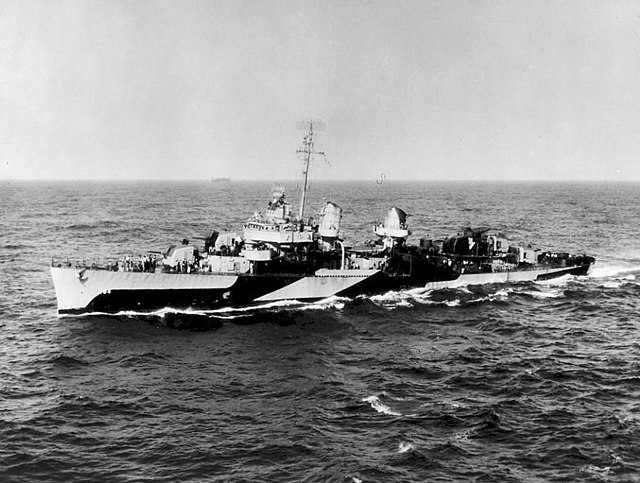 Photo: The U.S. Navy destroyer escort USS John C. Butler (DE-339) coming alongside the escort carrier USS Sargent Bay (CVE-83), on 1 March 1945 Photo: The U.S. Navy destroyer escort USS John C. Butler (DE-339) coming alongside the escort carrier USS Sargent Bay (CVE-83), on 1 March 1945 USAAF B-25s (5th Air Force) sink Japanese transport Hokuhi Maru off Mako, Pescadores, 23°35'N, 119°35'E. Submarine Kete (SS-369) departs Guam for second war patrol. Contact will be maintained with her until 20 March, but she is never seen again.[6] Off Iwo Jima, destroyers Terry (DD-513) and Colhoun (DD-801) are damaged by shore battery fire, 24°47'N, 141°21'E; medium landing ship LSM-59 by operational casualty. Submarine Sterlet (SS-392) sinks Japanese army cargo ship Tateyama Maru, 34°11'N, 139°44'E. USAAF B-24s attack Japanese convoy, damaging tanker Terushima Maru and cargo vessel Kashima Maru, 19°51'N, 108°50'E. USAAF B-24s (14th Air Force) sink Japanese merchant vessel tanker Eisho Maru in Tonkin Gulf, 18°32'N, 108°11'E. Japanese merchant ship Daishin Maru is sunk by aircraft off Manila. Japanese merchant vessel cargo ship Eijo Maru is sunk by grounding in Shihtao Bay, off Shantung Peninsula, 36°09'N, 120°30'E. Japanese army cargo ship Daia Maru is damaged by aircraft.
|
|
lordroel
Administrator
Member is Online
Posts: 68,022 
Likes: 49,423
|
Post by lordroel on Mar 2, 2024 15:10:43 GMT
Day 1999 of World War II, March 2nd 1945YouTube (Allied Deception Surrounds Japanese in BurmaWestern Front (1945) - Western Allied invasion of GermanyMap: HQ Twelfth Army Group situation map, March 2nd 1945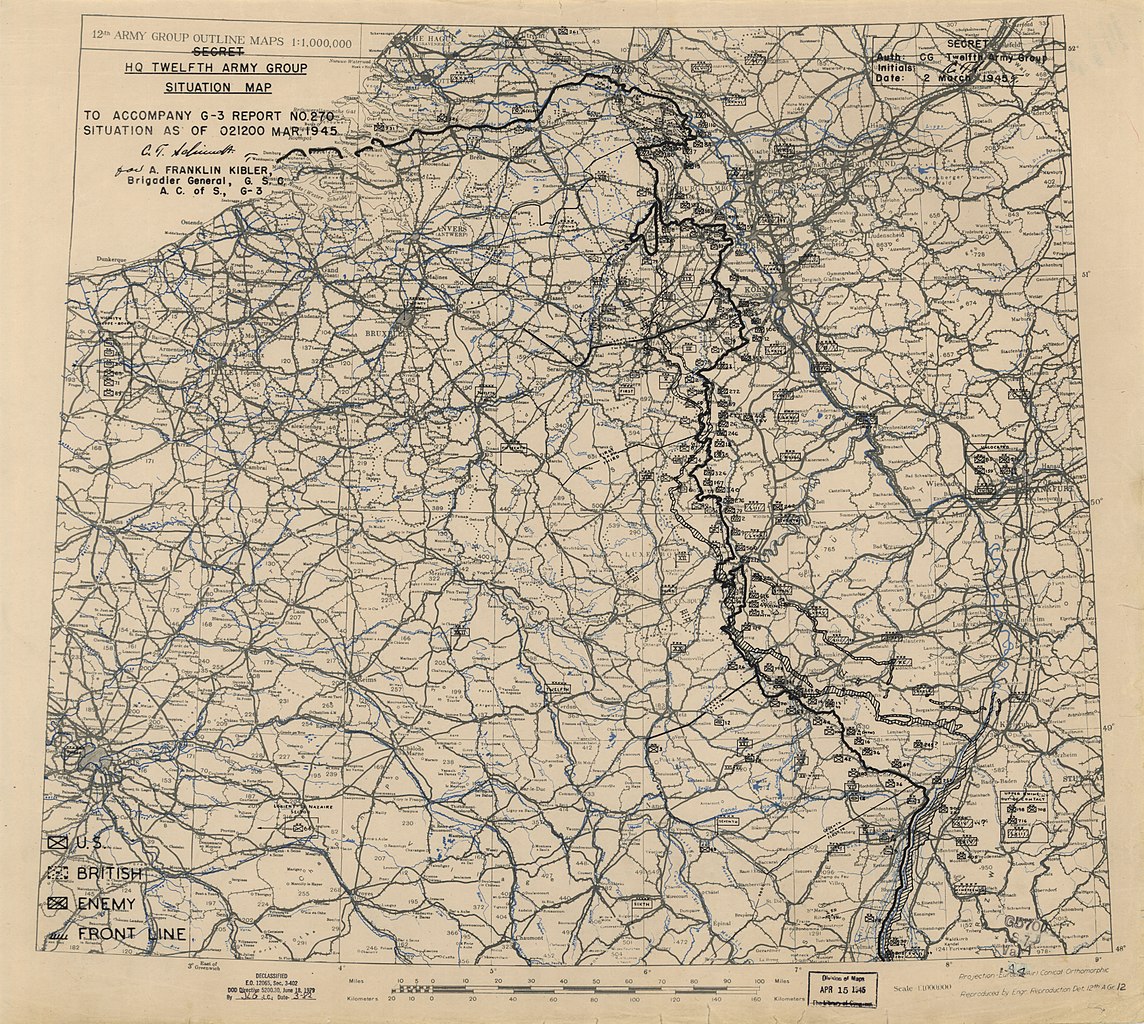 Trier is captured by units of US 20th Corps, part of US 3rd Army. The US 1st Army, to the north, is extending its advance beyond the Erft River toward Cologne and to the south. Photo: Treadway M2 Bridge built by the U.S. Army 1139th Engineer Combat Group across the Saar River at Schoden, Germany, 2 March 1945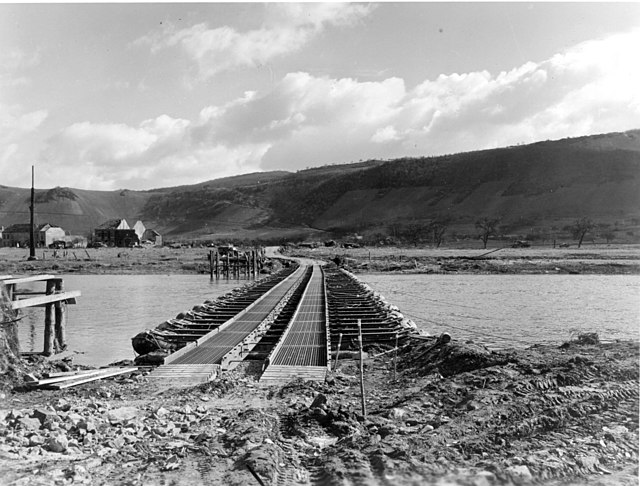 Photo: Infantrymen of 10th Armored Division kick open door in newly captured Trier, Germany, on the lookout for hidden snipers. 2 March, 1945 Photo: Infantrymen of 10th Armored Division kick open door in newly captured Trier, Germany, on the lookout for hidden snipers. 2 March, 1945 Photo: Infantrymen of 10th Armored Division dash along main street in newly-captured town of Trier, Germany. 2 March, 1945 Photo: Infantrymen of 10th Armored Division dash along main street in newly-captured town of Trier, Germany. 2 March, 1945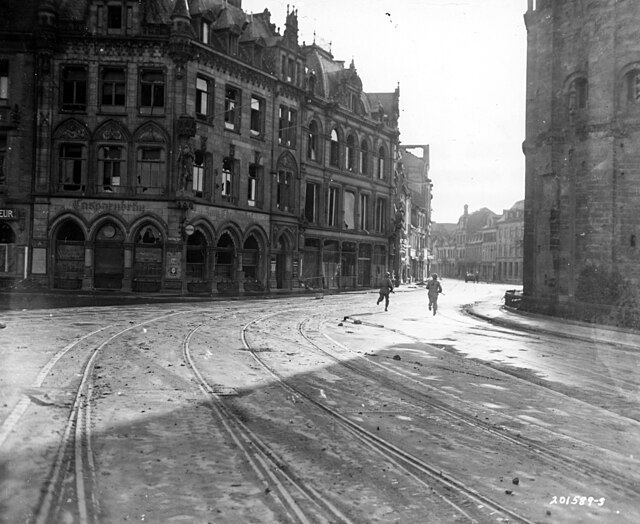 Western Front (1945) - Liberation of the Netherlands Western Front (1945) - Liberation of the NetherlandsUS 9th Army captures Roermond and Venlo on the Maas on the left flank of its advance while on the right, the Rhine River is reached opposite Dusseldorg. Photo: 35th Infantry Division troops move through Venlo, Holland. 2 March, 1945 Photo: German prisoners are escorted by men of the 35th Infantry Division task force which liberated Venlo, Holland. 2 March, 1945 Photo: German prisoners are escorted by men of the 35th Infantry Division task force which liberated Venlo, Holland. 2 March, 1945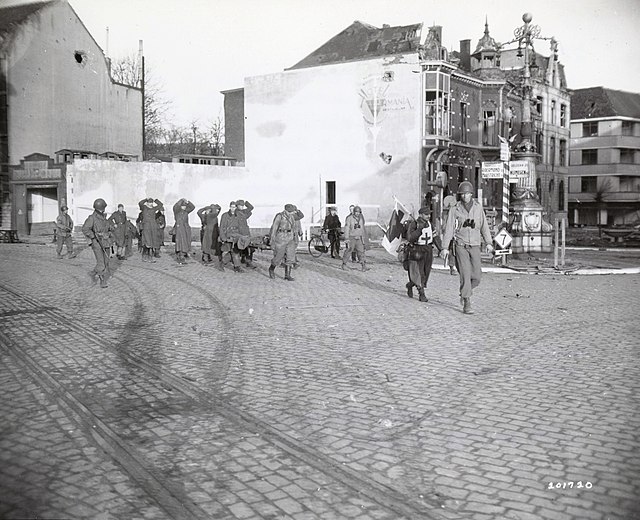 Photo: Men of a task force of the 35th Infantry Division ride in jeeps along the bank of the Maas river in Venlo, Holland, 2 March 1945 Photo: Men of a task force of the 35th Infantry Division ride in jeeps along the bank of the Maas river in Venlo, Holland, 2 March 1945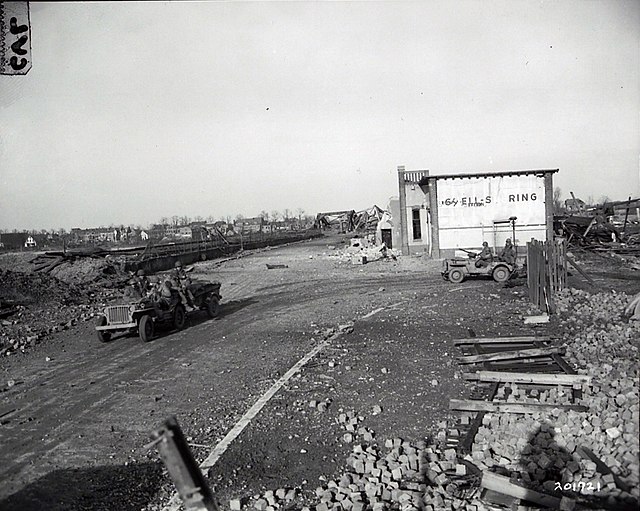 Air War over Europe Air War over Europe (US Eighth Air Force): 2 missions are flown. Mission 859: 1,232 bombers and 774 fighters are dispatched to hit synthetic oil plants and a tank factory in Germany; most attacks are made using H2X radar; they claim 110.5-9-60 Luftwaffe aircraft; 14 bombers and 13 P-51s are lost: 1. 450 B-17s are sent to hit an oil plant at Bohlen (60), oil refinery at Rositz (36) and gun batteries at Bohlen (36); 255 hit the secondary target, Chemnitz; targets of opportunity are Penig (12), Saalfeld (13), Jocketa (12), Cologne (1) and other (12); some attacks are made visually; they claim 2-0-1 aircraft; 3 B-17s are lost, 1 damaged beyond repair and 52 damaged; 1 airman is KIA, 4 WIA and 29 MIA. Escorting are 254 of 272 P-51s; they claim 7.5-1-4 aircraft in the air and 0-0-6 on the ground without loss. 2. 321 B-24s are dispatched to hit the Rothensee oil plant (38) and Buckau tank factory (257) at Magdeburg; 4 others hit a target of opportunity; some attacks are made visually; 3 B-24s are lost and 61 damaged; 1 airman is KIA and 28 MIA. The escort is 187 P-47s and P-51s; they claim 5-2-0 aircraft in the air; 2 P-51s are damaged beyond repair. 3. 455 B-17s are sent to hit the oil plant at Ruhland (24); 406 hit the secondary, Dresden; 1 other hits a target of opportunity; they claim 6-3-10 aircraft; 8 B-17s are lost and 53 damaged; 1 airman is KIA, 2 WIA and 72 MIA. 225 of 249 P-51s escort; they claim 54-3-16 aircraft in the air and 36-0-23 on the ground; 13 P-51s are lost (pilots MIA). 4. 6 B-24s fly a screening mission. 5. 25 of 28 P-51s fly a scouting mission without loss. 6. 22 of 23 P-51s escort 14 F-5s and 4 Spitfires on photo reconnaissance missions over Germany without loss. Mission 860: 11 of 12 B-24s drop leaflets in the Netherlands and Germany without loss and 4 B-24s fly CARPETBAGGER missions. (US Ninth Air Force): In Germany, the 9th Bombardment Division hits 5 bridges, 2 communications centers, 3 ordnance and motor transport depots, several city areas, and 6 targets of opportunity; the objectives are to hinder movement of enemy troops trying to help the German army caught in front of the US Third Army, to obstruct movement in general, and to damage enemy repair and refitting capabilities; 1,700+ fighters escort the bombers, hit special targets, fly armed reconnaissance and patrols, and support the US 3d Armored Division at expanding the bridgehead on the Erft River, the XVI and XIX Corps in the Sevelen, Monchen-Gladbach, and the Neuss area, and the VIII, XII, and XX Corps E of the Prum River, astride the Kyll River, and in the Trier-Saarburg area. (US Fifteenth Air Force): In Austria, 470 B-24s and B-17s, with fighters flying escort, bomb marshalling yards at Linz, Sankt Polten, Amstetten, Graz, and Knittelfeld, and Brescia, Italy; 31 P-51s on a strafing mission attack rail and river communications from Linz to Regensburg, Germany, while 18 others fly top cover; F-5s fly reconnaissance missions. During the night of 1/2 Mar, B-24s drop supplies in N Italy and C Yugoslavia. 858 RAF aircraft - 531 Lancasters, 303 Halifaxes, 24 Mosquitos - raided Cologne in 2 waves. 6 Lancasters and 2 Halifaxes were lost and 1 Halifax crashed in Belgium. The first raid was carried out by 703 aircraft and the second by 155 Lancasters of No 3 Group. In the second raid, however, only 15 aircraft bombed, because the G-H station in England was not working correctly. The main raid was highly destructive, with the Pathfinders marking in clear weather conditions. This was the last RAF raid on Cologne, which was captured by American troops 4 days later. Italian campaign (US Twelfth Air Force): In Italy, weather again grounds the medium bombers; fighter-bombers and fighters hit communications, ammunition and stores dumps, 2 sugar refineries, guns, vehicles, and buildings S of Bologna and in the Po Valley, and the airfield at Aviano and Lonate Pozzolo. Photo: Churchill tank of 'C' Squadron, North Irish Horse carrying Italian infantry of 3rd Battalion, 21st Infantry (Italian), north of Castel Borsetti, 2 March 1945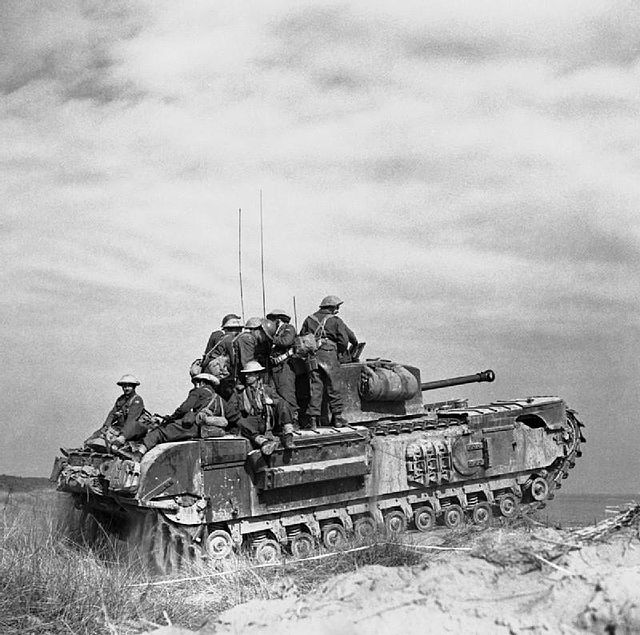 Photo: 5.5-inch gun of 70th Medium Regiment in action at Porto Cosini, 2 March 1945 Photo: 5.5-inch gun of 70th Medium Regiment in action at Porto Cosini, 2 March 1945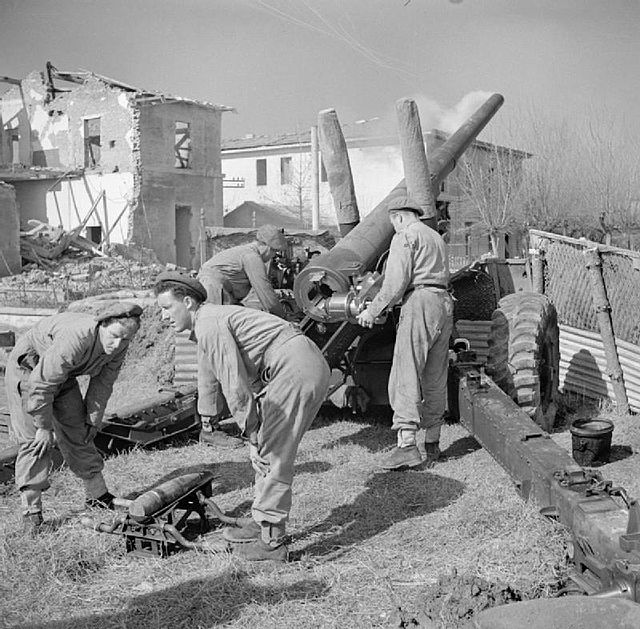 Romania RomaniaKing Michael is pressured by Soviet representatives to dismiss his government. United StatesPhoto: The U.S. Navy escort carrier USS Casablanca (CVE-55) underway at sea on 2 March 1945. She is painted in Camouflage Measure 32, Design 12A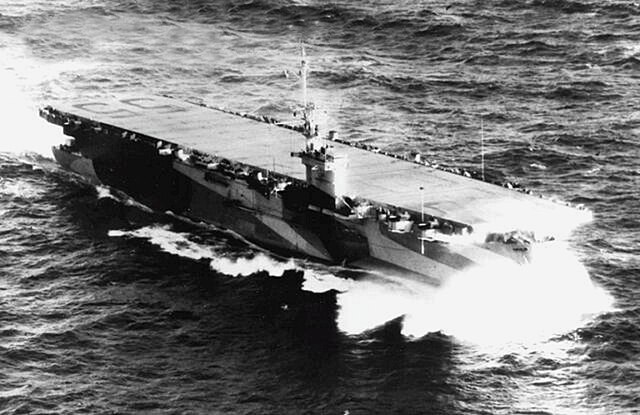 Pacific War Pacific War CHINA (Fourteenth Air Force): 3 B-24s on sweeps over the Gulf of Tonkin and the S China Sea claim 2 vessels sunk and 3 damaged. (Twentieth Air Force): Mission 41: In the Malayan States, 50 of 64 B-29s dispatched bomb the shop and warehouse area at the naval base in Singapore; 5 others hit alternates on Bukum and at Arang Hill, and at Khao Huakhang, Thailand; they claim 0-1-4 Japanese aircraft; 2 B-29s are lost. INDIA-BURMA (Tenth Air Force): In Burma, 20+ P-47s fly close support strikes in the Mogok area; 2 B-25s damage ferry slips at Li-lu while 10 others hit bridges at Tonglau, Na-lang, Mong Pawn, and Namsang; 90+ fighter-bombers attack gun positions, troops, supply areas, and highway targets of opportunity in the general battle areas and behind enemy lines. Transports complete 564 sorties to forward areas. GUAM (Seventh Air Force): 7 Guam based B-24s make a daylight raid on the airfield on Chichi Jima and 5 more bomb the same airfield and the town of Okimura on Haha Jima during the night of 2/3 Mar. VII Fighter Command: The 78th Fighter Squadron, 15th Fighter Group, arrives on Iwo Jima from Hawaii with P-51s (first mission is 10 Mar). SOUTHWEST PACIFIC AREA [Far East Air Force]: On Formosa, B-24s, B-25s, A-20s, and fighter-bombers hit Matsuyama, Toyohara, Kagi, and Kato Airfields. In Borneo, other B-24s pound Sepinggang and Manggar Airfields and the waterfront area of Sandakan. The 394th Bombardment Squadron (Heavy), 5th BG (Heavy), moves from Morotai to Guiuan Airfield with B-24s. The detachment of the 432d Fighter Squadron, 475th FG, operating from San Jose, Mindoro with P-38s, returns to base at Clark Field. PHILIPPINE CAMPAIGN (1945) The American flag is raised again over Corregidor, with General Douglas MacArthur and members of his staff present. In a speech when he left Corregidor in 1942, MacArthur praised the gallant but futile defence of Corregidor as an inspiration to carry on the struggle until the Allies should fight their way back and vowed to return one day. On February 16, 1945, elements of the U.S. Sixth Army began the assault on Corregidor, and after furious fighting, MacArthur made good on his promise. Destroyers (DesDiv 109) bombard Japanese positions on Parece Vela Reef in the Philippine Sea. VOLCANO AND RYUKYU ISLANDS CAMPAIGN Iwo Jima: The second strip on South Field airfield had been graded to 4,000 feet for fighter operations. Task group (Rear Admiral Francis E. M. Whiting), consisting of three light cruisers and eight destroyers bombards Japanese positions on Okino Daito Jima, Ryukyus. Off Iwo Jima, light cruiser Biloxi (CL-80) is damaged by shore battery fire; destroyer Bennett (DD-477), by dud bomb or torpedo; collisions account for damage to attack cargo ship Stokes (AKA-68), 24°46'N, 141°19'E; tank landing ship LST-247 [with attack cargo ship Selinur (AKA-41)], 24°46'N, 141°19'E; tank landing ship LST-224 [successive collisions with support landing craft LCS-52 and tank landing ship LST-634], 24°46'N, 141°19'E; tank landing ship LST-642 [with tank landing ship LST-784], 24°46'N, 141°19'E; and attack transport Berrien (AP-62); cargo ship Hercules (AK-41) is damaged when she runs aground; tank landing craft LCT-1029 sinks. UNITED STATES NAVY DEPARTMENT COMMUNIQUES, CINCPOA COMMUNIQUÉ NO. 285, MARCH 2, 1945 Attacking in the center of the enemy lines, the Third Marine Division drove a salient seven hundred yards deep into enemy positions and captured Hill 362 on Iwo Island on March 2 (East Longitude Date). Smaller advances were made in other sectors. The attack was launched after bombardment of enemy areas by Marine artillery, Naval guns and carrier aircraft, and it was met by intense small arms, automatic weapons and mortar fire. The Fifth Division beat off a counterattack in its zone of action. A total of 7,127 enemy dead had been counted by 1200 on March 2. Prisoners of war total 32. Destruction of enemy caves and strong points on Iwo Island is continuing. Restoration of the southern Iwo airfield is proceeding. During the night of March 1, carrier aircraft made bombing and rocket attacks on Omura town and on the airfield on Chichi Jima in the Bonins, causing an explosion and fire. Seventh Army Air Force Liberators operating under the Strategic Air Force, Pacific Ocean Areas, bombed targets on Chichi Jima and Haha Jima on March 1. Navy Search Venturas of Fleet Air Wing Two bombed and strafed airfield installations on Wake Island on March 1. Fourth Marine Aircraft Wing Corsair fighters continued neutralizing enemy held bases in the Marshalls. PACIFIC Submarine Bowfin (SS-287) sinks Japanese transport Chokai Maru northeast of Miyake Jima, 33°50'N, 139°22'E. British submarine HMS Terrapin attacks Japanese Penang-to-Singapore convoy in Malacca Straits, 03°28'N, 101°00'E, sinking small cargo vessel Sanko Maru. PB4Y-2 (VPB-119) attacks Japanese convoy, sinking transport/ferry Nichirin Maru in East China Sea about 180 miles east by south of Wenchow, China, 27°12'N, 124°42'E. Japanese transport Kasei Maru is sunk by unknown causes off Shiogama, northern Honshu. Japanese merchant cargo ship Sekiyo Maru is sunk by aircraft off Nansei Shoto. Japanese Coast Defense Vessel No.13 is damaged by aircraft, 19°47'N, 124°04'E. USAAF B-25s (5th Air Force) sink Japanese landing ship T.143 off Mako, Pescadores, 23°35'N, 121°35'E.
|
|
lordroel
Administrator
Member is Online
Posts: 68,022 
Likes: 49,423
|
Post by lordroel on Mar 3, 2024 8:41:17 GMT
Day 2000 of World War II, March 3rd 1945Eastern Front Breslau's district leader, Karl Hanke, makes a speech that is transmitted throughout Germany. He vows that the city would never surrender to the Russians under any conditions. Western Front (1945) - Western Allied invasion of GermanyMap: HQ Twelfth Army Group situation map, March 3rd 1945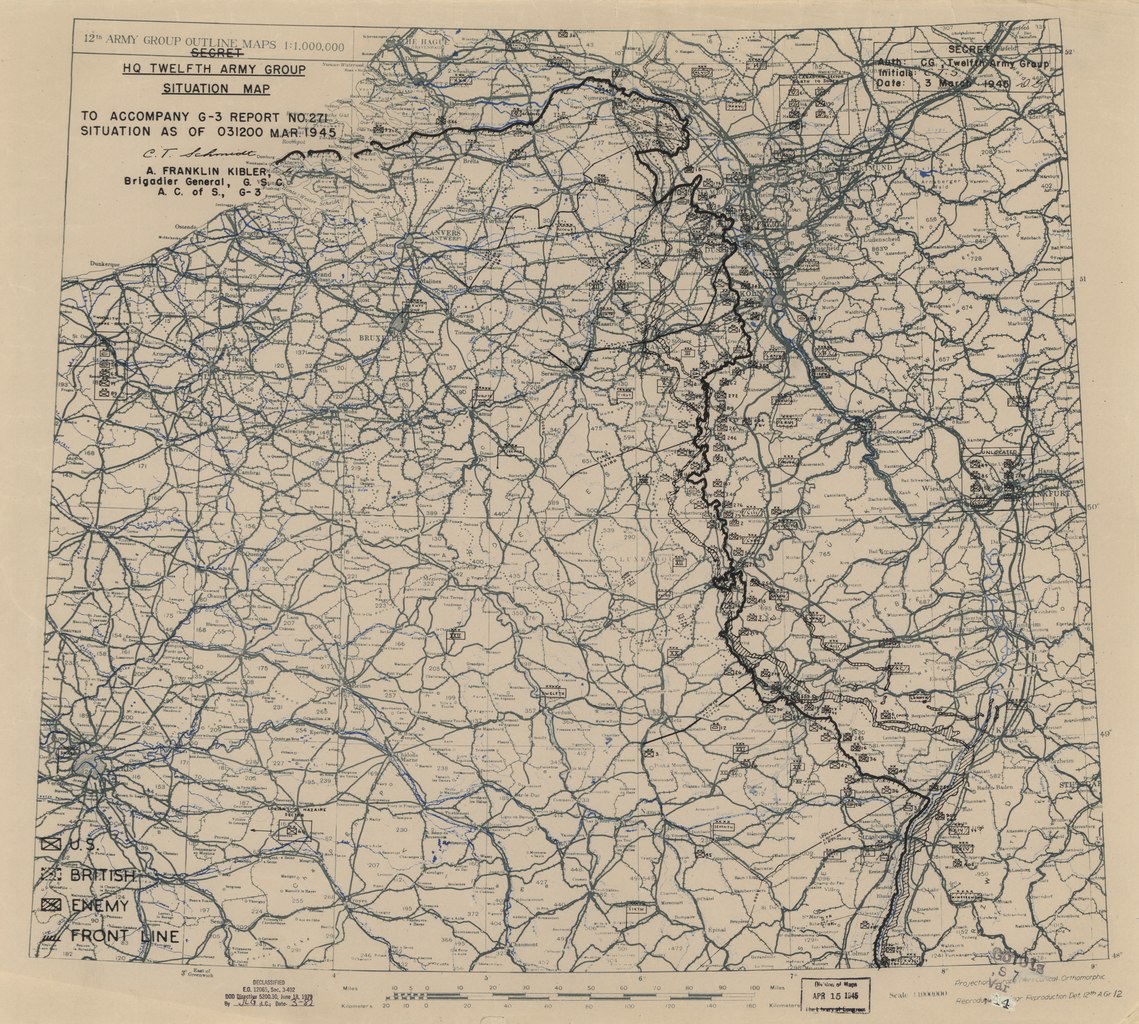 Troops of Canadian 1st and US 9th Armies link up near Geldern. Farther south, units of the US 12th Corps from US 3rd Army capture a crossing over the KyllRiver. Meanwhile, elements of the US 7th Army take Forbach. Photo: U.S. soldiers of the 3rd Chemical Mortar Battalion, U.S. Third Army, pile 4.2 inch and white phosphorous shells on a side road near Bitburg, Germany, 5 March 1945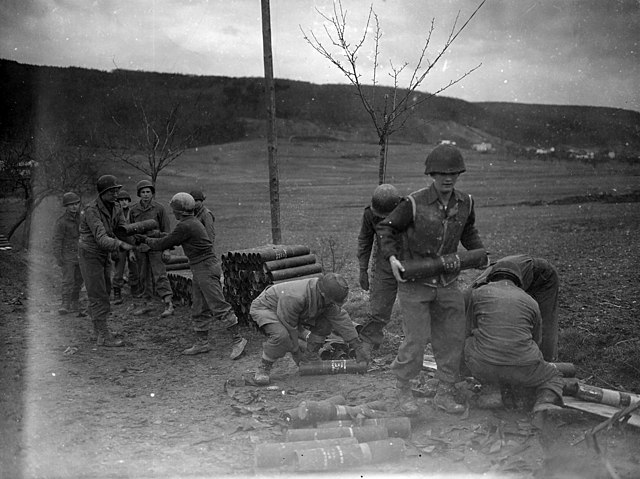 Photo: German civilians stand on the street in Krefeld, Germany, and watch the 2nd Armored Division, 9th U.S. Army troops pass by. 3 March, 1945 Photo: German civilians stand on the street in Krefeld, Germany, and watch the 2nd Armored Division, 9th U.S. Army troops pass by. 3 March, 1945 Photo: Two U.S. tank destroyers are placed on street corners commanding main streets in the town of Krefeld, Germany. 3 March, 1945 Photo: Two U.S. tank destroyers are placed on street corners commanding main streets in the town of Krefeld, Germany. 3 March, 1945 Photo: German civilians stand on the street in Krefeld, Germany, and watch the 2nd Armored Division, 9th U.S. Army troops pass by. 3 March, 1945 Photo: German civilians stand on the street in Krefeld, Germany, and watch the 2nd Armored Division, 9th U.S. Army troops pass by. 3 March, 1945 Allied troops liberate the POW camp at Forbach. Air War over Europe (US Eighth Air Force): 2 missions are flown. Mission 861: 1,102 bombers and 743 fighters are dispatched to bomb oil refineries, oil plant equipment works, motor transport factory, tank plant, and rail bridge in NC and E Germany; they claim 25-2-37 Luftwaffe aircraft; 9 bombers and 8 P-51s are lost: 1. 114 B-17s are sent to hit the oil refinery at Misburg (23); 82 hit the secondary target, the Hanomag tank factory at Hannover; and 2 hit Lemford, a target of opportunity; bombing is by H2X radar; 11 B-17s are damaged; 9 airmen are KIA and 5 WIA. Escorting are 44 of 46 P-51s; they claim 0-0-1 aircraft in the air; 1 P-51 is lost (pilot MIA). 2. 222 B-17s are sent to bomb the oil plant at Ruhland (24) and bomb visually; 166 hit the secondary target, the marshalling yard at Chemnitz using H2X; targets of opportunity are Plauen (11) and other (16); 2 B-17s are damaged beyond repair and 63 damaged. 193 of 214 P-51s escort claiming 3-0-0 aircraft in the air and 10-0-23 on the ground; 2 P-51s are lost (pilots MIA). 3. 94 B-24s are dispatched to hit the Nienburg Bridge (41); 48 hit the secondary target, the marshalling yard at Bielefeld and 1 hits a target of opportunity; attacks are visual; 3 B-24s are damaged. The escort is 19 of 21 P-51s without loss. 4. All 219 B-24s dispatched hit the Rothensee oil refinery at Magdeburg visually; they claim 1-0-0 aircraft; 4 B-24s are lost and 77 damaged; 3 airmen are WIA and 39 MIA. The escort is 129 of 144 P-51s; they claim 0-0-2 aircraft in the air; 2 P-51s are lost (pilots MIA). 5. The primary targets for 453 B-17s are the Wilke (53) and Brussing (77) oil plants and the MIAG munitions plant (61) at Brunswick and oil refineries at Dollbergen (37), Dedenhausen (53) and Nienhagen (56); 38 hit the secondary, Hildesheim (38); targets of opportunity are the marshalling yard at Bielefeld (36), Herford (23) and other (2); most attacks are visual; they claim 1-2-4 aircraft; 5 B-17s are lost and 53 damaged; 1 airman is WIA and 41 MIA. Escorting are 169 of 180 P-51s; they claim 0-0-4 aircraft in the air and 9-0-2 on the ground; 2 P-51s are lost (pilots MIA) and 1 damaged beyond repair. 6. 100 of 107 P-51s fly a fighter sweep in the Leipzig-Magdeburg area; they claim 1-0-3 aircraft in the air; 1 P-51 is lost (pilot MIA). 7. 30 of 31 P-51s fly a scouting mission. Mission 862: 18 of 24 B-24s bomb the marshalling yard at Emden using PFF. (US Ninth Air Force): In Germany, the 9th Bombardment Division hits Wiesbaden, Giessen, Bergisch Born, and Nahbollenbach ordnance and storage depots, rail bridges at Remagen and Simmern, a communications center at Heimersheim, motor transport concentration at Schwelm, the Rheinbach ammunition dump, Kirn marshalling yard and town, and several targets of opportunity; fighters fly bomber escort, hit special targets, fly patrols and armed reconnaissance, and support the US 9th Infantry Division, 3d Armored Division, and VII Corps astride the Erft River W of Euskirchen and the area near Roggendorf W of the Rhine River, the XIII, XVI, and XIX Corps E of Sevelen, NE of Krefeld, and W of the Rhine in the Dusseldorf area, and the VIII, XII, and XX Corps in the area between the Prum and Kyll Rivers and along the Mosel River in the Trier area. 234 RAF aircraft - 201 Halifaxes of No 4 Group and 21 Lancasters and 12 Mosquitos of No 8 Group repeated the attack on Kamen. No aircraft lost over Germany. The synthetic-oil refinery at Bergkamen was severely damaged in this accurate raid and no further production of oil took place. 212 RAF Lancasters and 10 Mosquitos of No 5 Group attacked the Ladbergen aqueduct on the Dortmund-Ems Canal, breached it in 2 places and put it completely out of action. 7 Lancasters lost. The gunners in the No 619 Squadron Lancaster of Wing Commander SG Birch claimed to have shot down a V-1 flying bomb near the target area; the V-1 was probably aimed at the port of Antwerp. 95 RAF training aircraft on a diversionary sweep, 64 Mosquitos to Berlin and 32 to Würzburg, 61 RCM sorties, 29 Mosquito patrols, 31 Lancasters minelaying in the Kattegat and in Oslo Fjord, 17 aircraft on Resistance operations. 1 Lancaster lost - from the minelaying operation. Total RAF effort for the night: 785 sorties, 8 aircraft lost over Germany and the sea, 20 aircraft shot down by Intruders over England, a total casualty rate of 3.6 per cent. Photo: The bombing of the Bezuidenhout area on Saturday, March 3rd, 1945. Seen from the tower of the Church of St. James the Greater in Park Street (Dutch: Parkstraat)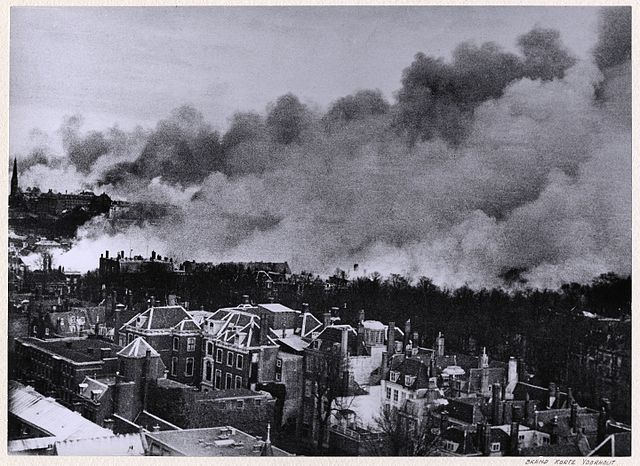 Photo: Bombardment of the Bezuidenhout neighbourhood in The Hague. Seen from the suburban village of Voorburg, probably seen from the street Staringkade. Behind the railway embankment the Schenkkade (street) at the corner of Laan van Nieuw Oost-Indië (street), March 3rd, 1945 Photo: Bombardment of the Bezuidenhout neighbourhood in The Hague. Seen from the suburban village of Voorburg, probably seen from the street Staringkade. Behind the railway embankment the Schenkkade (street) at the corner of Laan van Nieuw Oost-Indië (street), March 3rd, 1945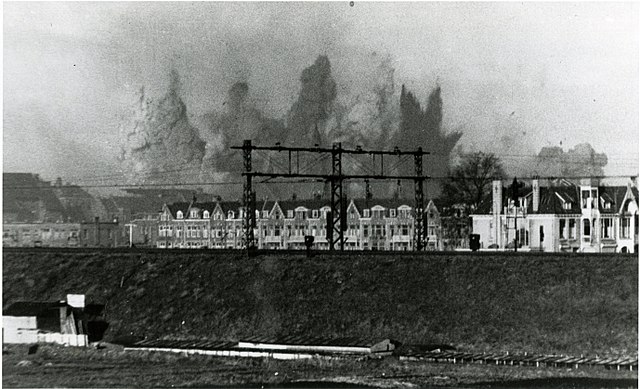 Italian campaign Italian campaign(US Fifteenth Air Force): Rapidly deteriorating weather cancels bombing operations. In Austria, P-51s strafe rail traffic between Leibnitz and SW of Spittal an der Drau and attack the airfield S of Graz; P-38s fly reconnaissance and reconnaissance escort. 1 B-24, of 6 dispatched, drops supplies in N Yugoslavia. HQ 31st Fighter Group and the 307th and 308th Fighter Squadrons move from San Severo to Mondolfo, Italy with P-51s. (US Twelfth Air Force): In Italy, overcast skies and turbulent winds hamper medium bomber missions against communications in the Brenner area, allowing only limited success against targets; the Crema and Fidenza Bridges in the Po Valley are damaged; XXII Tactical Air Command fighter-bombers, destroy a sugar refinery at Verona and achieve good results against communications and dumps in the C Po Valley and Brenner area; other fighters and fighter-bombers support the US Fifth Army S of Bologna; A-20s during the night of 2/3 Mar, hit roads, ammunition supplies, and vehicles at several points in the Po Valley, particularly in the Bologna-Modena regions, and bomb the Legnano marshalling yard. United KingdomThe Luftwaffe raid Britain for the first time in seven months. The Luftwaffe mounted Unternehmen Gisella on this night, sending approximately 200 night fighters to follow the various bomber forces to England. This move took the British defences partly by surprise and the Germans shot down 20 bombers - 8 Halifaxes of No 4 Group, 2 Lancasters of No 5 Group, 3 Halifaxes, 1 Fortress and 1 Mosquito of No 100 Group and 3 Lancasters and 2 Halifaxes from the Heavy Conversion Units which had been taking part in the diversionary sweep. 3 of the German fighters crashed, through flying too low; the German fighter which crashed near Elvington airfield was the last Luftwaffe aircraft to crash on English soil during the war. Pacific War CHINA (Fourteenth Air Force): 4 B-24s over the Gulf of Tonkin and the S China Sea attack shipping targets of opportunity, claiming 1 vessel sunk and 3 damaged. In French Indochina, 3 B-25s hit Kep, damaging several locomotives and boxcars and hit a bridge and 12 P-51s hit targets of opportunity between Vinh and Nam Dinh (2 direct hits are scored on the bridge at Minh Koi) while 2 others blast a HQ building in Hanoi. INDIA-BURMA (Tenth Air Force): In Burma, 24 P-38s and P-47s support forces of the Chinese 50th Division near Mansam; 16 support the British 36 Division in the Mogok area; 10 P-47s knock out the Na-lang bridge while 2 B-25s drop delay-action bombs in good pattern around the Loi-leng bridge; 10 B-25s join 80+ fighter-bombers in an attack on troops, supplies, tanks, trucks, gun positions, and transport elephants behind enemy lines, 29 of the fighter-bombers concentrate on the Kankang area. 643 air supply sorties are completed. BURMA Meiktila is completely occupied by units of the British 4th Corps. This effectively cuts the main route for supplies to the bulk of the Japanese forces in Burma is and compels some of the Japanese units fighting farther north, against British 33rd Corps, to turn away to try to clear their lines of communication. GUAM (Seventh Air Force): 10 B-24s from Guam pound Susaki Airfield in an afternoon strike, and 4 more, flying individual strikes, hit the same target during the night of 3/4 Mar. The 467th and 468th Fighter Squadrons, 508th FG, move from Kahuku to Mokuleai, Hawaii with P-47s. SOUTHWEST PACIFIC AREA [Far East Air Force]: In Formosa, B-24s pound the Tainan area and Kiirun while fighters hit numerous targets of opportunity and fighter-bombers bomb Koshun Airfield. B-25s, aborting a strike against Formosa, bomb the airstrip at Basco. PHILIPPINE CAMPAIGN (1945) Japanese resistance in Manila comes to an end after a month-long battle. Most of the 20,000 Japanese defenders have been killed and the town has been devastated. Troops from the Americal Division are landed on Ticao and Burias Islands to the west of the San Bernadino Strait. Army troops land on Masbate, Burias and Ticao Islands, P.I., supported by naval gunfire and USMC planes. Only small Japanese garrisons are found, requiring only minimal naval forces for support. Attack transport Bolivar (APA-34) is damaged by shore battery off Iwo Jima, 24°46'N, 141°19'E. B-25s bomb San Roque Airfield. B-24s and B-25s attack Zettle Field. Ternate on Samar and Echague and Caballo in Manila Bay are bombed by A-20s. VOLCANO AND RYUKYU ISLANDS CAMPAIGN On Iwo Jima, an area of the island which has become known as "the Mincer" is cleared by the marines of US 5th Amphibious Corps. The third airfield is completely occupied by the American. Photo: Two keen-eyed Marines, watching the smoking sulphurous area on Iwo Jima for hidden enemy riflemen, maintain vigilance against Japanese snipers from their position in the emplacement of a captured enemy five-inch cannon, 3 March 1945 UNITED STATES NAVY DEPARTMENT COMMUNIQUES, CINCPOA COMMUNIQUÉ NO. 286, MARCH 3, 1945 Without enemy air opposition carrier aircraft of the U. S. Pacific Fleet struck military, Naval and air installations and shipping in the Nansei Shoto on March 1 (East Longitude Date). Islands which came under attack were: Amami, Minami, Kume Jima, Okinawa Jima, Tokuno Jima and Okinoyerabu Jima. Our aircraft inflicted the following damage on the enemy: Aircraft: Four aircraft shot out of the air. Thirty‑seven aircraft destroyed on the ground. About 50 aircraft destroyed or damaged on the ground, some of which may have been previously in‑operational. Shipping: Sunk: One destroyer. One motor‑torpedo boat. Six small cargo ships. Two medium cargo ships. One ocean‑going tug. Two luggers. Probably Sunk: One medium cargo ship. Six small coastal cargo ships. Six luggers. Damaged: Four destroyer escorts or patrol craft. One medium transport. Four medium cargo ships. Nine small coastal cargo ships. One small cargo ship. Ten luggers. In addition, several small craft sunk or damaged. Ground Installations: On the Islands of Okinoyerabu, Amami, Minami, Okinawa, Kume and Tokuno, our aircraft destroyed or damaged airfield installations, barracks, administration buildings, mills, lumber yards, warehouses and radio and radar installations. Our losses in combat were five pilots, three aircrewmen and thirteen aircraft. During the night following the attack, the force conducted a bombardment of Okina Daito Jima starting large fires in the target area. PACIFIC Submarine Sea Robin (SS-407) sinks Japanese transport Suiten Maru off Malang, Java, 06°34'S, 113°01'E. Submarine Trepang (SS-412) sinks Japanese gunboat No.2 Nissho Maru off southern Honshu, near Mijake Jima, 34°05'N, 139°54'E. Submarine Tuna (SS-203) lands supplies on northeast coast of Borneo. USAAF B-24 sinks Japanese cargo vessel No.1 Yaei Maru in Tonkin Gulf, 20°10'N, 109°31'E. RAAF planes lay mines (70% U.S.-made, 30% British) in Yulinakin Bay, Hainan Island; Japanese oiler Hario hits one and sinks off Cape Bastian, 18°10'N, 109°40'E. Japanese merchant tanker No.1 Iyasaka Maru is sunk by aircraft off Hainan Island.
|
|
lordroel
Administrator
Member is Online
Posts: 68,022 
Likes: 49,423
|
Post by lordroel on Mar 4, 2024 3:51:14 GMT
Day 2001 of World War II, March 4th 1945Eastern FrontThe Soviet offensive in Pomerania continues to make gains especially toward the west near Stettin. There is renewed fighting in East Prussia. Western Front (1945) - Western Allied invasion of GermanyMap: HQ Twelfth Army Group situation map, March 4th 1945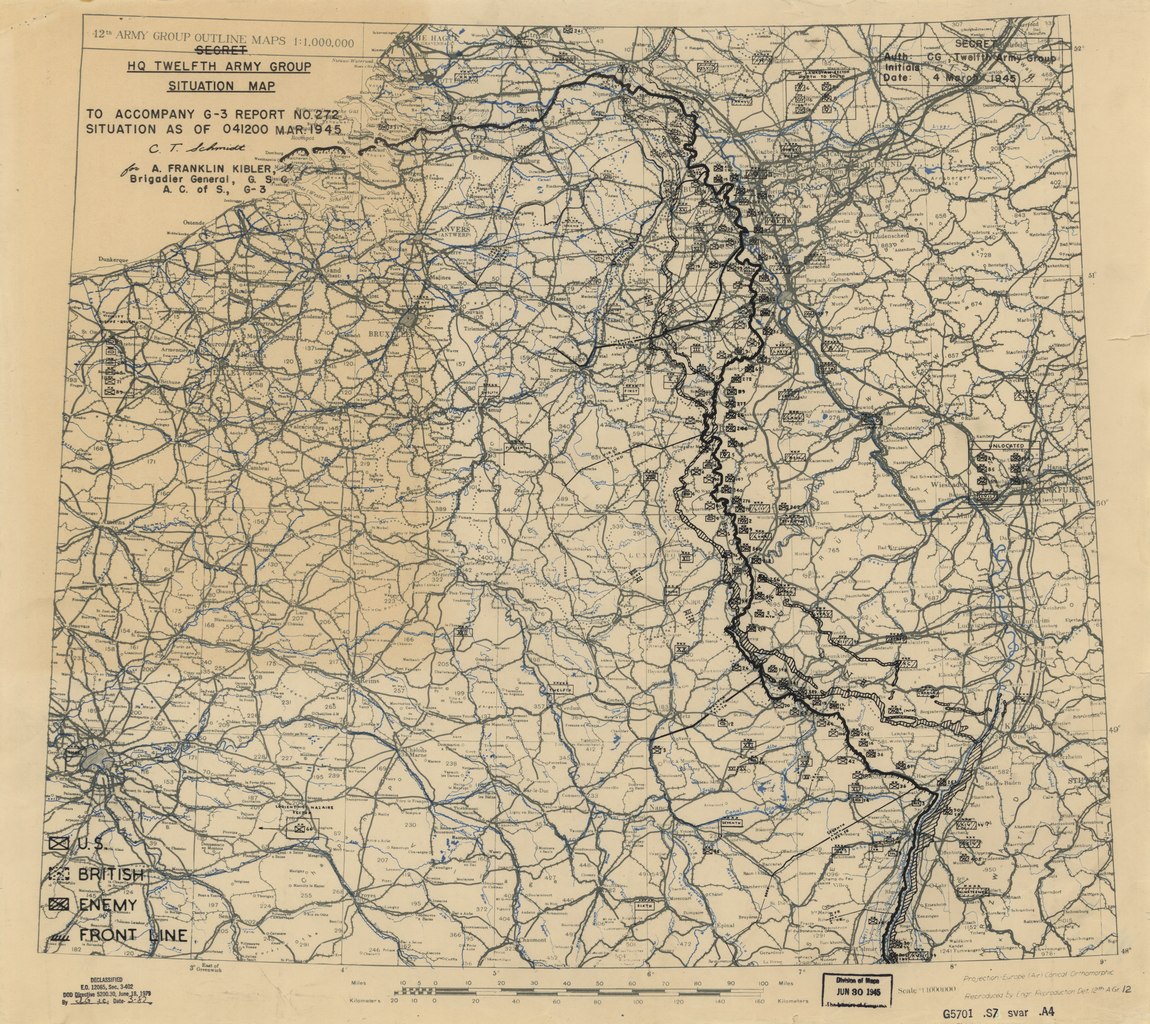 Geldern is captured by the British 30th Corps, part of Canadian 1st Army. US 1st and 9th Armies continue their advance to the Rhine River. The US 7th Corps from US 1st Army reaches the Rhine just north of Cologne. Photo: A Sherman tank of 8th Armoured Brigade in Kevelaer, Germany, 4 March 1945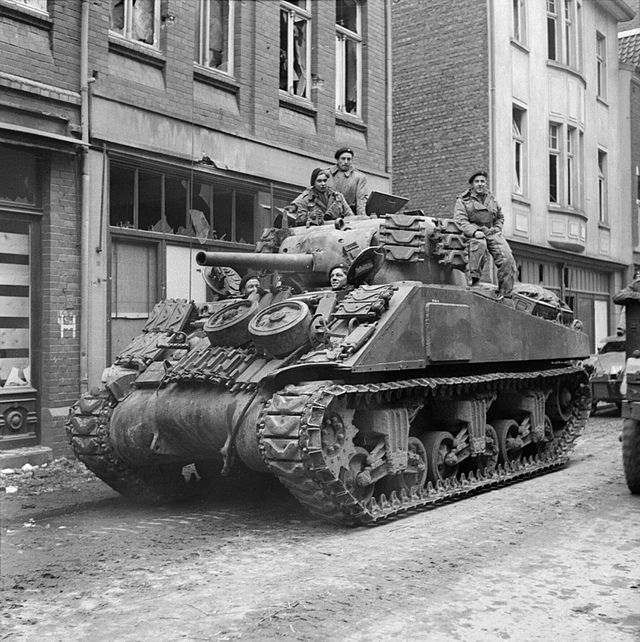 Photo: Sherman tanks and transport of 8th Armoured Brigade moving through Kevelaer, Germany, 4 March 1945 Photo: Sherman tanks and transport of 8th Armoured Brigade moving through Kevelaer, Germany, 4 March 1945 Air War over Europe Air War over Europe (US Eighth Air Force): 2 missions are flown. Mission 863: 1,028 bombers and 522 fighters are dispatched to bomb targets in SW Germany; bad weather causes 300+ aborts; 1 B-24 and 1 P-51 are lost: 1. 373 B-17s are sent to hit the jet aircraft plant at Schwabmunchen (69) and military vehicle plant and ordnance depot at Ulm (223); 59 hit the secondary, the marshalling yard at Ulm; targets of opportunity are Reutlingen (12) and other (1); bombing is by Gee-H; 2 B-17s are damaged beyond repair and 9 damaged; 3 airmen are WIA. Escorting are 150 of 156 P-51s; 1 is damaged beyond repair. 2. 274 B-24s are dispatched but weather prevents them hitting the primaries; targets of opportunity are Aschaffenburg (18), Tuttlingen (11), Astadtaach (10), Pforzheim (8), the marshalling yard at Stuttgart (11), the railroad at Sonaueschingen (10), Stuttgart (50) and other (36); bombing is by H2X radar with some visual bombing; 1 B-24 is lost and 19 damaged; 8 airmen are KIA. 139 P-47s and P-51s escort without loss. 3. 376 B-17s are dispatched but weather prevents them attacking the primaries; secondary targets hit are the marshalling yards at Ingolstadt (69) and Ulm (75); targets of opportunity are Ausbuch (1) and other (3); H2X radar is used for bombing; 2 B-17s are damaged beyond repair and 7 damaged; 17 airmen are KIA. The escort is 172 of 186 P-51s; 1 is lost (pilot MIA) and 1 damaged beyond repair. 4. 5 B-17s fly a scouting mission. 5. 21 of 22 P-51s fly a scouting mission. Mission 864: 1 B-17 and 11 B-24s drop leaflets in the Netherlands and Germany during the night without loss. (US Ninth Air Force): In Germany, about 180 B-26s, A-20s, and A-26s strike marshalling yards and a rail junction at Recklinghausen, Lenkerbeck, and Herne, communications centers at Bruhl, Sechtem, and Rheinbach, and several other targets including a rail bridge and towns; weather limits fighter operations; a few fighters fly armed reconnaissance E of the Rhine River and others fly cover for the XX Corps. 128 RAF Lancasters of No 3 Group carried out a G-H attack through cloud on Wanne-Eickel. No results were seen. 31 Mosquitos to Berlin, 24 to Essen and 28 in small numbers to 5 ports in Northern Germany, 6 Mosquito patrols, 12 Halifaxes minelaying off Heligoland, 16 aircraft on Resistance operations. 2 Stirlings on Resistance operations were lost. Italian campaign (US Fifteenth Air Force): 630+ B-24s and B-17s, with fighter escort, bomb marshalling yards at Sopron (2 yards) and Szombathely, Hungary; Knittelfeld, Zeltweg, Graz, Sankt Veit an der Glan and Wiener- Neustadt, Austria; Zagreb (2 yards) and Lbubljana, Yugoslavia; and several scattered targets of opportunity; other B-24s, with P-51 escort, drop supplies in Yugoslavia; F-5s, P-38s and P-51s fly reconnaissance and reconnaissance escort operations. The 309th Fighter Squadron, 31st Fighter Group, moves from San Severo to Mondolfo, Italy with P-51s. (US Twelfth Air Force): In Italy, good flying weather permits a full-scale effort; medium bombers hit 7 railroad bridges on the Brenner line and in NE Italy; the Salorno railroad fill receives a particularly good concentration of bombs; XXII Tactical Air Command P-47s concentrate on communications targets in the Po Valley, knocking out a span of the Cittadella railway bridge; Brazilian P-47s blast an ammunition dump at Villafranca di Verona; during the night of 3/4 Mar, A-20s bomb the bridge and bridge approaches at Casarsa della Delizia, Ostiglia, and Nervesa della Battaglia, the radar station at Vignola, and lights, motor transport, roads, and other targets of opportunity at over 30 places in the C Po Valley. Photo: A machine gunner and two riflemen of Co K, 87th Mountain Infantry, 10th Mountain Division, cover an assault squad routing Germans out of a building in the background. Sassomolare Area, Italy. Porretta Moderna Highway. 4 March 1945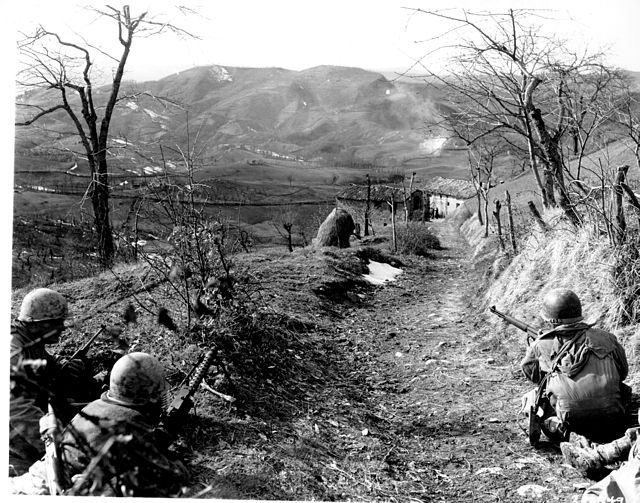 Finland FinlandThe government of Helsinki declares war on Germany. An unofficial state of war has existed since September 1944. Pacific War CHINA (Fourteenth Air Force): 4 B-24s on a sea sweep damage a destroyer escort in the S China Sea. (Twentieth Air Force): Mission 42: In China during the night of 4/5 Mar, 11 of 12 B-29s, staging from Luliang, mine the confluence of the Hwangpoo and Yangtze Rivers and the Tai-hsing Narrows at Shanghai and 1 B-29s drops mines at Tungting Lake without loss. INDIA-BURMA (Tenth Air Force): In Burma, 100 fighter-bombers attack troop concentrations, villages, roads, tanks, trucks, animal transport, and supplies along and immediately behind the battlelines running from the SW to NE across C Burma; Meiktila is largely occupied by forces of the Indian 17th Division. GUAM (Seventh Air Force): 10 B-24s from Guam bomb Susaki Airfield; during the night of 4/5 Mar, 3 B-24s make separate harassment raids on the airfield. Lieutenant General Barney Mc Giles becomes Commanding General of AAFPOA and Deputy Commander of the Twentieth AF. PHILIPPINE CAMPAIGN (1945) On Mindanao, B-24s bomb Sasa and Likanan Airfields and the town of Zamboanga. On Luzon, B-24s bomb targets of opportunity in the Cagayan Valley, gun positions, ammunition storage, and targets of opportunity at Antipolo and Wawa, supply dumps and the town area at Bamban, fortifications on Caballo in Manila Bay, and airfields at Aparri and Tuguegarao. The detachments of the 431st and 433d Fighter Squadrons, 475th FG, operating from San Jose, Mindoro with P-38s, return to base at Clark Field, Luzon. VOLCANO AND RYUKYU ISLANDS CAMPAIGN (Twentieth Air Force): Mission 39: A B-29 makes an emergency landing on Iwo Jima; this begins a series of over 2,400 such emergency landings on the island. 192 Marianas based B-29s are airborne against Musashino aircraft factory (Musashi) near Tokyo, Japan but heavy clouds prevent bombing the primary; 159 B-29s bomb the secondary target, the urban areas of Tokyo, and 18 others hit alternate targets; 1 B-29 is lost. This aborted try at Musashino marks the end of XXI Bomber Command's effort to knock out the Japanese aircraft industry by high-altitude, daylight precision bombing. (The indirect effect of causing Japanese industrialists to lose confidence in their supposed immunity from air attacks exceeds the effect of actual bomb damage to the aircraft industry). Photo: Photo caption: Iwo Jima, 4 March 1945. First to land: Marines flock around the first huge B-29 Superfortress bomber to land on the Iwo airfield. The bomber was put down on Motoyama Airfield Number One in am emergency landing. It was returning from a raid on Japan where it was crippled UNITED STATES NAVY DEPARTMENT COMMUNIQUES, CINCPOA COMMUNIQUÉ NO. 288, MARCH 4, 1945 Small local advances which left the lines substantially unchanged were made by the Marines on Iwo Island on March 4 (East Longitude Date). Enemy resistance stiffened in all sectors and small arms fire mounted in Intensity as our troops attacked. The enemy organized a counter‑attack in the Fifth Division Sector but was repulsed with the loss of several hundred men. The Fourth Division fighting over extremely difficult terrain eliminated a strong center of resistance in the morning. Hand to hand fighting was in progress in the Fifth Division zone of action where the ground is rough and naturally suited to defensive operations. The southern Iwo airfield came under scattered artillery fire during the day as evacuation planes continued to land and take off. By 1800 on March 3, a total of 12,864 enemy dead had been counted and 81 prisoners, of whom 45 are Koreans and 36 Japanese, had been captured. The guns of fleet units covered the ground troops during the night of March 3, and supported the attack on the following day. Carrier aircraft and Seventh Army Air Force Liberators operating under the strategic air force attacked Chichi Jima in the Bonins with bombs and rockets on March 3. Corsair and Hellcat Fighters of the Fourth Marine Aircraft Wing made bombing and rocket attacks on enemy held islands in the Palaus on March 3. One plane was shot down by antiaircraft fire. Marine fighters bombed Yap in the Western Carolines on the same date. Fighters of the Fourth Marine Aircraft wing and Mitchell bombers strafed and bombed airfields and other installations on Ponape in the Eastern Carolines on March 3. Navy search planes of Fleet Air Wing Two continued neutralizing attacks on enemy held bases in the Marshalls on March 3. PACIFIC Destroyers Yarnall (DD-541) and Ringgold (DD-500) are damaged in collision while simulating night torpedo attack, 12°15'N, 138°08'E. Photo: The U.S. Navy destroyer USS Yarnall (DD-541) following her collision with USS Ringgold (DD-500) during torpedo maneuvering exercises at 0508 hrs on 4 March 1945. Yarnall's bow broke off and sank at 1841 on 5 March 1945. She is painted in Camouflage measure 32, Design 2C.
The photo was taken by an aircraft of Composite Squadron 94 (VC-94) flying cover from the escort carrier USS Shamrock Bay (CVE-84)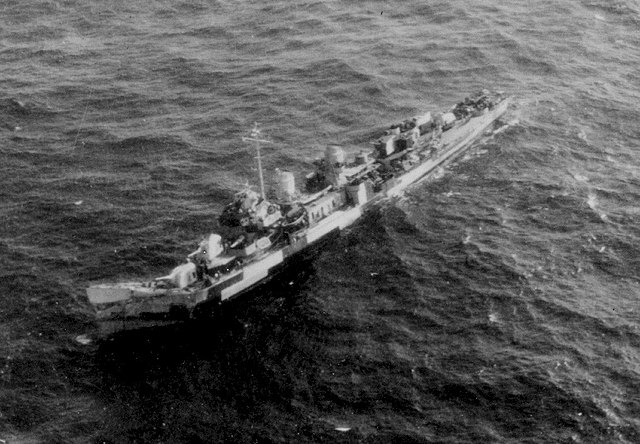 Submarine Baya (SS-318) attacks Japanese convoy HI-98, sinking merchant tanker Palembang Maru off Cape Varella, French Indochina, 12°50'N, 109°30'E (see 5 March). Submarine Tilefish (SS-307) sinks Japanese fishing vessel Shiko Maru off Setsuko Saki, 28°15'N, 129°08'E. British submarine HMS Clyde sinks Japanese auxiliary submarine chaser Kiku Maru off western Sumatra. British submarines HMS Trenchant and HMS Terrapin sink Japanese submarine chaser Ch 8 in central Malacca Strait, 04°04'N, 110°35'E. USAAF planes (14th Air Force) lay mines in Yangtze River; Japanese ship Wan Shih Maru is sunk north of Shanghai. RAAF Venturas attack Japanese convoy off Soembawa Island sinking small cargo vessels No.3 Kiri Maru and No.4 Matsu Maru, 08°17'S, 118°56'E.
|
|
lordroel
Administrator
Member is Online
Posts: 68,022 
Likes: 49,423
|
Post by lordroel on Mar 5, 2024 3:46:37 GMT
Day 2002 of World War II, March 5th 1945Eastern Front The fortress city of Graudenz on the Vistula surrenders to troops of the 2nd Belorussian Front (Rokossovsky), while Königsberg, Breslau, Küstrin, Frankfurt/Oder and Kolberg are still holding out. A German battalion lands in Breslau to help defend the city. Soviet troops approach Stettin. Western Front (1945) - Western Allied invasion of GermanyMap: HQ Twelfth Army Group situation map, March 5th 1945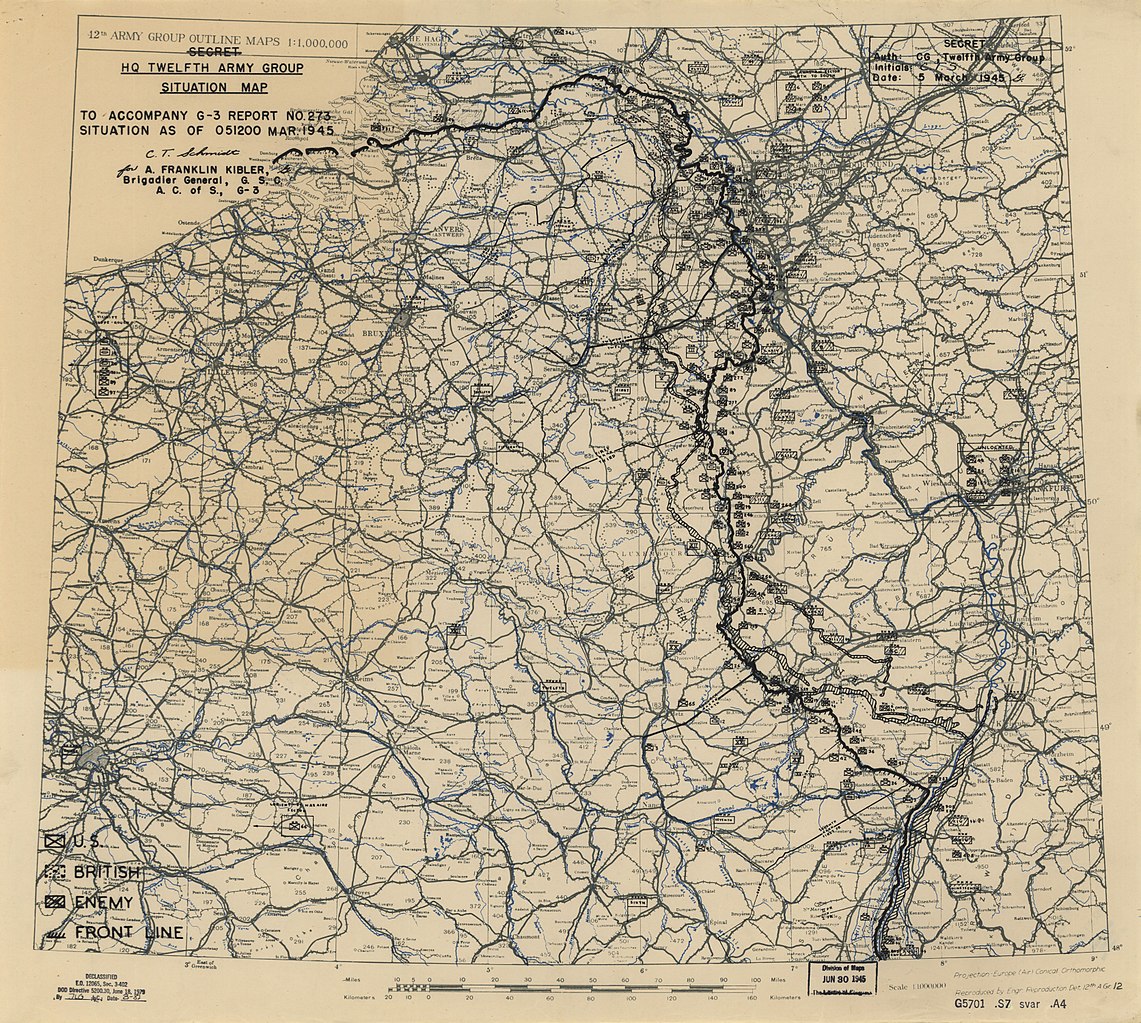 Units of the US 8th Corps (part of US 1st Army) enter Cologne from the south and the east. The Allied advance continues along the entire line. German troops blow the Rhine bridges as the US 1st and 9th Armies close on the river. Photo: Prime Minister Winston Churchill chalks the message "A Present for Hitler" onto a shell which he then fired from a 9.2mm gun at the eastern edge of Goch, Germany, on 5 March 1945 Air War over Europe Air War over Europe (US Eighth Air Force): 3 missions are flown. Mission 865: 429 bombers and 689 fighters are dispatched to hit oil targets in Germany; the primary target for the B-17s is the synthetic oil plant at Ruhland but weather forces them to hit the secondary target; all bombing is with H2X radar; 1 B-17 is lost: 1. 233 of 303 B-17s hit the secondary target, the marshalling yard at Chemnitz; targets of opportunity are Plauen (34) and Fulda (9); 1 B-17 is lost and 15 damaged; 9 airmen are MIA. Escorting are 369 of 420 P-51s; 3 P-51s are damaged beyond repair and 1 pilot is KIA. 2. 120 of 126 B-24s hit the Harburg oil refinery at Hamburg without loss. The escort is 186 P-47s and P-51s without loss. 3. 27 P-51s attack the marshalling yard at Kreuztal; 1 P-51 is damaged beyond repair. 4. 28 P-51s fly a scouting mission. 5. 14 P-51s escort 4 F-5s on a photo reconnaissance mission over Germany. Mission 866: 21 of 24 B-24s bomb the Wiesbaden rail station by PFF markers during the night. Mission 867: 9 of 11 B-24s drop leaflets in the Netherlands, France and Germany during the night. (US Ninth Air Force): In Germany, 565 B-26s, A-20s and A-26s attack 6 marshalling yards, a communications center, an ordnance depot, a city area and targets of opportunity with the aim of obstructing reinforcements and supplies to German forces being pushed back across the Rhine River; fighters escort the bombers, drop leaflets in the Cologne-Bonn area, and fly armed reconnaissance over the Ruhr and Hamm-Duisburg area. 170 RAF Lancasters of No 3 Group carried out a G-H attack on the Consolidation benzol plant at Gelsenkirchen. No results were seen. 1 Lancaster lost. Chemnitz; 760 RAF aircraft - 498 Lancasters, 256 Halifaxes, 6 Mosquitos - to continue Operation Thunderclap. The operation started badly when 9 aircraft of No 6 Group crashed near their bases soon after taking off in icy conditions. No 426 Squadron, at Linton-on-Ouse, lost 3 out of their 14 Halifaxes taking part in the raid in this way, with only 1 man surviving. 1 of the Halifaxes crashed in York, killing some civilians. 22 further aircraft were lost in the main operation - 14 Lancasters and 8 Halifaxes. 248 RAF Lancasters and 10 Mosquitos of No 5 Group attacked the synthetic-oil refinery at Böhlen. The target area was covered by cloud but some damage was caused to the refinery. 4 Lancasters lost. 75 RAF Mosquitos to Berlin, 15 to Gelsenkirchen and 36 in small numbers to 6 other targets, 52 RCM sorties, 27 Mosquito patrols. 5 aircraft lost - 2 Mosquito bombers from the Berlin raid, 1 Mosquito lost from a small raid to Hallendorf, 2 RCM aircraft (1 Halifax and 1 Stirling, of which the latter was believed to have been shot down over France by an American artillery unit). Total effort for the night: 1,223 sorties, 31 aircraft (2.5 per cent) lost and 10 more crashed in England. Italian campaign(US Fifteenth Air Force): Bad weather limits operations to supply, escort, and reconnaissance missions. HQ 306th Fighter Wing moves from Lesina to Fano, Italy; HQ 325th Fighter Group and the 317th and 319th Fighter Squadrons move from Lesina to Rimini, Italy with P-51s. (US Twelfth Air Force): In Italy, A-20s hit lines of communications in the N Po Valley during the night of 4/5 Mar; results are generally good; bad daytime weather grounds the medium bombers; XXII Tactical Air Command fighter-bombers and fighters operate on a greatly reduced scale, mostly in the C Po Valley, hitting bridges at Casarsa della Delizia, Nervesa della Battaglia, Ostiglia, and Ostellato, and attacking the town of Vignola. GermanyFifteen and sixteen-year-old boys from the class of 1929 are called up to serve in the German army. Pacific WarCHINA (Fourteenth Air Force): In French Indochina, 30 B-25s knock out bridges at Phu Xuyen, Thinh Duc, Phu Ly, Ninh Binh, and Phu Lang Thuong and damage a bridge at Kep. In China, 2 B-25s, escorted by 8 P-47s, knock out a bridge at Changtuikuan while 4 bomb Chikhom. 40+ P-51s and P-40s on armed reconnaissance hit road, rail, and river traffic, town areas, and other targets of opportunity in French Indochina, the C Yangtze River area, and elsewhere in S and E China. INDIA-BURMA (Tenth Air Force): In Burma, 50+ P-47s support forces of the British 36 Division in the Mogok sector and forces of the Chinese 50th Division in the Mansam area; 46 P-47s and 12 B-25s hit troop concentrations in the battle areas and attack supply areas, road traffic, and general targets of opportunity behind enemy lines. 664 air supply sorties are flown to forward areas. BURMA Japanese counterattacks against British 4th Corps begin. The small town of Taungtha is retaken by the Japanese and the British 17th Indian Division is nearly cut off in Meiktila. British airborne supply operations continue, however. Photo: Field Marshal Sir William Slim: (1891 - 1970): GOC (General Officer Commanding) 14th Army, holding binoculars outside 14th Army Headquarters in Burma, 5 March 1945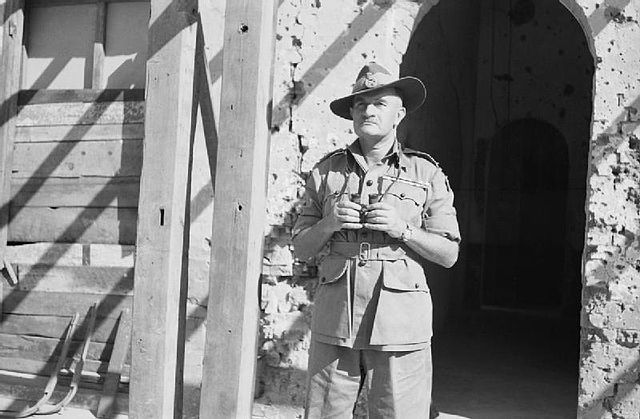 GUAM (Seventh Air Force): Susaki Airfield is pounded by 11 B-24s from Guam; during the night of 5/6 Mar, 5 more hit the airfield in individual snooper strikes. 22 B-24s from Angaur Airfield bomb Matina Airfield on Mindanao. SOUTHWEST PACIFIC AREA [Far East Air Force]: Targets on Formosa are hit by fighters on sweeps and B-24s on armed reconnaissance; the fighter sweeps are especially effective against railroad targets. B-25s hit Zettle Field. HQ 5th BG moves from Morotai to Guiuan Airfield; the 25th Liaison Squadron, FEAF (attached to Thirteenth AF), moves from Biak to Dulag with UC-78s and L-5s. CAROLINE ISLANDS Photo: The U.S. Navy destroyer USS Harrison (DD-573) transferring mail to USS McKee (DD-575) while at sea near Ulithi, Caroline Islands, on 5 March 1945. As Harrison and McKee were assigned to Task Group 58.1 in March 1945, the South Dakota-class battleship in the background is probably either USS Indiana (BB-58) or USS Massachusetts (BB-59). The Cleveland-class light cruiser in the right background would then be USS Vincennes (CL-64), due to her Camouflage Measure 33, Design 3D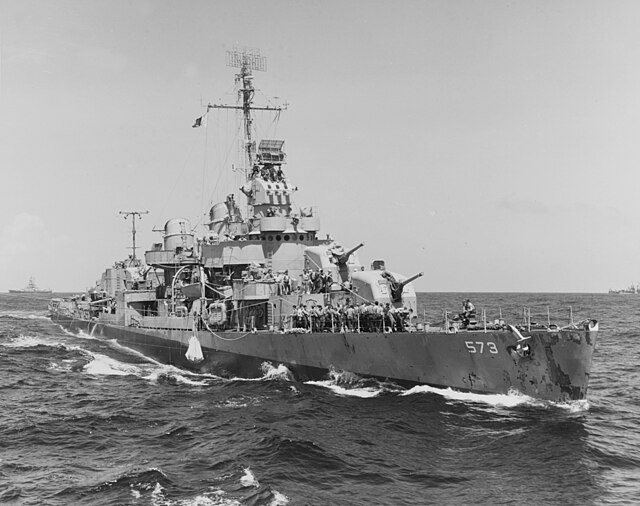 PHILIPPINE CAMPAIGN (1945) B-25s hit San Roque Airfield. On Luzon , B-24s with fighter support hit troops in the Antipolo area while fighter-bombers dive-bomb San Pablo, hit Fort Drum in Manila Bay, attack troops W of Ft Stotsenburg, and support guerrilla forces NE of Lingayen Gulf. VOLCANO AND RYUKYU ISLANDS CAMPAIGN Photo: Marines stand on a ridge and pick off the Japs as they come out of a cave. Iwo Jima, 5 March, 1945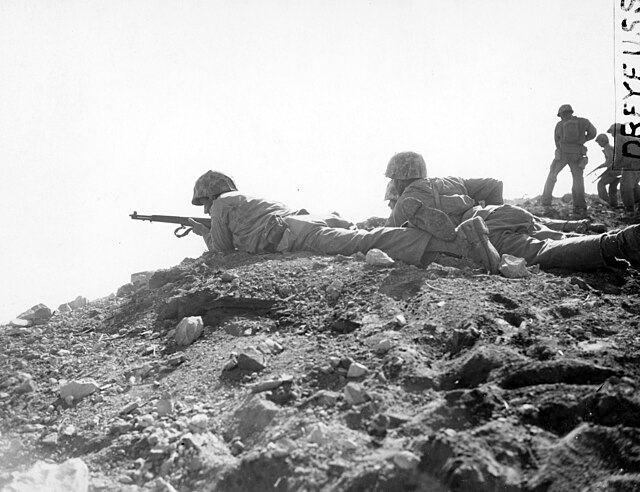 UNITED STATES NAVY DEPARTMENT COMMUNIQUES, CINCPOA COMMUNIQUÉ NO. 289, MARCH 5, 1945 During the night of March 4‑5 (East Longitude Dates), the enemy made a number of attempts to infiltrate into our lines on Iwo Island and subjected the Marines to substantial small arms and artillery fire. All enemy efforts to move into our positions were broken up. No appreciable change was made in the lines of the opposing forces on March 5. Improved wind and weather conditions facilitated unloading of supplies on both Eastern and Western beaches. Seventh Army Air Force Liberators operating under the Strategic Air Force, Pacific Ocean Areas, bombed the airfield on Chichi Jima in the Bonins on March 4. Corsair and Hellcat fighters and Avenger torpedo planes of the Fourth Marine Aircraft Wing set an ammunition dump and a supply area afire and damaged a pier by bombing and rocket attacks in the Palaus on March 4. Two of our aircraft were lost. Navy search planes of Fleet Air Wing Two strafed targets on Ponape in the Eastern Carolines on the same date. PACIFIC Tank landing ship LST-642 is damaged in collision off Iwo Jima, 24°46'N, 141°19'E. Submarine Bashaw (SS-241) attacks same Japanese convoy (HI-98) vexed by Baya (SS-318) the day before, sinking oiler Ryoei Maru and army tanker Seishin Maru off Tourane, French Indochina, 16°47'N, 108°41'E. Submarine Peto (SS-265) is damaged by aerial bombs in South China Sea off Hainan, 20°57'N, 111°56'E, but remains on patrol. Submarine Sea Robin (SS-407), attacking Japanese convoy in the Java Sea, sinks gunboat Man-yo Maru, 05°50'S, 113°46'E, auxiliary netlayer Nagara Maru, 05°23'S, 114°00'E, and merchant cargo ship Shoyu Maru, 05°23'S, 114°60'E. Submarine Tilefish (SS-307) damages Japanese minesweeper W.15 off Akuke Jima, Japan, 29°36'N, 129°45'E. Although run aground by No.51 Banshu Maru to facilitate her salvage, W.15 is later regarded as a total loss. TF 58 planes sink Japanese auxiliary submarine chaser Cha 224 off Mako, Pescadores. USAAF B-25s (5th Air Force) attack Japanese convoy SAYU-02, sinking auxiliary submarine chasers Kasuga Maru and Ujina Maru and merchant cargo ship Shoto Maru off coast of French Indochina, 15°32'N, 108°37'E. USAAF B-24 (13th Air Force) sinks Japanese auxiliary submarine chaser Cha 110 in Sape Strait, southeast of the Celebes, 08°36'S, 119°19'E. Support landing craft LCS-127 sinks after grounding off San Clemente Island California. Photo: The U.S. Navy destroyer USS Ringgold (DD-500) after losing her bow in a collision with USS Yarnall (DD-541) on 5 March 1945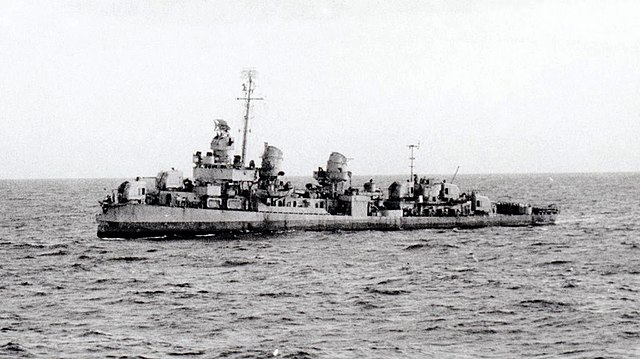 Photo: The U.S. Navy destroyer USS Harrison (DD-573) transferring mail to USS McKee (DD-575) while at sea near Ulithi, Caroline Islands, on 5 March 1945. As Harrison and McKee were assigned to Task Group 58.1 in March 1945, the South Dakota-class battleship in the background is probably either USS Indiana (BB-58) or USS Massachusetts (BB-59). The Cleveland-class light cruiser in the right background would then be USS Vincennes (CL-64), due to her Camouflage Measure 33, Design 3D Photo: The U.S. Navy destroyer USS Harrison (DD-573) transferring mail to USS McKee (DD-575) while at sea near Ulithi, Caroline Islands, on 5 March 1945. As Harrison and McKee were assigned to Task Group 58.1 in March 1945, the South Dakota-class battleship in the background is probably either USS Indiana (BB-58) or USS Massachusetts (BB-59). The Cleveland-class light cruiser in the right background would then be USS Vincennes (CL-64), due to her Camouflage Measure 33, Design 3D
|
|
lordroel
Administrator
Member is Online
Posts: 68,022 
Likes: 49,423
|
Post by lordroel on Mar 6, 2024 3:52:04 GMT
Day 2003 of World War II, March 6th 1945Eastern FrontThe German forces in Hungary launch a major counteroffensive in the area just north of Lake Balaton. The 6th SS Panzer Army, which was withdrawn from the Ardennes battle early in January, has been moved here to spearhead the attack. Other units from Army Group South (Wohler) also take part in the offensive. The operation is code named Fruhlingserwachen or Spring Awakening. The German aim is to retake all the territory between Lake Balaton and the Danube. The Soviet 27th Army, defending along the targeted line of advance, is forced to give ground initially. However, 3rd Ukrainian Front (Tolbukhin) responds with the allotment of reserves to slow the advance down. Meanwhile, in the fighting in Poland, forces of 2nd Belorussian Front complete the capture of the fortress town of Grudiaz after a lengthy siege. About 1200 Soviet aircraft bomb Breslau throughout the day. Soviet troops advance towards Danzig. An Hs 293 guided bomb is launched against the Oder bridge at Göritz. Western Front (1945) - Western Allied invasion of GermanyMap: HQ Twelfth Army Group situation map, March 6th 1945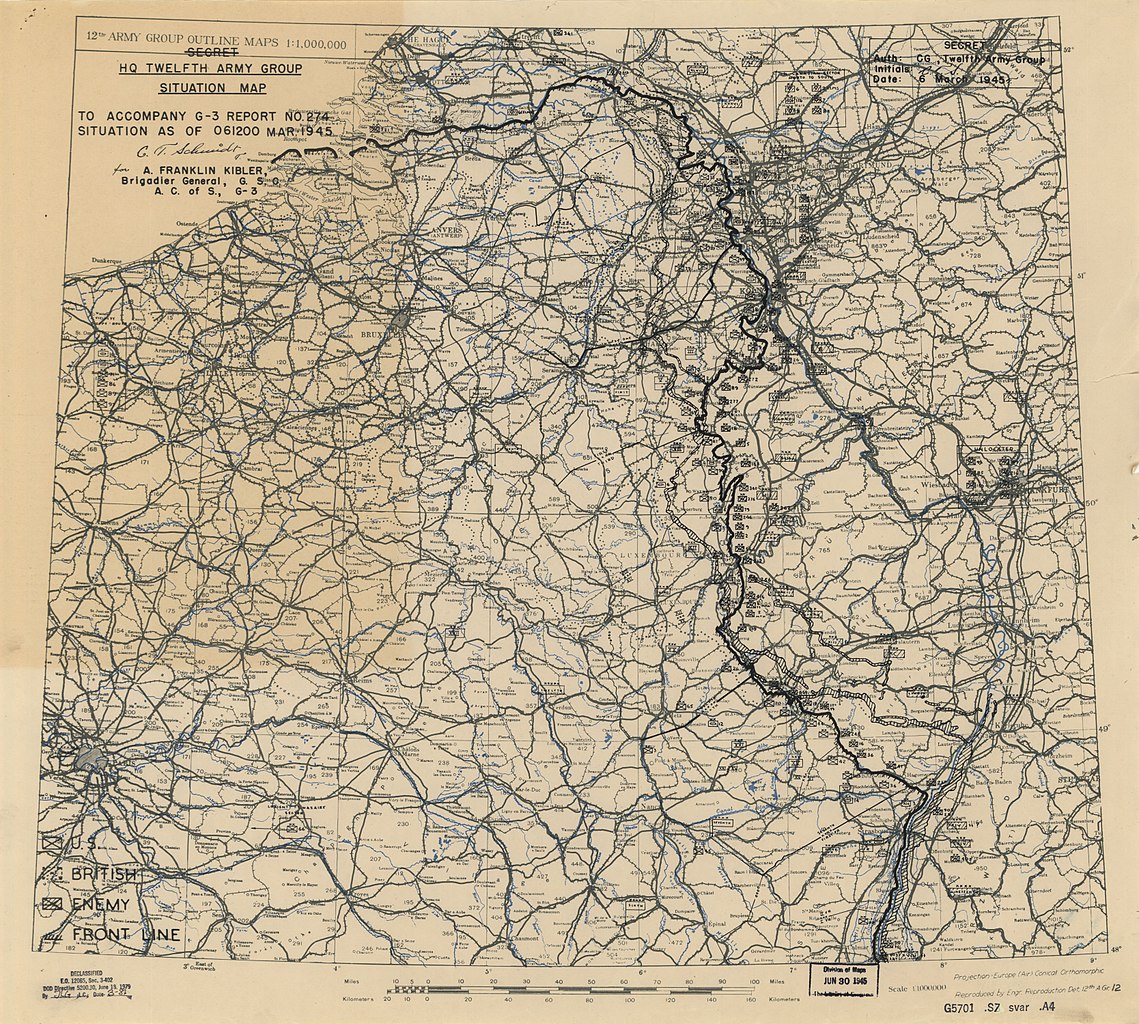 Units of the Canadian 1st Army are preparing to clear the final German pocket west of the Rhine around Xanten. The US 9th Army has reached the Rhine all along its front. To the south, US 1st Army is fighting in Cologne and driving toward Remagen farther south -- the US 9th Armored Division leads the advance. Farther south, units of US 3rd Army are making a rapid advance toward the Rhine at Koblenz. Photo: Infantrymen of the 2nd Division, 1st U.S. Army, move through the streets of Scheven, Germany, Germany, as they advance towards Eiserfey, Germany. 6 March, 1945 Photo: American soldiers look on as German civilians move their belongings in the town of Sulm, Germany. 6 March, 1945 Photo: American soldiers look on as German civilians move their belongings in the town of Sulm, Germany. 6 March, 1945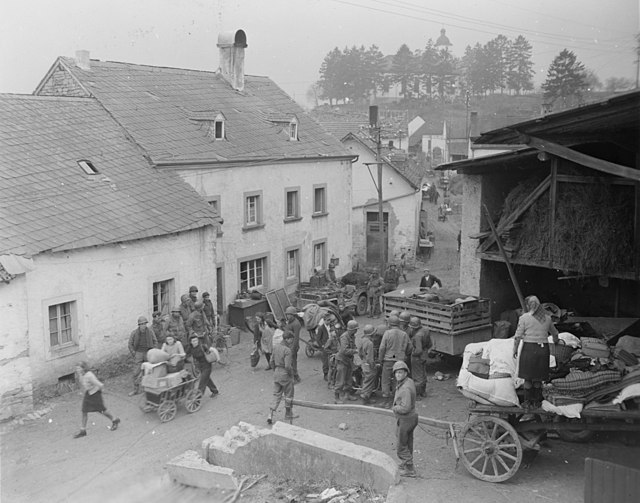 Photo: Tanks of the 9th Armored Division, U.S. First Army, advance to the front through the town of Kleinbullesheim, Germany. 6 March, 1945 Photo: Tanks of the 9th Armored Division, U.S. First Army, advance to the front through the town of Kleinbullesheim, Germany. 6 March, 1945 Photo: Still another small German town falls to the infantrymen of the 9th Armored Division, U.S. First Army, as they drive through Kleinbullesheim, Germany, in the march to the Rhine River, 6 March 1945 Photo: Still another small German town falls to the infantrymen of the 9th Armored Division, U.S. First Army, as they drive through Kleinbullesheim, Germany, in the march to the Rhine River, 6 March 1945 Air War over Europe Air War over Europe (US Eighth Air Force): Mission 868: 12 B-24s drop leaflets in the Netherlands and Germany during the night. 5 B-24s fly Carpetbagger missions. (US Ninth Air Force): In Germany, 260+ A-26s, and B-26s hit Recklinghausen, Siegburg, and Opladen marshalling yards, Siegburg storage depot, and the town of Bochum as a target of opportunity; weather grounds the IX and XIX Tactical Air Commands; the XXIX Tactical Air Command (Provisional) flies alerts and covers the US XVI Corps as it completes a drive to the Rhine River in the Rheinburg area. 119 RAF Lancasters of No 3 Group carried out a G-H attack through cloud on the Wintershall oil refinery at Salzbergen. 1 lost. 48 RAF Mosquitos of No 8 Group attacked Wesel, which was believed to contain many German troops and vehicles. The target had been cloud-covered for several days. Oboe Mosquitos provided the marking. 1 aircraft lost. 191 RAF Lancasters and 7 Mosquitos of No 5 Group attacked the port of Sassnitz on the island of Rügen, in the Baltic. Considerable damage was caused to the northern part of the town and 3 ships were sunk in the harbour. 1 Lancaster lost. 87 RAF Lancasters of No 3 Group and 51 Mosquitos of No 8 Group continued the attack on Wesel with two separate raids. No aircraft lost. 42 RAF Mosquitos to Berlin, 2 RCM sorties, 5 Mosquito patrols, 15 Lancasters minelaying off Sassnitz. Italian campaign(US Fifteenth Air Force): Bad weather restricts all operations except reconnaissance and a supply mission, with escort, to Yugoslavia. The 302d Fighter Squadron, 332d Fighter Group, is inactivated at Ramitelli Airfield, Italy. (US Twelfth Air Force): In Italy, medium bombers pound communications in the Brenner Pass and hit bridges at Pordenone, Ossenigo, Enego, Ora, Pizzighetone, and San Ambrogio di Valpolicella; fighters and fighter-bombers concentrate on close support of the US Fifth Army S and SW of Bologna; during the night of 5/6 Mar, a few A-20s bomb targets of opportunity in the Po Valley. RomaniaKing Michael appoints a new government dominated by the Romanian Communist Party. In the west, this move is viewed as a sign the Stalin and the Soviet Union will not hold to the assurances given at Yalta about doing nothing to hinder the process of democracy in eastern Europe. United StatesPhoto: The U.S. Navy attack cargo ship USS Polana (AKA-35) underway in the Atlantic Ocean on 6 March 1945. She is painted in Camouflage Measure 32, Design 4T Pacific War Pacific WarCHINA (Fourteenth Air Force): In China, 4 B-25s bomb Chikhom; about 50 fighter-bombers hit storage, troops, railroad targets, and river and road traffic around Hankow, along the Pinghan railroad, Kaifeng, Suchow, Hsuchang, Changsha, Yoyang, Liuyang, and Hengyang, and on railroads from Liuliho to Chengtung and from Tungpu to Tatung. INDIA-BURMA (Tenth Air Force): In Burma, 31 P-47s support British 36 Division forces in the Mogok area; 12 B-25s join 60+ fighter-bombers in striking troop concentrations, road traffic, supply and fuel dumps, and other targets in the vicinity of the battlefront and in areas close behind enemy lines. Transport operations continue on a large scale with 663 sorties completed to forward areas throughout the day. BURMA In their advance down the Burma Road, units of the Chinese 1st Army reach and capture Lashio. GUAM (Seventh Air Force): 11 Guam based B-24s again pound Susaki Airfield; 5 more hit the airfield during the night of 6/7 Mar in separate strikes. HQ 15th Fighter Group arrives on Iwo Jima from Hawaii and the air echelon of the 548th Night Fighter Squadron moves from Saipan to Iwo Jima with P-61s (there are now 28 P-51s and 12 P-61s on the Iwo Jima). SOUTHWEST PACIFIC AREA [Far East Air Force]: On Mindanao, B-24s pound San Roque and Zamboanga areas. On Luzon , other B-24s, B-25s, and fighter-bombers hit the Antipolo area, bomb Balete Pass and Ft Drum and Caballo in Manila Bay and support guerrillas near San Fernando. B-25s and P-38s attack Hainan and considerably damage Samah Airfield. Fighters sweeping over Formosa hit the Koshun area. HQ 347th FG and the 67th, 68th and 339th Fighter Squadrons move from San Jose, Mindoro to Puerto Princesa, Palawan with P-38s (the 67th and 339th are operating from Morotai ); the 419th Night Fighter Squadron, XIII Fighter Command, moves from Middelburg , New Guinea to Puerto Princesa, Palawan (the squadron is operating from Morotai with P-38s and P-61s). VOLCANO AND RYUKYU ISLANDS CAMPAIGN Photo: A U.S. Navy Curtiss SC-1 Seahawk floatplanes taxiing up to the landing mat streamed alongside the battlecruiser USS Alaska (CB-1), to be picked up by the aircraft crane. Photographed on 6 March 1945 during the Iwo Jima operation ALASKA (Eleventh Air Force): A mission to the Kurile s is cancelled due to inclement weather. UNITED STATES NAVY DEPARTMENT COMMUNIQUES, CINCPOA COMMUNIQUÉ NO. 290, MARCH 6, 1945 After the most intense artillery bombardment of enemy positions since the operation on Iwo Island began, elements of the Third, Fourth, and Fifth Marine Divisions resumed the attack on the morning of March 6 (East Longitude Date). Fighting was heavy. throughout the day with the enemy offering very stiff resistance and subjecting our forces to a heavy volume of small arms and mortar fire. By 1730 on March 6, the Marines had made small local gains on the left flank and in the center of the lines. Carrier aircraft supported the attack and Naval guns were in action throughout the day. The Marines had counted 14,456 enemy dead at 1800 on March 5. Army fighters are using the southern Iwo airfield and air evacuation of wounded by transport plane continues. Unloading conditions continue to be favorable. Army Liberators of the Strategic Air Force, Pacific Ocean Areas, bombed the airfield on Chichi Jima in the Bonins on March 5. On the same date fighters of the Fourth Marine Aircraft Wing bombed and set afire an oil dump, a supply dump and a house in the Palaus. Marine Corsair and Avenger torpedo planes attacked targets in the Palaus and on Yap in the Western Carolines on March 6. Marine fighters strafed targets on Rota in the Marianas on March 6. PACIFIC Attack cargo ship Yancey (AKA-93) is damaged by collision off Iwo Jima. USAAF B-24 (possibly a Navy PB4Y) sinks Japanese salvage vessel Toei Maru east of Sanmen Wan, 29°00'N, 122°00'E. USAAF planes attack Japanese convoy at 20°00'N, 112°30'E, and although the airmen believe that they sink a "destroyer," their quarry, actually Coast Defense Vessel No. 207, survives undamaged. Japanese army vessel tanker Rikko Maru is stranded and sunk near Keelung, Formosa, 25°09'N, 121°44'E. Japanese merchant cargo ship Hokusui Maru is sunk (most likely by drifting Japanese mine) off Otabe, Hokkaido, 41°27'N, 140°15'E. Japanese merchant cargo ship No.22 Suma Maru is damaged by aircraft, four miles northwest of Fukikaku Light.
|
|
lordroel
Administrator
Member is Online
Posts: 68,022 
Likes: 49,423
|
Post by lordroel on Mar 7, 2024 3:48:25 GMT
Day 2004 of World War II, March 7th 1945Eastern FrontIn Hungary, the German offensive by Army Group South continues and achieves more gains. To the north of Lake Balaton, attacks are by 6th SS Panzer Army while to the south of the lake, there are attacks by units of the German 2nd Panzer Army toward Kaposvar. Farther south, in occupied Yugoslavia, elements of German Army Group E (Lohr) attack northeast of the Drava River against allied forces of 3rd Ukrainian Front. Meanwhile, on the Baltic, German evacuations begin from around the city of Danzig which continue until mid-April. Western Front (1945) - Western Allied invasion of GermanyMap: HQ Twelfth Army Group situation map, March 7th 1945 US 1st Army seizes the intact Ludendorff railroad bridge at Remagen, near Bonn, and establishes a bridgehead on the east bank of the Rhine. The leading tanks of US 3rd Corps (part of US 1st Army) reach the Rhine River opposite Remagen and find the Ludendorff Bridge there damaged but still standing. Troops are immediately rushed across and a bridgehead is firmly established during the day. Eisenhower's reaction to the bridge's capture: 'That bridge is worth its weight in gold.' Other elements of the US 1st Army complete the capture of Cologne. Units US 12th Corps from US 3rd Army continue to advance rapidly. The US 3rd Army breaks through the Schnee Eifel Mountains. Photo: Infantrymen of 4th Armored Division, 3rd U.S. Army, pass burning German halftrack as they advance along forest road near the Rhine River, Germany. 7 March, 1945 Photo: Infantrymen of the 2nd Division, 1st U.S. Army, move out of Breitenbenden, Germany, down a muddy road leading to their next objective, the German town of Holzheim. 7 March, 1945 Photo: Infantrymen of the 2nd Division, 1st U.S. Army, move out of Breitenbenden, Germany, down a muddy road leading to their next objective, the German town of Holzheim. 7 March, 1945 Air War over Europe Air War over Europe(US Ninth Air Force): Weather cancels combat operations except for the XXIX Tactical Air Commands support of the US XVI Corps along the Rhine River in the Wesel area. The 39th Photographic Reconnaissance Squadron, 10th Photographic Group (Reconnaissance), moves from St Amand to Jarny, France with F-5s (flights are operating from Gosselies and Le Culot, Belgium). (US Eighth Air Force): 3 missions are flown. Mission 869: 946 bombers and 322 fighters are dispatched to hit oil and communication targets using PFF; 1 P-51 is lost: 1. 246 B-24s are sent to hit the marshalling yard at Soest (144) and the Schildesche water viaduct at Bielefeld (80); Gee-H and H2X radar are used for bombing; 1 B-24 is damaged beyond repair and 3 damaged; 10 airmen are KIA. Escorting are 77 P-47s and P-51s. 2. 344 B-17s are dispatched to bomb the Horderverein (24) and Harpenerweg (62) oil refineries at Dortmund; secondary targets hit are the marshalling yards at Paderborn (11), Siegen (113) and Giessen (87); Gee-H and H2X radar are used; 1 B-17 is damaged beyond repair and 20 damaged; 1 airman is KIA. The escort is 74 of 85 P-51s. 3. 340 B-17s are sent to hit the Emscherlippe benzol plant at Datteln (173) and the Rauxel benzol plant at Castrop (77); secondary targets hit are the marshalling yards at Siegen (43) and Giessen (28); 1 other hits a target of opportunity; Micro H and H2X radar are used; 56 B-17s are damaged. 75 of 76 P-51s escort the bombers. 4. 6 B-17s and 6 B-24s fly a screening mission. 5. 4 B-17s fly a scouting mission. 6. 37 of 38 P-51s fly a sweep of the Dummer Lake-Kassel-Koblenz area. 7. 23 P-51s escort 5 F-5s and a Spitfire on a photo reconnaissance mission over Germany; 1 P-51 is lost (pilot MIA). 8. 24 P-51s fly a scouting mission. Mission 870: 11 of 12 B-24s drop leaflets in Germany and the Netherlands. Mission 871: 19 of 20 B-24s bomb Dortmund during the night using PFF; 1 B-24 is lost. 526 RAF Lancasters and 5 Mosquitos of Nos 1, 3, 6 and 8 Groups raided Dessau. 18 Lancasters lost, 3.4 per cent of the force. This was another devastating raid on a new target in Eastern Germany with the usual town centre, residential, industrial and railway areas all being hit. The night bombing raid on Dressau destroyed the first two special 'Mosquito destroyers', Ju 88 G-7 high performance night-fighters, before they have a chance to become operational. 256 RAF Halifaxes and 25 Lancasters of Nos 4, 6 and 8 Groups attempted to attack the Deutsche Erdoel refinery at Hemmingstedt, near Heide, with little success. 4 Halifaxes and 1 Lancaster lost. 234 RAF Lancasters and 7 Mosquitos of No 5 Group carried out an accurate attack on the oil refinery at Harburg. 14 Lancasters lost. No 189 Squadron, from Fulbeck, lost 4 of its 16 Lancasters on the raid. One local report states that a rubber factory was seriously damaged as well as the oil targets. 80 RAF Mosquitos to Berlin, 10 to Frankfurt, 9 to Münster and 5 to Hannover, 56 RCM sorties, 43 Mosquito patrols, 15 Halifaxes and 5 Lancasters minelaying off Eckemforde and Flensburg. 4 aircraft were lost - 2 Halifaxes and 1 Fortress of No 100 Group and 1 Mosquito from the Berlin raid. Italian campaign (US Fifteenth Air Force): Continued bad weather limits operations to a supply drop in Yugoslavia and routine reconnaissance and escort missions; all bombing operations are cancelled and 42 P-51s sent on a strafing mission against railroad communications in Austria are recalled. The 318th Fighter Squadron, 325th Fighter Group, moves from Lesina to Rimini, Italy with P-51s. (US Twelfth Air Force): In Italy, B-25s continue interdiction of enemy communications, damaging a railroad bridge at Longarone and railroad fills at Peri and Ossenigo; the XXII Tactical Air Command concentrates on communications in the NE, Po Valley and fuel and ammunition dumps in the C part of the Valley with generally good results; during the night of 6/7 Mar, A-20s hit the Ostiglia crossing and bridges at Nervesa della Battaglia and Casarsa della Delizia, and bomb targets of opportunity in the Brenner area. Battle of the MediterraneanMotor torpedo boats PT-305 and PT-307 are accidentally bombed (but not damaged) by friendly aircraft while patrolling southwest of Genoa, Italy. TG 89.9, comprising aviation supply ship Tackle (IX-217) and fleet tug Moreno (ATF-87), departs Naples for Odessa, USSR, with supplies for American POWs liberated from German camps by Soviet troops. YugoslaviaIn Liberated Yugoslavia... The two existing governments, that led by Tito and the royalist government, are merged into a new single government dominated by Tito and his followers. GermanyHitler relieves Field Marshal Rundstedt from his post as Commander in Chief of the German armies in the west because of the American capture of the bridge at Remagen. Field Marshal Kesselring is appointed to replace him. United StatesPhoto: The U.S. Navy destroyer escort USS Strickland (DE-333) underway off New York City (USA) on 7 March 1945. The pipe structure preventing the 40mm from firing inboard can be easily seen. She is painted in Camouflage Measure 32, Design 3D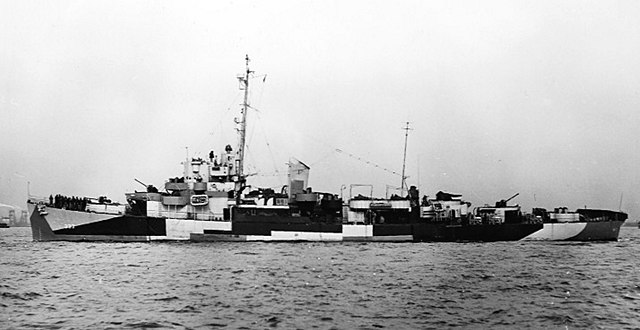 Pacific War Pacific WarCHINA (Fourteenth Air Force): In China, 4 B-25s and 9 P-40s blast railroad targets N of Kiaotow; single B-25s hit truck convoys in the Hsiang River Valley, the waterfront at Changsha, and a bridge and other targets of opportunity on the Pinghan railroad; 130+ fighter-bombers attack numerous targets throughout S and E China, concentrating on railroad, road, and river targets in the areas around Nanking, Yoyang, Sintsiang, and Changsha. INDIA-BURMA (Tenth Air Force): In Burma, 30 P-47s support troops of the British 36 Division in the Mogok area; 18 others support elements of the Chinese 50th Division near Mansam; elements of the Chinese 38th Division occupy Lashio; 12 B-25s and 35 fighter-bombers attack road targets, troops,vehicles, and a variety of targets of opportunity immediately behind enemy lines. Transports fly 630 sorties supplying forward areas with men and equipment. BURMA Photo: Loading ammunition aboard a Priest 105mm self-propelled gun, 7 March 1945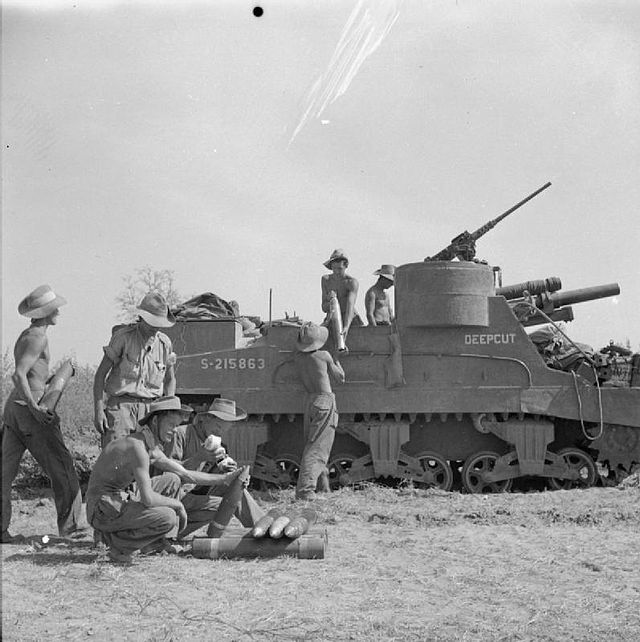 Photo: The .50-inch machine gun of a Priest 105mm self-propelled gun, 7 March 1945 Photo: The .50-inch machine gun of a Priest 105mm self-propelled gun, 7 March 1945 Photo: A Priest 105mm self-propelled gun on the move, 7 March 1945 Photo: A Priest 105mm self-propelled gun on the move, 7 March 1945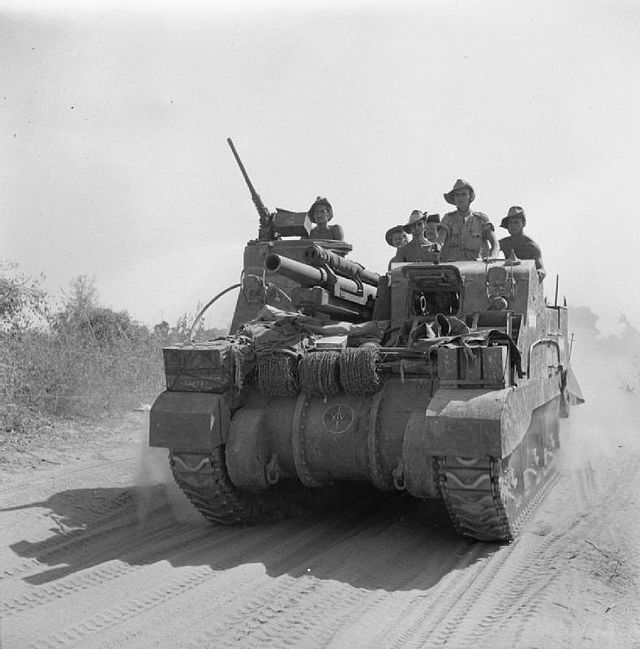 Photo: Priest 105mm self-propelled gun in action, 7 March 1945 Photo: Priest 105mm self-propelled gun in action, 7 March 1945 GUAM (Seventh Air Force): 11 Guam based B-24s hit Susaki Airfield and the town of Okimura on Haha Jima; 5 more hit Susaki Airfield during the night of 7/8 Mar in individual harassment strikes. PHILIPPINE CAMPAIGN (1945) Forces of the US 1st Corps are engaged south of San Fernando. South of Manila, the US 14th Corps is fighting near Balayan Bay and Batangas against the defense lines of the south Luzon Shimbu Group of the Japanese forces. On Luzon , B-24s hit the Balete Pass area while A-20s and fighter-bombers hit troop concentrations and gun positions near Antipolo and near San Fernando, NW of Ft Stotsenburg, and in the Bayombong-Solano area and targets of opportunity in the Lake Taal area, the towns of Santa Fe, Lallo and Vigan, and on Caballo in Manila Bay; numerous ground support missions are flown throughout Luzon. Navy task unit completes its work in the Baler Bay-Casiguran Sound area, having found both bodies of water to afford excellent anchorages; it encounters no mines in Casiguran Sound but sweeps 98 in Baler Bay. Not more than 100 Japanese troops are determined to be in the vicinity. ALASKA (Eleventh Air Force): In the Kurile s; 8 B-25s, dispatched to strike a reported convoy, abort due to weather; so do 8 B-24s after departing on a shipping sweep and a strike on Kataoka, Shimushu. UNITED STATES NAVY DEPARTMENT COMMUNIQUES, CINCPOA COMMUNIQUÉ NO. 291, MARCH 7, 1945 Attacking in all sectors of the line the Marines on Iwo Island advanced against heavy enemy resistance on March 7 (East Longitude Date). In the Fifth Marine Division sector on the west flank our forces moved forward about 500 yards on the left with lesser gains in the center and right. The Third Division in the center advanced about 588 yards at one point after engaging the enemy in hand to hand fighting. Advances of 100 to 200 yards were reported in local areas of the Fourth Division sector on the east. The enemy continued to resist with intense small arms and machine gun fire throughout the day. Carrier aircraft made bombing and rocket attacks on targets on Chichi Jima and Haha Jima in the Bonins on March 6 and 7. Favorable weather conditions continue and unloading of supplies is progressing satisfactorily. A Navy Search Liberator of Fleet Air Wing One bombed and strafed two enemy cargo ships north of the Bonins on March 6. Corsair and Hellcat fighters and Avenger torpedo planes of the Fourth Marine Aircraft Wing destroyed a bridge and set buildings afire with bomb and rocket attacks on the Palaus on March 6. On the same date Marine aircraft bombed installations on Yap in the Western Carolines. Strafing and bombing attacks were made on Ponape in the Eastern Carolines on March 6 by planes of the Fourth Marine Aircraft Wing. Moderate antiaircraft fire was encountered. PACIFIC Japanese submarine chaser Ch 51 is damaged by aircraft off Hachijo Jima. Japanese merchant cargo ship Enkei Maru is damaged, most likely by marine casualty, 30°42'N, 128°20'E.
|
|
lordroel
Administrator
Member is Online
Posts: 68,022 
Likes: 49,423
|
Post by lordroel on Mar 8, 2024 9:27:38 GMT
Day 2005 of World War II, March 8th 1945Eastern Front Soviet troops capture Laubau (Silesia). The Red Army penetrates into the southern suburbs of Breslau. Five Mistels escorted by Ju 188 bombers attack the Oder Bridge at Göritz. As the Ju 188s scatter the Allied air defenses, the Mistels launch and two of the flying bomb contraptions hit the bridge. Western Front (1945) - Western Allied invasion of GermanyMap: HQ Twelfth Army Group situation map, March 8th 1945 American efforts to reinforce the Remagen bridgehead continue. German bombers, including some jets, begin attacks on the bridge but fail to destroy it. To the north, units of the Canadian 2nd Corps (part of Canadian 1st Army) capture Xanten. Western Front (1945) - Granville raidSubmarine chaser PC-564 engages German minesweepers M 412, M 432, M 442 and M 452 and nine smaller craft off Chaussey. The Germans are bound for the port of Granville, France. Air War over Europe (US Eighth Air Force): 3 missions are flown. Mission 872: 1,353 bombers and 326 fighters are dispatched to hit benzol plants, an oil plant and rail targets in Germany using PFF; NO AIRCRAFT ARE LOST AND THERE ARE NO CASUALTIES! 1. 360 B-24s are sent to hit marshalling yards at Betzdorf (70), Siegen (114) and Dillenburg (73); targets of opportunity are Limburg (10) and Frankfurt (10); bombing is by H2X radar; 3 B-24s are damaged. Escorting are 99 of 102 P-51s. 2. 526 B-17s are dispatched to hit the Robert Muser (99) and Bruchstrasse (63) benzol plants at Langendreer, the Gneisenau benzol plant at Dortmund (110) and Heddernheim chemical factory at Frankfurt (122); secondary targets are the marshalling yards at Giessen (69) and Frankfurt (18); 13 others hit Wetzlar, a target of opportunity; bombing is with H2X radar; 26 B-17s are damaged. The escort is 95 of 99 P-51s. 3. 458 B-17s are sent to hit the Emil benzol plant at Essen (114), the Mathies Stinnes benzol plant at Bottrop (37), the August Viktoria benzol plant at Huls (111) and the synthetic oil plant at Buer Scholren (75); 109 hit the marshalling yard at Essen, a target of opportunity; bombing is by Micro-H; 1 B-17 is damaged beyond repair. 93 of 98 P-51s escort. 4. 9 B-17s fly a screening mission. 5. 27 P-51s fly a scouting mission. Mission 873: 11 B-24s drop leaflets in France, the Netherlands and Germany during the night without loss. Mission 874: 15 B-24s attack the marshalling yard at Dortmund during the night without loss and 4 of 7 B-24s fly CARPETBAGGER missions. 312 RAF aircraft - 241 Halifaxes, 62 Lancasters, 9 Mosquitos - of Nos 4, 6 and 8 Groups attacked Hamburg. 1 Halifax lost. The purpose of this raid was to hit the shipyards which were now assembling the new Type XXI U-boats, whose parts were prefabricated in many parts of inland Germany. Thanks to the Schnorkel breathing tube and a new type of battery-driven electric engine, the Type XXI could cruise under water for long periods and was capable of bursts of high speed. Its development in numbers would have posed great problems for Allied convoy defence if the war had lasted longer. The Hamburg area was found to be cloud-covered and the bombing was not expected to be accurate enough to cause much damage to the shipyards. 262 RAF Lancasters and 14 Mosquitos of Nos 1 and 8 Groups carried out the first large raid on Kassel since October 1943; it was also the last large RAF raid on this target. 1 Mosquito lost. This target was also covered by cloud. 39 RAF Mosquitos to Berlin, 33 to Hannover, 7 to Hagen and 5 each to Bremen and Osnabrück, 50 RCM sorties, 36 Mosquito patrols, 23 Halifaxes and 14 Lancasters minelaying in the Rivers Elbe and Weser, 5 aircraft on Resistance operations. 1 RCM Halifax lost. The 5 Stirlings of No 161 Squadron, which were carrying supplies to Resistance units at unrecorded destinations, but probably in Denmark and Norway, were the last Resistance operations flights of the war. Italian campaign (US Fifteenth Air Force): 550+ B-17s and B-24s hit marshalling yards at Hegyeshalom and Komarom, Hungary, and Verona, Italy, the locomotive depot at Maribor, Yugoslavia, and the steel works at Kapfenberg, Austria; P-51s and P-38s fly escort and reconnaissance missions. (US Twelfth Air Force): In Italy, medium bombers are hampered by heavy clouds but hit the Novara marshalling yard, Longarone and Mori rail fills, and Rovereto bridge; fighters and fighter-bombers pound communications and supplies, destroy a road bridge SW of Bologna, severely damage an ammunition plant and surrounding complex NW of Milan, and hit several other targets, including a bridge near Montebello which Brazilian P-47s operating with the XXII Tactical Air Command cut in half; A-20s, operating during the night of 7/8 Mar, attack river crossings at Borgoforte, Cremona, Ostiglia, San Benetto Po, Viadana, and Ora, and numerous vehicles, lights, and general movement in the C Po Valley and along the Brenner line. SwitzerlandBeginning of secret negotiations at Bern, Switzerland, between representatives of the American OSS (Allan Dulles) and the German High Command in Italy (General von Vietinghoff and SS General Wolff) for an early surrender of German forces in Italy. United Kingdom A German V-2 rocket hits Smithfield Market on Farringdon Road in the borough of Finsbury, near London, England, killing 110, seriously injuring 123, with 243 suffering lesser injuries. Photo: Beaufighter TF Mark Xs (NV427 'EO-L' nearest) of No. 404 Squadron RCAF based at Dallachy, Morayshire, in flight along the Scottish coast. NV427 was shot down by anti-aircraft fire during an attack by the Dallachy Wing on an enemy convoy off Midgulen, Norway, on 8 March 1945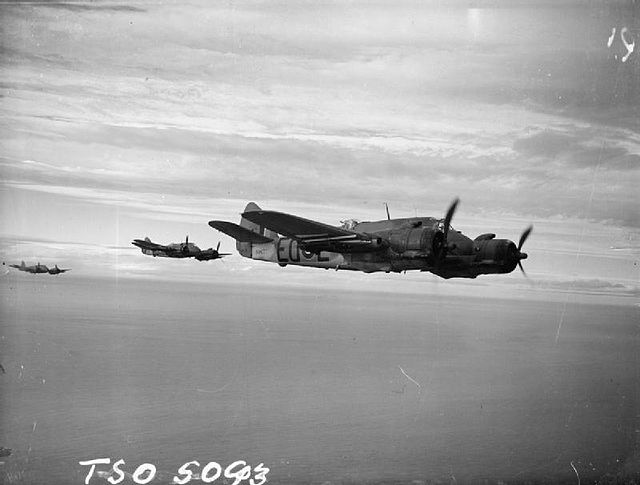 United StatesPhoto: The U.S. Navy heavy cruiser USS New Orleans (CA-32) off the Mare Island Naval Shipyard, California (USA), on 8 March 1945, following her last wartime overhaul. The port catapult has been removed United StatesPhoto: The U.S. Navy heavy cruiser USS New Orleans (CA-32) off the Mare Island Naval Shipyard, California (USA), on 8 March 1945, following her last wartime overhaul. The port catapult has been removed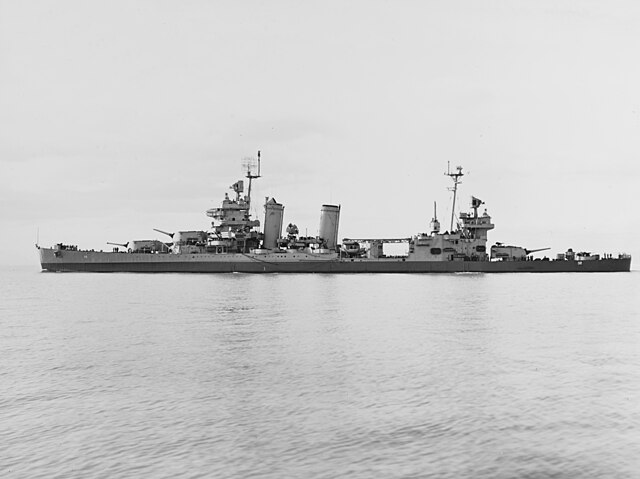 Pacific War Pacific War CHINA (Fourteenth Air Force): In China, 34 B-24s, supported by 21 P-51s, pound Shihkiachwang; 3 B-24s claim a transport sunk in the S China Sea; 16 B-25s and 6 P-40s attack railroad tracks, boxcars, gun positions, sampans, and locomotives, knock out 2 bridges and damage another, and destroy and damage several locomotives at or near Hengshan, Yehhsien, Lohochai, and Chungmow; 140+ fighter-bombers fly armed reconnaissance over wide areas of S and E China, attacking numerous targets of opportunity, mainly river, road, and railroad targets, storage areas, gun positions, and troops, concentrating around Changsha, Changanyi, and a bridge at Puchi. INDIA-BURMA (Tenth Air Force): In Burma, 20 P-47s support the British 36 Division; 40 fighter-bombers hit troop concentrations and supply areas along the battlefront and behind the enemy lines; 39 others sweep roads S of the bomb line, attacking gun positions and other targets of opportunity. Transports fly 554 sorties to advanced bases and over frontline areas. BURMA The British 2nd and 20th Indian Divisions begin to break out of their bridgeheads over the Irrawaddy River to the west of Mandalay. GUAM (Seventh Air Force): 14 B-24s from Guam bomb Susaki Airfield through heavy cloud layers; 5 more B-24s hit the airfield again in 5 individual harassment strikes during the night of 8/9 Mar. PHILIPPINE CAMPAIGN (1945) B-24s pound the Zamboanga area on Mindanao . On Luzon , B-24s hit road targets at Balete Pass while A-20s support guerrilla forces in the San Fernando area; fighter-bombers hit fuel dumps, gun positions, and other targets near Angat and Ipo dam and numerous targets of opportunity in the Antipolo area, personnel and storage areas near Baguio, and several targets in the Cagayan Valley (including the town of Caggay, the Dummun River area, and barges at Naguilian). VOLCANO AND RYUKYU ISLANDS CAMPAIGN On Iwo Jima, the forces of US 5th Amphibious Corps continue pushing northward with heavy fire support. Japanese forces are now all within one mile of the north end of the island. SOUTHWEST PACIFIC AREA The 6th Combat Cargo Squadron, 2d Combat Cargo Group, based on Biak with C-46s, begins operating from Guiuan Airfield; and the 550th Night Fighter Squadron, XIII Fighter Command, based on Morotai with P-38s, P-61s and P-70s, sends a detachment to operate from Tacloban, Leyte. UNITED STATES NAVY DEPARTMENT COMMUNIQUES, CINCPOA COMMUNIQUÉ NO. 292, MARCH 8, 1945 Attacking resolutely in the face of heavy resistance the Marines on Iwo Island made small advances in all sectors of the lines on March 8 (East Longitude Date). Defending every prepared position desperately, the enemy used light and heavy machine guns and intense small arms fire to slow the movement of our forces. Operating over extremely difficult terrain our tanks knocked out a number of enemy pillboxes. The attack was supported by carrier aircraft and the guns of surface units of the fleet. Carrier aircraft made rocket and strafing attacks on the Naval base and airfield at Chichi Jima in the Bonins on March 8. Seventh Army Air Force Liberators operating under the Strategic Air Force, Pacific Ocean Areas, bombed Chichi Jima and Haha Jima on March 7. On the same date Corsairs and Hellcats of the Fourth Marine Aircraft Wing bombed targets in the Palaus setting buildings afire. Navy search Privateers of Fleet Air Wing Two bombed and strafed Installations on Wake Island on March 7. PACIFIC Covered lighter YF-926, being towed to Pearl Harbor, T.H., founders in heavy weather and sinks. USAAF aircraft sink Japanese landing ship T.143 off Formosa, 23°35'N, 121°35'E. Japanese guardboat No.3 Daikoku Maru is sunk by U.S. aircraft east of Ogari Jima. Japanese merchant cargo ship Toyo Maru is sunk by aircraft off Hankow, China. USAAF aircraft (5th Air Force) sink Japanese merchant cargo ship I shima Maru, 22°34'N, 114°53'E. USAAF B-24s (14th Air Force) sink Japanese Coast Defense Vessel No.69 southeast of Hainan Island 19°02'N, 111°50'E (see 16 March). Navy PBMs bomb Japanese convoy, sinking cargo vessel No.21 Yusen Maru off Chinman Tao, 24°27'N, 118°19'E. USAAF B-24s (10th Air Force) attack Japanese shipping in Andaman Sea, sinking cargo vessel Hoyo Maru, 13°00'N, 98°00'E. USAAF B-24s bomb Japanese shipping at Hong Kong, sinking guardboat Hyushin Maru off St. John Island 21°42'N, 112°44'E. USAAF P-51s (14th Air Force) attack Japanese shipping in the Yangtze, off Hankow, sinking cargo vessel Toyo Maru (ex-Chinese Tang Yang), 30°33'N, 114°17'E. Japanese cargo vessel Kwan-Shan Maru is sunk by mine off Kiangyin, China, 31°55'N, 120°16'E.
|
|
lordroel
Administrator
Member is Online
Posts: 68,022 
Likes: 49,423
|
Post by lordroel on Mar 9, 2024 17:03:59 GMT
Day 2006 of World War II, March 9th 1945YouTube (German Blunder Hands Allies a Rhine Crossing)Eastern Front General der Infantrie Herman Niehoff officially replaces von Ahlfen as fortress commander of Breslau, Germany. On the Oder front in the East, troops of the Soviet 1st Belorussian Front are fighting inside the fortress of Küstrin. Western Front (1945) - Western Allied invasion of GermanyMap: HQ Twelfth Army Group situation map, March 9th 1945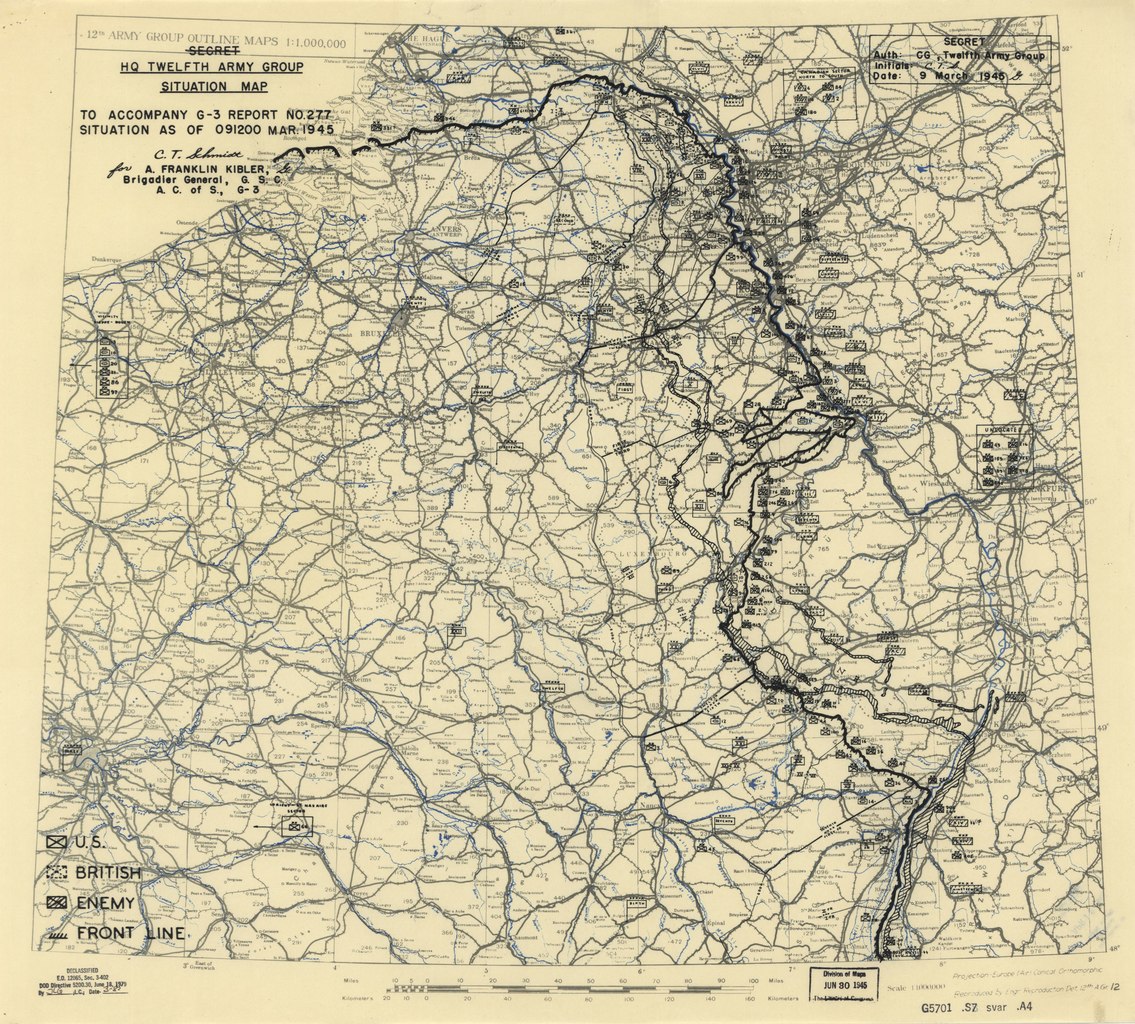 Bonn and Godesberg are captured by units of US 1st Army while others continue to expand the bridgehead over the Rhine River, at Remagen, where Erpel is captured. Farther south, toward Koblenz, US 3rd Army units reach the Rhine at Andernach. Photo: Aerial view of the road leading into Brandscheid (Eifel), Germany, west of Prüm, 9 March 1945, showing anti-tank obstacles ("Dragon's Teeth") of the Westwall ("Siegfried Line") on both sides of the road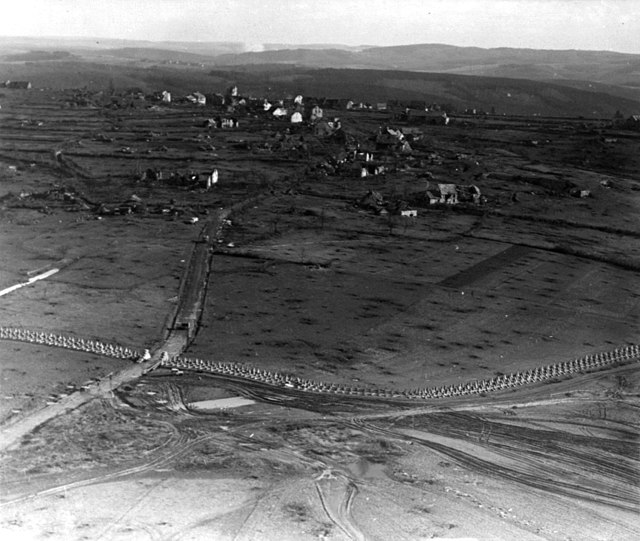 Western Front (1945) - Granville raid Western Front (1945) - Granville raidSubmarine chaser PC-564, outgunned and badly damaged, manages to outrun the German force engaged late on 8 March and is grounded on the French coast at Pierre de Herpin light. French fishing boats arrive to help the wounded, and the next day, PC-564 is towed into St. Malo harbor. Shortly after PC-564 is knocked out of action, German raiding party attacks Granville, demolishing installations, releasing German POWs held there, and sinking small British freighters Kyle Castle, Nephrite, and Parkwood, and Norwegian merchantman Heien. The Germans seize collier Eskwood and tow her to Jersey, in the Channel Islands. German minesweeper M 412 runs aground and is blown up when it is realized that extricating her from her predicament is impossible in the time allowed. Air War over Europe (US Eighth Air Force): 2 missions are flown. Mission 875: 1,045 bombers and 443 fighters are dispatched to hit marshalling yards and industrial plants in Germany; they claim 0-0-2 Luftwaffe aircraft; 7 bombers are lost: 1. 423 B-17s are sent to hit the Ost (150) and Main (222) marshalling yards and a casting plant (38) at Frankfurt visually and using Micro H, H2X radar and smoke markers; 6 B-17s also fly a screening mission; 3 B-17s are lost, 1 damaged beyond repair and 182 damaged; 7 airmen are WIA and 28 MIA. Escorting are 94 of 101 P-51s; they claim 0-0-1 aircraft in the air. 2. 318 of 336 B-17s attack the marshalling yard and a large tank factory at Kassel visually; 6 other B-17s fly a screening mission; 3 B-17s are lost, 2 damaged beyond repair and 188 damaged; 4 airmen are WIA and 28 MIA. The escort is 97 of 99 P-51s; 1 is damaged beyond repair. 3. 282 B-24s are sent to bomb marshalling yards at Munster (97), Rheine (93) and Osnabruck (87) using Gee-H and H2X; 1 B-24 is lost and 52 damaged; 1 airman is WIA and 12 MIA. 47 of 51 P-51s escort. 4. 4 B-17s fly a scouting mission. 5. 141 P-47s and P-51s fly a freelance sweep in support of the bombers; 1 P-51 is damaged beyond repair. 6. 27 P-51s fly a scouting mission. 7. 15 P-51s escort 12 F-5s and 3 Spitfires on a photo reconnaissance mission over Germany; they claim 0-0-1 aircraft in the air. Mission 876: 11 B-24s drop leaflets in the Netherlands, France and Germany during the night; and 2 of 9 B-24s fly CARPETBAGGER missions. (US Ninth Air Force): In Germany, 600+ A-20s, A-26s and B-26s hit 6 marshalling yards, storage and vehicle depots, ammunition-filling plants, and 12 targets of opportunity as part of the interdiction campaign; fighters fly armed reconnaissance, hit special targets, cover the Remagen bridgehead and support the US 9th Infantry and 9th Armored Divisions committed there, support the 4th Armored Division at the Mosel River bridge at Treis, the XX Corps along the Mosel and Saar Rivers, and the XVI Corps along the Rhine River near Wesel. The 125th Liaison Squadron, IX Fighter Command [attached to the XXIX Tactical Air Command (Provisional)], moves from Maastricht, the Netherlands to Monchen-Gladbach, Germany with L-5s; and the 153d Liaison Squadron, IX Tactical Air Command (attached to Twelfth Army Group), moves from Spa, Belgium to Duren, Germany with L-5s. 159 RAF Lancasters of No 3 Group bombed the North and South plants of the Emscher Lippe benzol plant near Datteln. The target area was cloud-covered and G-H was used. The bombing appeared to be accurate but no results were seen. 1 Lancaster lost. 21 RAF Lancasters and 2 Mosquitos of No 5 Group set out to bomb the Bielefeld Viaduct but the raid was abandoned because of low cloud. 92 RAF Mosquitos to Berlin and 16 Mosquitos on nuisance flights over Bremen, Hannover, Osnabrück and Wilhelmshaven, 29 RCM sorties, 12 Mosquito patrols, 21 Halifaxes minelaying in the Kattegat and off Oslo. No aircraft lost. Photo: Aerial oblique view of destroyed buildings in Cologne, Germany, caused by RAF Bomber Command raids on 9 March 1945 Italian campaign Italian campaign (US Fifteenth Air Force): 372 B-17s and B-24s, with fighter escorts, bomb marshalling yards at Graz (2 yards), Klagenfurt, Sankt Stefan, and Sankt Paul, Austria, and Ljubljana, Yugoslavia; river bridges at Sankt Paul are also bombed; 27 P-38s bomb the Knittelfeld, Austria marshalling yard and 13 others strafe the Graz, Austria-Maribor, Yugoslavia railroad lines. Routine supply, reconnaissance, and escort missions continue. (US Twelfth Air Force): In Italy, B-25s hit bridges at San Ambrogio di Valpolicella, San Michele all'Adige, Bozzolo, Santa Margherita d'Adige, Ora, and Montebello, the marshalling yard at Ora, and the bridge approach at Ala; fighters and fighter-bombers attack bridges, railroads, vehicles, trains, supply dumps, parked airplanes, buildings, and other targets over wide areas, including Milan, Cittadella, Ala, Santa Margherita d'Adige, La Spezia, Ghedi, Lecco, and the battle area in the N Apennines. A-20s, on intruder missions during the night of 8/9 Mar, bomb river crossings in the Po Valley at several locations, among them Ostiglia, San Benedetto Po, and Borgoforte. Motor torpedo boats PT-304, PT-308 and PT-313 engage German flak lighters off Point Mesco, Italy, claiming one sunk, one hit, and one possibly hit; PT-304 is damaged by shrapnel during the attack. During retirement, however, PT-308 is damaged when she is accidentally rammed by PT-304. United StatesPhoto: The U.S. Navy high-speed transport USS William J. Pattison (APD-104) underway in the Atlantic Ocean on 9 March 1945. She is painted in Camouflage Measure 31, Design 20L. The photo was taken by a blimp of squadron ZP-11 Pacific War Pacific WarCHINA THEATER (Fourteenth Air Force): In China, 32 B-24s, escorted by 5 P-51s, bomb railroad yards at Sinsiang; 15 B-25s and 2 P-40s knock out 2 bridges at Hwaiyuanchen and E of Jungtse, and hit railroad targets and other targets of opportunity at Yehhsien, Chowkiakow, Hsuchang, and E of Junan; 50+ fighter-bombers on armed reconnaissance attack railroad targets, river and road traffic, bridges, gun positions, and troops at several locations, particularly around Kweiyi, Hengyang, Nanking, and Sinyang. INDIA-BURMA (Tenth Air Force): In Burma, 16 P-47s support elements of the Chinese 50th Division near Mansam; 80+ fighter-bombers operating over and behind enemy lines attack trucks, horses and carts, troops, and artillery pieces. 568 air supply sorties are flown to forward areas. BURMA The southward advance of the British 19th Indian Division reaches the outskirts of Mandalay. Other units of British 33rd Corps are advancing toward the city from the west. The fighting around Meiktila continues as the Japanese bring troops from the Mandalay area in a desperate attempt to free their lines of communications. Photo: Infantry of 19th Indian Division take cover behind a Lee tank during street fighting in Mandalay, 9 March 1945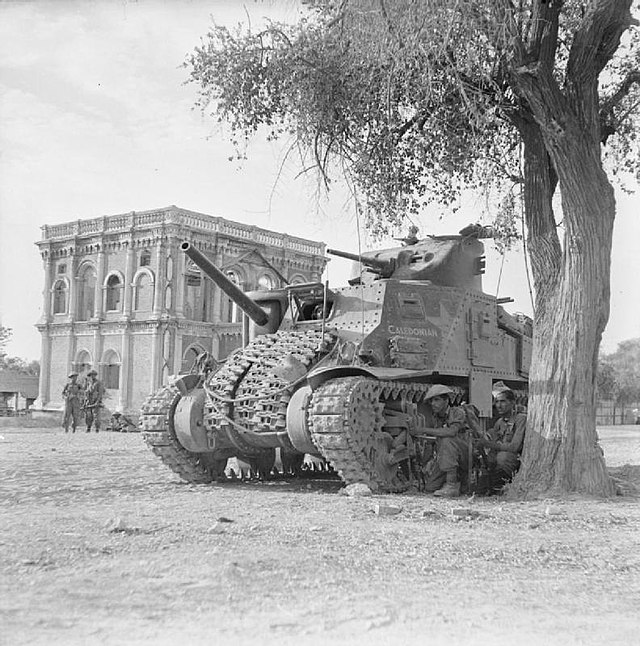 Photo: A 5.5-inch gun of 19th Indian Division in action against the walls of Fort Dufferin near Mandalay, 9 March 1945. Possibly 134th Medium Regiment, Royal Artillery Photo: A 5.5-inch gun of 19th Indian Division in action against the walls of Fort Dufferin near Mandalay, 9 March 1945. Possibly 134th Medium Regiment, Royal Artillery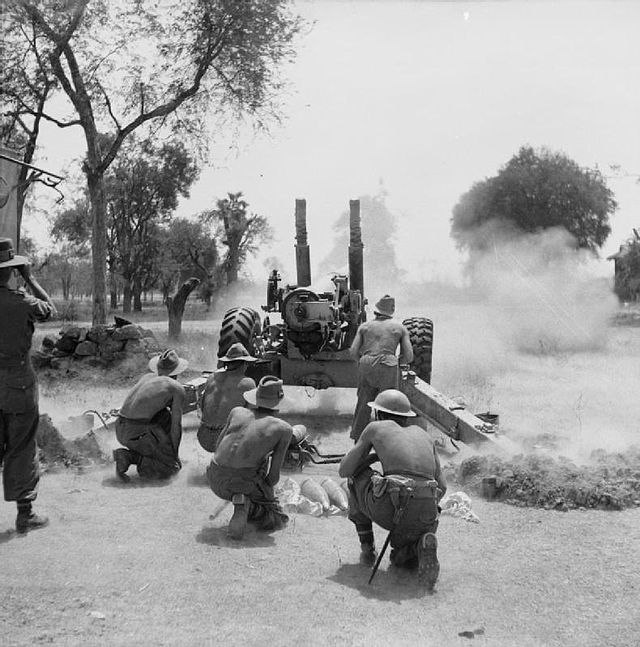 Photo: Troops of 19th Indian Division and a Lee tank in action during street fighting in Mandalay, 9-10 March 1945 Photo: Troops of 19th Indian Division and a Lee tank in action during street fighting in Mandalay, 9-10 March 1945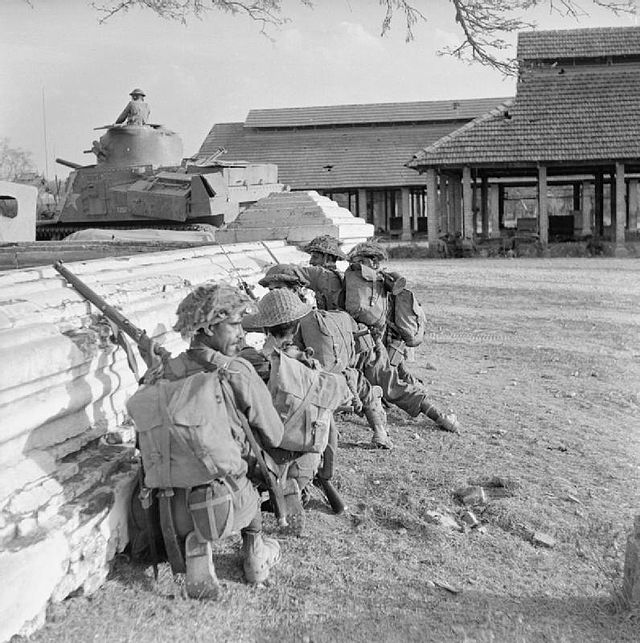 Photo: Sikh troops of 19th Indian Division in action at Fort Dufferin in Mandalay, 9 March 1945 Photo: Sikh troops of 19th Indian Division in action at Fort Dufferin in Mandalay, 9 March 1945 Photo: Lee tanks supporting the 19th Indian Division ready to move forward on Mandalay, 9 March 1945 Photo: Lee tanks supporting the 19th Indian Division ready to move forward on Mandalay, 9 March 1945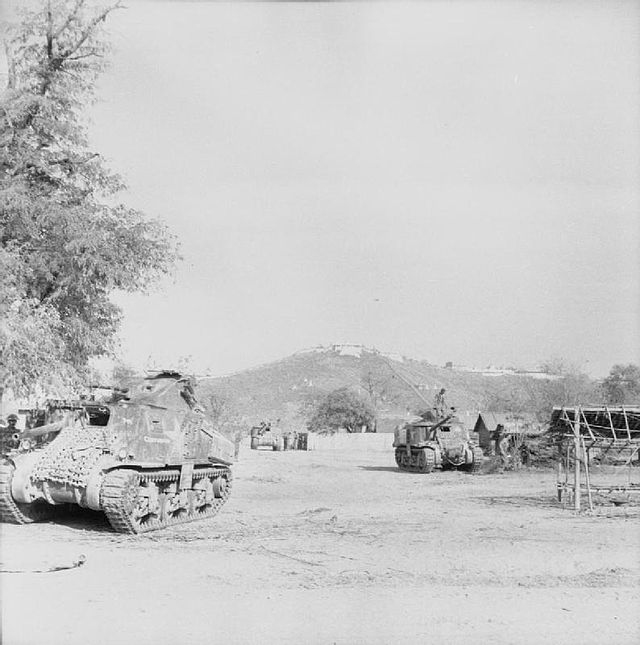 GUAM (Seventh Air Force): 13 Guam based B-24s fly a daylight strike on Susaki Airfield while 5 more on single bomber raids, hit the airfield during the night of 9/10 Mar. 24 Angaur Airfield based B-24s pound the town of Zamboanga on Mindanao. SOUTHWEST PACIFIC AREA [Far East Air Force]: B-24s bomb Zamboanga on Mindanao . B-25s, in cooperation with PT boats, attack targets on Basilan , Philippine s. B-24s hit the Ipo area, B-25s and fighter-bombers support ground forces E of Manila Bay, hit Japanese-occupied areas at Mabiga, Lipa Bay, and Ternate, and bomb and strafe targets of opportunity on Caballo in Manila Bay; B-25s, A-20s, and fighter-bombers hit bridges at Bayombong, the town of Makati, Cabugao, and Cauayan, San Fernando and the Solvec Cove areas on the NW coast, the town of Cauayan, and Aparri Airfield. B-24s pound the dock area at Takao, Formosa. SOLOMON ISLANDS CAMPAIGN Photo: Members of the Australian 4th Field Regiment, Royal Australian Artillery, fire a 25 pounder from Pearl Ridge, Bougainville, March 9, 1945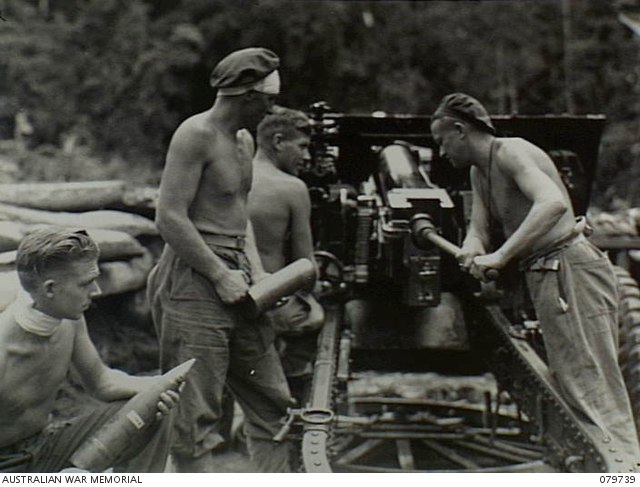 JAPAN US B-29s raid Tokyo with 1650 tons of incendiary bombs. This is the first of many fire bombing raids on various Japanese Cities. This was the XXI Bomber Command's Mission Number 40 flown by the 73d, 313th and 314th Bombardment Wings (Very Heavy). During the night of 9/10 March, 325 B-29s are dispatched from the Mariana Islands to hit the Tokyo urban area; the bombers flew in a stream rather than in bomber formation. The bombers carry neither bomb bay fuel tanks nor guns and ammunition except for the tail turret guns. The bombers departed at sunset and attacked Japan between 0100 and 0300 hours on 10 March; 279 bombers hit the primary target with 1,665 tons of incendiary bombs from an altitute between 4,900 and 9,200 feet. Twenty B-29s hit secondary targets and targets of opportunity. Fourteen B-29s are lost, one to AA, five ditched, one made it back but was scrapped and seven were missing. This is the first of the night fire bomb raids on Japanese cities and results in 15.8 square miles of Tokyo being burned out and an estimated 83,000 Japanese killed. JAPANESE OCCUPIED FRENCH INDOCHINA The Japanese depose the Vichy French administration, forcibly disarm the French garrisons and establish the "Empire of Annam." ALASKA (Eleventh Air Force): 3 B-24s fly a negative shipping search. UNITED STATES NAVY DEPARTMENT COMMUNIQUES, N. D. COMMUNIQUÉ NO. 583, MARCH 9, 1945 1. The PT‑77 and PT‑79 were lost in the Philippine area, having been sunk by one of our own ships. 2. This incident was the result of an error in identification. 3. The next of kin of casualties have been notified. UNITED STATES NAVY DEPARTMENT COMMUNIQUES, N. D. COMMUNIQUÉ NO. 584, MARCH 9, 1945 Far East. 1. United States submarines have reported the sinking of 12 enemy vessels, including an escort carrier and a destroyer, as a result of operations in these waters. The ships sunk were: 1 escort aircraft carrier 1 destroyer 1 large cargo transport 1 large tanker 2 medium cargo transports 5 medium cargo vessels 1 small cargo transport 2. These actions have not been announced in any previous Navy Department communiqué. PACIFIC PB4Y carries out unsuccessful attack on submarine chaser Ch 21, 22°23'N, 115°03'E.
|
|
lordroel
Administrator
Member is Online
Posts: 68,022 
Likes: 49,423
|
Post by lordroel on Mar 10, 2024 6:42:18 GMT
Day 2007 of World War II, March 10th 1945Eastern FrontThe German forces of Army Group South advancing around Lake Balaton encounter heavy resistance from Soviet air and ground forces of 3rd Ukrainian Front and make limited progress. German progress is also hindered by muddy conditions and a lack of fuel for the tanks and other vehicles. Western Front (1945) - Western Allied invasion of GermanyMap: HQ Twelfth Army Group situation map, March 10th 1945 The last German forces are withdrawn from the pocket west of the Rhine between Wesel and Xanten. They have lost heavily to the British and Canadian attacks. The US 1st and 3rd Armies link up near Andernach completing the Allied hold on the west bank of the Rhine everywhere north of Koblenz. Field Marshal Kesselring arrives from Italy to take command of the German armies in the west. Air War over Europe (US Eighth Air Force): 3 missions are flown. Mission 877: 1,374 bombers and 670 fighters attack rail targets in Germany by PFF methods; they claim 2-0-1 Luftwaffe aircraft; 2 P-51s are lost: 1. 376 B-24s are dispatched to hit the rail viaducts at Arnsberg (115) and Bielefeld (114) and the marshalling yard at Paderborn; 10 hit the secondary target, the marshalling yard at Bielefeld; 1 B-24 is damaged. The escort is 146 of 155 P-51s. 2. 526 B-17s are sent to hit the Sud (109), Erfeld (111) and Eving (153) marshalling yards at Dortmund and the Soest marshalling yard (138); 3 other B-17s fly a scouting mission; 1 B-17 is damaged beyond repair and 44 damaged; 2 airmen are WIA. Escorting are 152 of 158 P-51s; 1 is damaged beyond repair. 3. 457 B-17s are sent to hit the Sinsen (89) and Coesfeld (38) rail crossings and the marshalling yards at Schwerte (116) and Hagen (41); 136 hit the secondary, a marshalling yard at Dortmund; 33 others hit Hamm, a target of opportunity; 26 B-17s are damaged; 1 airman is WIA. 98 of 100 P-51s escort; 2 P-51s are lost. 4. 12 B-17s fly a screening mission. 5. 144 P-47s and P-51s fly a freelance support mission for the bombers; they claim 2-0-1 aircraft in the air. 6. 72 of 74 P-51s escort Ninth AF bombers on their strikes. 7. 27 of 28 P-51s fly a scouting mission. 8. 5 P-51s escort 7 F-5s and 4 Spitfires on a photo reconnaissance mission over the Ruhr. Mission 879: 13 B-24s attack the marshalling yard at Munster during the night without loss. Mission 880: 12 B-24s drop leaflets in France, the Netherlands and Germany during the night without loss. The 857th Bombardment Squadron (Heavy), 492d Bombardment Group (Heavy) (attached to 1st Air Division) moves from Harrington to Bassingbourne, England with B-24s (the 857th begins flying weather reconnaissance missions today). (US Ninth Air Force): In Germany, 383 A-20s, A-26s and B-26s strike 5 marshalling yards, a communications center, 2 city areas, miscellaneous targets in the Koblenz-Braubach area, and a target of opportunity; Eighth and Ninth AF fighters escort the bombers, attack ground targets, fly patrols, armed reconnaissance, and provide cover and ground support over the Remagen bridge area where the US 9th Infantry Division expands it's bridgehead against fierce opposition, support the 4th Armored Division in the Koblenz area and the XX Corps in the Saarburg area, and cooperate with the XVI Corps near Wesel. The 33d Photographic Reconnaissance Squadron, 363d Tactical Reconnaissance Group, moves from Le Culot, Belgium to Venlo, the Netherlands with F-5s. 155 RAF Lancasters of No 3 Group carried out a G-H attack on the oil refinery at Scholven/Buer. Photographs taken later showed this to have been a very accurate and effective raid. No aircraft lost. 60 RAF Mosquitos to Berlin, 4 each to Gotha, Jena and Weimar, 35 RCM sorties, 10 Mosquito patrols. No aircraft lost. Italian campaign (US Fifteenth Air Force): In Italy, 191 heavy bombers hit the Verona-Parona di Valpolicella railroad bridge; 1 other bombs the Voghera marshalling yard. Supply missions to Yugoslavia and reconnaissance operations continue. (US Twelfth Air Force): In Italy, A-20s bomb bridges and other communications targets in the E Po Valley during the night of 9/10 Mar; B-25s bomb bridges at Ora, Bozzolo, and San Michele all'Adige, and a railroad fill at the Ceraino railroad station; fighters and fighter-bombers hit communications and targets of opportunity at various locations in the E Po Valley, including several bridges, and numerous ammunition dumps and vehicles. Battle of the MediterraneanField Marshal Albert Kesselring ceases to be Commander-in-Chief Armed Forces South (Mediterranean). Battle of the Indian OceanSubmarine Rock (SS-274) rescues the last 15 survivors from U.S. freighter Peter Silvester, sunk on 6 February by German submarine U-862 (see 13 February). RomaniaStalin returns Transylvania to Romania. United States Roosevelt informs Spanish representatives that no American aid will be forthcoming so long as the Franco dictatorship continues. Photo: The U.S. Navy landing craft repair ship USS Minotaur (ARL-15) underway off Pensacola, Florida (USA), on 10 March 1945. She is painted in Camouflage Measure 31, Design 20L, although the colours of many panels seem to differ from the panels in the drawing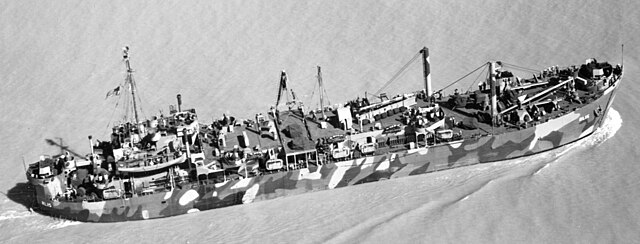 Pacific War Pacific WarCHINA (Fourteenth Air Force): 32 B-24s blast the railroad yards at Tsanghsien and Tehsien; 10 B-24s and 4 P-40s attack Siangtan and nearby targets of opportunity; 60+ fighter-bombers hit river, road, and railroad targets, gun positions, warehouses, airstrips, and troops around Sinyang, Yiyang, Changsha, Kiyang, Yoyang, Hengyang, Hankow, and Wuchang. (Twentieth Air Force): Mission 43: 24 of 29 B-29s bomb the marshalling yard at Kuala Lumpur; 1 of the B-29s drops over half of its bombs at Alor Star Airfield and another attacks a freighter in the channel leading to Port Swettenham. 3 others attack Khao Huakhang, Thailand. INDIA-BURMA (Tenth Air Force): 13 P-47s support forces of the British 36 Division in the Mogok area; 46 P-47s and P-38s sweep the roads S of the bomb line; 49 others hit supply areas behind the enemy lines, attack a bivouac near Nam-yang, and bomb a truck park N of Mong Yai. 537 air supply sorties are flown to forward areas. BURMA Photo: A Burmese family living in a dug-out share tea with a British soldier in Meiktila, 10 March 1945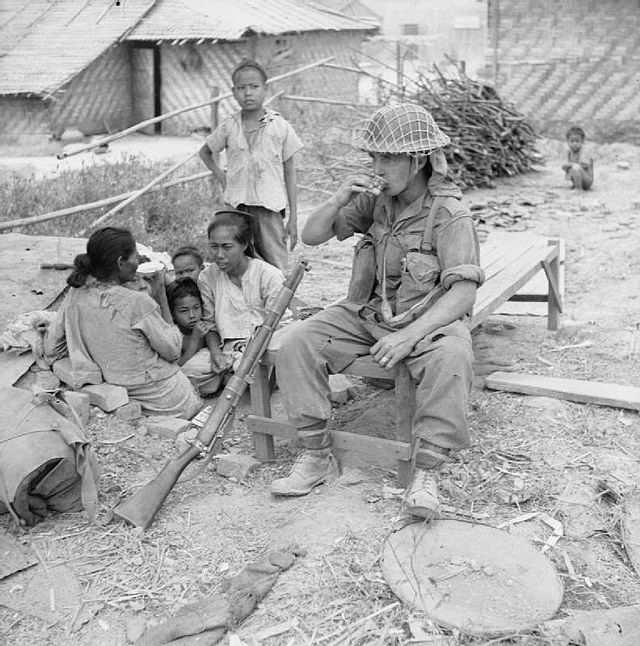 Photo: Lee tanks and infantry of 19th Division moving into Mandalay, 10 March 1945 Photo: Lee tanks and infantry of 19th Division moving into Mandalay, 10 March 1945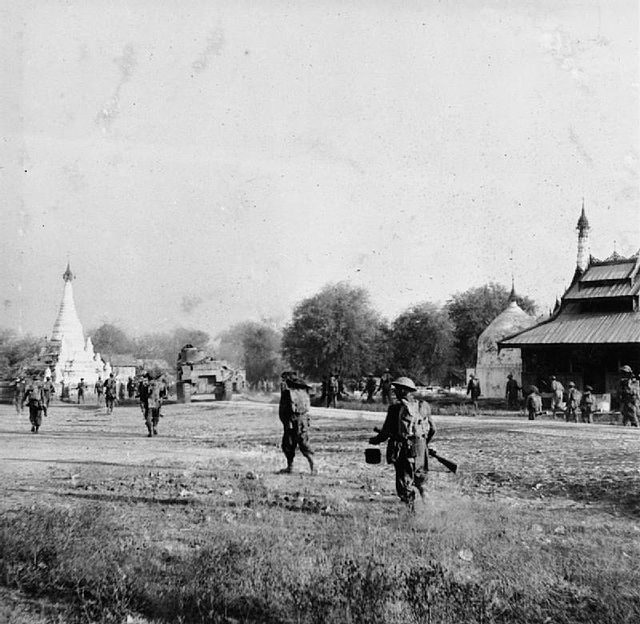 Photo: Among the pagodas on Mandalay Hill, historic heart of Burma's second city, Indian troops of 19th Division open fire on a Japanese strongpoint, 10 March 1945 Photo: Among the pagodas on Mandalay Hill, historic heart of Burma's second city, Indian troops of 19th Division open fire on a Japanese strongpoint, 10 March 1945 GUAM (Seventh Air Force): 10 B-24s from Guam hit Susaki Airfield which 9 B-24s again hit during the night of 10/11 Mar on separate snooper strikes. 23 B-24s from Angaur Airfield bomb Calarian Airfield on Mindanao. (Twentieth Air Force): Mission 40: During the predawn hours, 279 B-29s, of 325 airborne, blast the Tokyo urban area with incendiaries, destroying 267,171 buildings, about one-fourth in the city, killing 83,793 and wounding 40,918 people and destroying 15.8 square miles; this death total is the highest of any single day's action during the war, exceeding the deaths caused by the first atomic bomb on Hiroshima; 20 other B-29s bomb alternates and targets of opportunity; 14 B-29s are lost; the participating B-29s are from the XXI Bomber Command's 73d, 313th, and 314th Bombardment Wings (Very Heavy) the raids are flown at levels ranging from 4,900 to 9,200 feet. JAPANESE OCCUPIED FRENCH INDOCHINA Japan declares Vietnam to be independent. This increases the anti-colonial feeling that would leave the region war-torn for the next quarter century. PHILIPPINE CAMPAIGN (1945) TG 78.1 (Rear Admiral Forrest B. Royal) lands Army troops (41st Infantry [Reinforced] less 186th RCT) near Zamboanga, Mindanao; landing is supported by naval gunfire and USAAF planes. Japanese shore batteries, however, sink tank landing ships LST-591 and LST-626, and infantry landing craft LCI-710 and LCI-779. Attacking troops encounter only light mortar and artillery file. On Luzon fighting continues south of Laguna de Bay where the US forces are still trying to break through to the east. Organized Japanese resistance on the island of Palawan comes to an end. Photo: Troops of the 162nd Infantry, 41st Division under mortar fire are waiting for orders to move up to Wolfe Airstrip, Zamboanga, Mindanao, 10 March 1945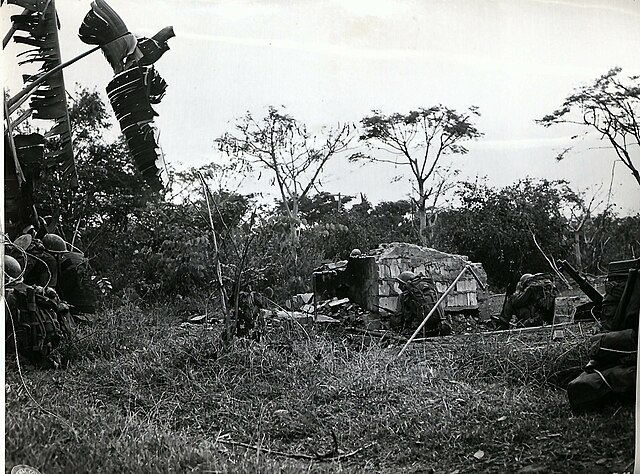 Photo: Troops of the 162nd Infantry, 41st Division waiting to move up while under mortar and artillery fire about 100 yards from Wolfe Airstrip, Zamboanga, 10 March 1945 Photo: Troops of the 162nd Infantry, 41st Division waiting to move up while under mortar and artillery fire about 100 yards from Wolfe Airstrip, Zamboanga, 10 March 1945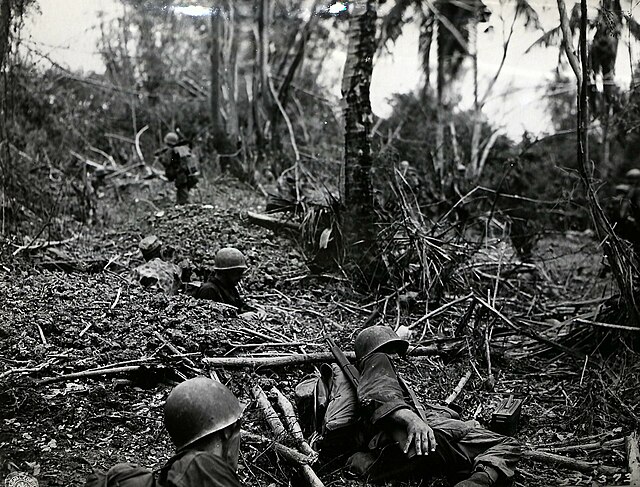 Photo: American troops of the 162nd Infantry Regiment, 41st Division, advance 200 yards from the Wolfe airstrip on the southwest tip of the Zamboanga Peninsula, Mindanao, 10 March 1945 Photo: American troops of the 162nd Infantry Regiment, 41st Division, advance 200 yards from the Wolfe airstrip on the southwest tip of the Zamboanga Peninsula, Mindanao, 10 March 1945 On Mindanao, B-24s and B-25s over the Zamboanga Peninsula area bomb the town of Zamboanga, Calarian Airfield, Pangasahan, Port Holland, Kulibato Point, and Sibago. B-24s bomb the Ipo area and Aparri Airfield; B-25s and A-20s support guerrillas near San Fernando and bomb Cabugao; fighter-bombers hit Caballo in Manila Bay, bomb the town of Minanga, hit enemy concentrations at Burgos, near Ft Stotsenburg, in Batangag Province, and at other locations, and attack Teresa. B-24s bomb Kudat and Jesselton Airfields. ALASKA (Eleventh Air Force): 5 B-24s radar-bomb targets at Kataoka on Shimushu, and Suribachi and Kakumabetsu on Paramushiru with unobserved results; 1 fighter is sighted but no attack is made; 2 other B-24s on this mission abort due to weather and mechanical trouble. B-25 missions to the Hayakegawa River and Paramushiru are also cancelled due to weather. UNITED STATES NAVY DEPARTMENT COMMUNIQUES, CINCPOA COMMUNIQUÉ NO. 293, MARCH 10, 1945 During the night of March 8‑9, the enemy attempted infiltration of Marine lines on Iwo Island on a large scale and subjected troops in the Fourth Division sector to heavy mortar and sniper fire. The Fourth Division destroyed 564 of the enemy while repulsing these attacks. A general advance was made on the island on March 9, with forward elements of the Third Marine Division reaching the northeast beaches early in the afternoon. Gains up to several hundred yards were made against very stiff resistance. Army fighters based on Iwo Island joined carrier aircraft in providing close support for the troops and fleet units continued to shell the enemy. Heavy artillery preparation was directed onto enemy positions prior to attack by the Infantry. On March 10, the Marines continued their attack and widened the area held on the northeast beaches of Iwo Island by noon. Resistance during the morning appeared to be diminishing although the enemy continued to hold prepared strong points tenaciously and snipers were active. A small group of enemy aircraft approached Iwo Island in the early morning hours of March 9, but retired without attacking. Targets in the Palaus were bombed by fighter and torpedo aircraft of the Fourth Marine Aircraft Wing on March 8‑9. Mitchells of the Fourth Marine Aircraft Wing strafed and bombed small craft and buildings at Kusaie and Ponape in the Eastern Carolines on March 8. Army Liberators of the Strategic Air Force, Pacific Ocean Areas, bombed the airfield on Chichi Jima in the Bonins on March 8 and 9. On March 9, Navy search Privateers of Fleet Air Wing Two bombed runways and other installations on Wake Island. UNITED STATES NAVY DEPARTMENT COMMUNIQUES, CINCPOA COMMUNIQUÉ NO. 294, MARCH 10, 1945 The Marines on Iwo Island continued to drive forward on the afternoon of March 10. By 1800 the Fourth Division had made substantial advances along most of its front and one of its patrols had reached the beach on the easternmost point of the island. Enemy resistance appeared to be decreasing at numerous points along the lines. Army and Navy aircraft continued to attack enemy positions and fleet surface units provided close gunfire support. Corsair fighters of the Fourth Marine Aircraft Wing bombed and strafed docks, small craft, and defense positions on Ponape in the eastern Carolines on March 10. PACIFIC Submarine Segundo (SS-398) sinks Japanese merchant cargo ship Shori Maru off Shori Island southern Korea, 34°25'N, 127°54'E. PBM-3D (VPB 28) attacks Japanese convoy in South China Sea, sinking water carrier Wayo Maru about 40 miles southeast of Macao, 21°31'N, 112°28'E. USAAF B-25s bomb Japanese shipping off Tourane, French Indochina, sinking motor sailships Kinsei Maru, Namikiri Maru and No.3 Hinode Maru. Japanese merchant trawler Koko Maru is sunk by USAAF mine in Yangtze River, 31°22'N, 121°34'E.
|
|
















































































































































